Better Sailing


Full Keel Vs Fin Keel On Sailboats
There are many types of keels, but the main two categories are Full and Fin Keels. Traditionally, cruising boats had a full keel, and that made them very stable in the water. This design prevailed for decades until the industry began to realize the emergence of a new type of consumer, the weekend vacationer, or sailor. For this new client, those high benefits were not a priority because rarely, if never to say, would he move away from the coast.
What is the Keel For?
Sailboats have keels to reduce the amount of slippage to leeward (the opposite side of the boat the wind is coming from). In essence, the keel of a sailboat has the function of compensating the action of the wind on the sails, preventing dejection, converting that force into thrust, and making the ship stay on course. As a general rule, the heavier and deeper a keel is, the more stable a boat is.
Full Keel or Fin Keel?
Each keel shape has advantages and disadvantages, you will never have the “perfect” keel for your boat. But, the best keel for you and your boat completely depends on the style of sailing that you are planning on doing.
Full Keel Sailboats
Although full keels are by far the least efficient design, they offer incredible strength and versatility. If we want to explore new waters in which we could run aground, or travel offshore, a complete keel will keep our backs better than any other. One thing is certain though, a full keel will never fall off your boat as a fin keel can.
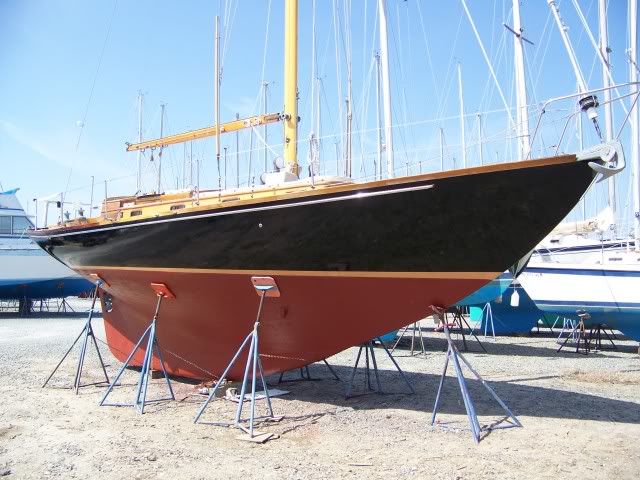
Full Keel Advantages:
- Handles better in tough weather
- Better directional stability
- Maneuver well in downwind conditions
- Better for offshore sailing and ocean passes
- Their movements are softer to be more in tune with the movement of the sea itself.
- Since the full keel runs through the entire hull, the forces exercised on it are transferred to a very large area, so it is often said that they are more robust.
- Thanks to their shape, they respond better to an impact against the bottom than a boat with fin keel, which could be seriously damaged.
- The rudder and propeller are more protected against a possible collision.
- If you stranded with a complete keel sailboat, the forces will be well distributed, the damage will be (in theory) minimal and your biggest concern (although not small) will be to see how to get the boat out of there.
- More stable when sitting still at anchor
Full Keel Disadvantages :
- Slower compared to a fin keel boat
- Handles poorly in winward conditions
- Usually more cramped than fin keeled boats.
- The turning radius is larger, which makes maneuvering in tight spaces difficult, and turning them with a weak wind can be difficult.
- You have to help more with the engine, which translates into increased wear and an increase in fuel consumption.
Fin Keel Sailboats
The fin keel is, by far, the most common type in modern sailboats. A fin keel is a flat, narrow and hydrodynamic piece located under the hull. Unlike the running keel, it is not an integral part of it but is screwed to it. To compensate for the relatively small ballast it provides, the fin keel is usually deeper.

Fin Keel Advantages:
- They are faster than full keel boats
- They maneuver better
- Better for daysailing
- Less resistance to rudder rotation
- Short turning radius
- They usually fit better with tight schedules, such as weekend cruises.
Fin Keel Disadvantages :
- Less robustness and have to be repaired sooner.
- They offer less lateral resistance, which can lead to a strong and sudden heel when a wave or gust of wind hits the boat.
- They do not keep their course as well as a full keel boat and demand more effort and attention at the helm.
- The rudder is more exposed and is more vulnerable to shock and material fatigue. In this sense, an important variation of the rudder is the rudder with skeg. The skeg is a sturdy element that offers support and protection to the rudder.
- If we are stranded with a sailboat with a fin keel, we can find cracks or fissures at the junction of the keel with the hull.
Full Keel Vs Fin Keel – Summary
It is said that fin keels are made to outrun a storm and full keels ara made to weather a storm. So, a full keel sailboat will be slower but more stable during bad weather where a fin keel will be faster but more unstable. A fin keel boat will not have a problem sailing during a storm and you will make it out just fine but you will not be as comfortable or “safe” as in a full keel boat.

Your choice also has to do with the length of the boat you will buy. A very small boat will benefit from a full keel and heavy displacement in terms of seaworthiness and safety. However, a small boat with these characteristics will be a slow one. If speed and time are not your concerns then maybe a full keel is a better match for you.
Like so many things in sailing, there are many tradeoffs in this particular choice, and only you can decide what’s best for you.
So, as you can understand, there not a clear winner in this competition. The answer to this question really does depend on what is the purpose of the boat’s design and your individual needs. Will you be using your boat to cruise, make passages, offshore cruising, offshore racing, coastal racing, etc? You first need to answer these questions and get a boat the checks most items on your “wish list”.
Peter is the editor of Better Sailing. He has sailed for countless hours and has maintained his own boats and sailboats for years. After years of trial and error, he decided to start this website to share the knowledge.
Related Posts

Sailing with Friends: Tie Knots, Navigate the Seas and Create Unforgettable Memories

Atlantic vs Pacific: Which is More Dangerous for Sailing?

The Ultimate Guide to Choosing the Best Fishing Line for Trolling

Lagoon Catamaran Review: Are Lagoon Catamarans Good?
- Buyer's Guide
- Destinations
- Maintenance
- Sailing Info
Hit enter to search or ESC to close.

What are the pros and cons of different keels?
We all sail for different reasons, in different cruising grounds and use our yachts differently, so it makes sense that there is no one-size-fits-all keel design. At Sirius, however, we like to make the perfect yacht for each individual owner. One of the ways we serve our customers is our choice of keels – at least six different options for each model. It’s one of the ways we stand out – or should that be stand up?
We offer three styles of keel: fin, twin and lifting swing keel. All of our keels excel in many ways, but every design does have drawbacks – this is not unique to Sirius, but the keel affects the way you use the boat, so it’s important to choose the right one for you.
These are the keels we currently offer:
Standard Fin (310DS, 35DS, 40DS) Performance Fin (310DS, 35DS, 40DS) Medium Fin (310DS, 35DS, 40DS) Shallow Fin (310DS) Shallow Twin (310DS, 35DS, 40DS) Performance Twin (35DS, 40DS) Lifting Swing Keel (310DS, 35DS, 40DS)

Does the choice of keel compromise ocean capability?
For Sirius yachts, absolutely not. It’s important to realise that choosing one keel style over the other does not affect the yacht’s righting moment or compromise its ocean-going capabilities at all!
Whichever keel you choose, deep or shallow, twin or fin, they all have the same stability. This is achieved by putting more weight in the bulbs of the shallower keels as the shorter lever can be balanced with higher weight. Most of the blue water cruising and circumnavigations in Sirius Yachts have been made with twin-keel or reduced/shallow fin keel yachts.

Does keel choice affect performance?
As our shallow keels are heavier the weight dampens the yachts’ motion at sea, but as a downside, you have more weight to move with sails or engine. Once you’re moving there isn’t a difference but when tacking or gybing, or when not steered well, you will lose a bit in sailing performance. The shallower draught yachts also lose a few degrees to windward compared to their deeper keeled sisters, but they are still good all-round performers. Our customers with racing backgrounds always try to go for a keel as deep and light as their sailing area permits, either with a single or twin keel.

Pros and cons of fin keels
The standard keel on our yachts is a fin keel. Most sailing boats today use a fin keel because it gives a good all-round performance on all points of sail. By keeping the ballast lower it gives the most comfortable motion. The main downsides are that the draught (the depth of water required to stay afloat) is the greatest, and it’s very important to avoid running aground on a falling tide. Fin keel boats cannot dry out without additional support, either from a harbour wall or by fitting a pair of beaching legs. Some fin keel yachts are not built strongly enough to stand on their keels when out of the water, so they can’t dry out alongside a harbour wall and they need to be kept in a special cradle when stored ashore to avoid the risk of the hull deforming under its own weight. By contrast, all Sirius yachts can stand on their keels for any length of time with no problem at all.
We offer four types of fin keel. The standard fin is available on the 310DS, 35DS and 40DS and is fully cast-iron. It offers the best value, good performance, and excellent responsiveness. It is the deepest of our fixed-keel options, so if you want less draught you may want to look at our other fin keels.
We also offer a performance fin keel for all our models. This uses a cast iron fin with a lead bulb at the tip (bottom). The structural strength of cast iron means the fin is the slimmest profile, but lead is denser than iron so the same volume of lead will weigh around 1.4 times more than cast iron, giving more righting moment. The heavier, softer lead down low has less volume in the bulb so achieves a slimmer profile with less drag and therefore better performance.
A lead bulb is also safer if it hits something. Lead can absorb 60% of the energy in flexing and deformation so that only 40% of the force will be transferred to the laminated structure of the keel reinforcement. A lead bulb is very forgiving and easy to reshape and will not start to rust where the coating is damaged. We can use less volume of lead than iron, and achieve better stability than a wholly cast-iron keel. We can also reduce the depth of the keel and retain excellent stability. However, lead is more expensive than cast iron and the bulb must be attached very securely to the iron fin, so this option does cost more.
If you want less draught, we also offer a medium fin. This reduces the draught of the 310DS and 35DS by around 40cm/1ft 4in and 55cm/1ft 9in on the 40DS. Like the performance fin, it uses a cast iron fin with a lead bulb. To retain the keel’s grip in the water it has to have a longer chord (the distance from fore to aft). While this gives the boat better directional stability, it does make her a little less responsive and a little slower to manoeuvre.
On our 310DS, we offer a shallow fin option – a special version for very shallow cruising grounds. This fin keel offers the least draught of any of our fixed keel options at 1.15m/3ft 9in and draws 10cm/4in less than the twin keel version. The keel has a significantly longer chord (2.24m/7ft 4in compared to 0.7m/2ft 3in of the standard keel) so she has the reassuring directional stability of a long-keeled yacht but with better manoeuvrability.

Pros and cons of twin keels
Our twin keels are the most popular option. About 70-80% of all Sirius Yachts are delivered with them – and on the 40 DS it’s 90%. Some folk still believe there is a big performance penalty with twin keels. In the past this used to be true but it’s no longer the case with modern twin keel designs, from Sirius at least. We have conducted many two-boat comparison tests, often battling for hours, by ourselves, with owners, and for sailing magazines and we have found that there may only be one or two boat lengths of difference at the end of a long windward leg, if at all. At the end of many of these comparison tests, the crews could not point out which of the boats had the twin keel.
If you cruise tidal areas, twin keels will reward you time and time again. Not only do they give you a shallower draught than the typical fin keel, they also give you the ability to dry the yacht out, whether that’s for a motion-free night’s sleep, to explore cruising grounds others cannot reach, or just for cheaper mooring and maintenance costs.

We offer two styles of twin keels; performance and shallow draught. Both options have a cast iron fin with a lead bulb. The performance keels have a deeper draught and a thinner chord so they act and feel a bit livelier when sailing and manoeuvring. The shorter keels have a longer chord, but give you the ability to navigate shallower areas. Like all keel designs, twin keels do have some downsides. They are more expensive than fin keels, and when you’re sailing fast in choppy seas at a steep angle of heel, you can occasionally get a slapping sound when an air pocket is caught and pressed out under the windward fin. Lastly, we’ve yet to meet an owner who enjoys antifouling between the keels. Thankfully it only has to be done once a year and with twin keels you might get away with doing it less frequently. A twin keel yacht can be kept on a drying mooring, where fouling is reduced because the hull spends more time out of the water. And when you’re off cruising it’s easy to give the bottom a quick scrub while the yacht is dried out.
Our yachts will happily sit on their keels on a hard surface, like a drying grid, or for winter storage but on softer surfaces we use the rudder for additional support. The rudders on our twin keel yachts are specially reinforced for this: we use a Delrin sheave to take the weight of the hull and the tip of the rudder has a wide, foil-like foot to spread the weight.

A lifting swing keel
We are one of a few manufacturers to offer a lifting swing keel. There’s a lot of confusion with the term ‘lifting keel’, it seems to encompass all yachts that have centreboards, variable draught, lift-keels or swing keels. To us, a lifting keel boat should have all the ballasted weight of the boat in the keel, and that keel needs to be retracted into the hull.

Technically, a lifting keel is a keel that can be lifted or lowered and gives the boat the ability to dry out when the tide goes out. A lift-keel is a ballasted keel that raises and lowers vertically. A swing keel has a ballasted fin that has a single pivot point and the keel swings up into the boat. There are other variants of design, for example some have a lifting keel to reduce the draught of the vessel but they cannot dry out on it, others have a ballasted keel and ballasted grounding plate. All these examples have a keel that does two things: keep the boat upright and stop her sliding sideways. Our swing keel is designed with a NACA profile to give the most efficient performance.
Centreboard yachts have a centreplate to provide grip in the water and reduce leeway. The plate may carry only 15-20% of the ballast but the rest of the yacht’s ballast is within the hull and/or in the grounding plate. This is called an “integral keel” and is more common as it’s less complicated to build. The lower a yacht’s ballast is located, the better her stability, the more comfortable her motion and the better she stands up to her sail area. The most efficient place for the ballast is as low down on the deepest keel possible – this is why race boats have deep skinny keels with large torpedo-shaped bulbs on the bottom, but they don’t make practical cruising sailboats.
Our keel designs have more weight in the tip (bottom) – using a bulb on the fin and twin keel design and flaring the lower sections on our lifting swing keel yachts. You don’t have this with centreboard and integral keel yachts.
It might be surprising, but a lot of owners come to us thinking that a lifting swing keel is the best option for them. Sometimes it is, but about 98% of customers who approach us because we offer swing keels end up sailing away on a twin-keel Sirius.

The downsides of a lifting keel
A lifting swing keel does give you more cruising options. It will lift should you run into something and, of course, it gives you the shallowest draught. But that difference is only 40-50cm (1ft 4in to 1ft 8in) less draught than our shallow twin keel option. The lifting keel increases the complexity of the build and the final cost of the yacht; it also sometimes limits the internal layout and engine drive options, and you need to have twin rudders too. Twin rudders make the boat less manoeuvrable in a marina – you can opt for a third central rudder which does improve the handling, but again comes at an extra cost.
On the lifting swing keel, 40 and 310 owners are restricted to the use of a shaft drive, which is less efficient and you have to accept a bit more noise and vibration. When drying out, the drive is more vulnerable to damage, whereas it’s totally clear when taking the ground on twin keels. With twin keels, you also do not have to worry about something sticking out of the beach or stones lying around because the hull is high above the ground. With the hull up high, you do not have to dig a hole in the sand and slide down on your stomach to check or change your anodes as you would on a swing keel.
Sailors who are attracted to the idea of a lifting swing keel should carefully consider the pros and cons to compromise the least. When owners understand the repercussions of choosing a lifting keel yacht, many of them feel it restricts their options too much. They could have a lifting keel or they can sail with twin keels, dry out, have better close-quarters handling and save money in the process. Unless you need the shallowest possible draught – 0.75m (2ft 5in) on the 310DS, 0.9m (2ft 11in) on the 35DS or 0.95m (3ft 1in) on the 40DS – a twin keel might well be a better option.

How are the keels attached?
The design of the keel is important but the way they are attached is just as important, if not more so. All of our fixed keels are through-bolted. Every keel has a wide flange at the root (top) of the keel and the flange sits into a reinforced recess in the hull. The flange and the recess work together to spread the loads of the keel/s into the yacht’s hull. The keels are bonded and bolted to the hull. We use up to twelve 20mm and 24mm bolts (per keel) and these go through rolled stainless steel backing plates inside the hull to spread the bolt loads evenly into the fully laminated keel grid which goes all the way up to the chainplates and also carries the mast support.
For our lifting swing keel, we laminate a substantial keel box as part of the hull to accept the keel and the hydraulic mechanism needed to retract the keel into the hull. Unlike most other boatbuilders we don’t use a grounding plate to take the weight of the yacht, our yachts sit on the length of the leading edge of the keel. Integral keels with the majority of the ballast in the grounding plates move the ballast (weight) from low down in the keel to inside the hull. This negatively affects the stability as the more weight you have lower down, the better.
We also don’t like grounding plates because they bring the hull in contact with the ground. By leaving 10-15 cm (4-6in) of the keel out of the hull when it’s retracted, most of the time the hull is kept clear of the beach and anything that could damage it.
The problem with too much form stability
With only 15-12% of their ballast in the centreboard, most lifting-keel yachts cannot rely on keel weight for stability so their hulls need to be designed with extra form stability instead. This means the hull sections have to be much wider and flatter. A flat-bottomed hull is not what you want for a comfortable ocean cruising yacht; it isn’t sea-kindly or easy to steer in waves and gusty winds conditions. We don’t make that compromise at Sirius. With all the ballast in the swinging part of our swing keel design, we can use the same seaworthy, ocean-capable hull shape designed for our yachts with fixed keels.
If you don’t know which keel would be best for your Sirius, contact us to discuss the type of sailing you intend to do, where you want to sail and what your cruising aspirations are.
General Manager – Torsten Schmidt SIRIUS-WERFT GmbH Ascheberger Straße 68 24306 Plön/Holstein
Fax: 0049 – 4522 – 744 61-29
Receive regular updates from Sirius Yachts
Subscribe to our email newsletter
Privacy Overview
- New Sailboats
- Sailboats 21-30ft
- Sailboats 31-35ft
- Sailboats 36-40ft
- Sailboats Over 40ft
- Sailboats Under 21feet
- used_sailboats
- Apps and Computer Programs
- Communications
- Fishfinders
- Handheld Electronics
- Plotters MFDS Rradar
- Wind, Speed & Depth Instruments
- Anchoring Mooring
- Running Rigging
- Sails Canvas
- Standing Rigging
- Diesel Engines
- Off Grid Energy
- Cleaning Waxing
- DIY Projects
- Repair, Tools & Materials
- Spare Parts
- Tools & Gadgets
- Cabin Comfort
- Ventilation
- Footwear Apparel
- Foul Weather Gear
- Mailport & PS Advisor
- Inside Practical Sailor Blog
- Activate My Web Access
- Reset Password
- Pay My Bill
- Customer Service

- Free Newsletter
- Give a Gift

How to Sell Your Boat

Cal 2-46: A Venerable Lapworth Design Brought Up to Date

Rhumb Lines: Show Highlights from Annapolis

Open Transom Pros and Cons

Leaping Into Lithium

The Importance of Sea State in Weather Planning

Do-it-yourself Electrical System Survey and Inspection

Install a Standalone Sounder Without Drilling

When Should We Retire Dyneema Stays and Running Rigging?

Rethinking MOB Prevention

Top-notch Wind Indicators

The Everlasting Multihull Trampoline

How Dangerous is Your Shore Power?

DIY survey of boat solar and wind turbine systems

What’s Involved in Setting Up a Lithium Battery System?

The Scraper-only Approach to Bottom Paint Removal

Can You Recoat Dyneema?

Gonytia Hot Knife Proves its Mettle

Where Winches Dare to Go

The Day Sailor’s First-Aid Kit

Choosing and Securing Seat Cushions

Cockpit Drains on Race Boats

Rhumb Lines: Livin’ the Wharf Rat Life

Re-sealing the Seams on Waterproof Fabrics

Safer Sailing: Add Leg Loops to Your Harness

Waxing and Polishing Your Boat

Reducing Engine Room Noise

Tricks and Tips to Forming Do-it-yourself Rigging Terminals

Marine Toilet Maintenance Tips

Learning to Live with Plastic Boat Bits
- Sailboat Reviews
A Look at Sailboat Design: Fin Keels vs. Full Keels
Details like keel design count when considering cruising sailboats..

Photos by Ralph Naranjo
When a keel tears away from a sailboats hull, it makes the loss of a rig or rudder seem like a minor inconvenience. History shows that its an uncommon occurrence, but because we now annually hear of such incidents, weve decided to take a closer look at keels and see what keeps the ballast where it belongs.
The International Sailing Federation (ISAF) Offshore Special Regulations devotes pages to helping sailors prevent and respond to a crew overboard incident. There is nothing about how to handle the loss of a keel or ballast bulb. Some might say this is because such occurrences are so infrequent, while others note that, if youre still upright once the ballast breaks off theres not much you can do other than blow the sheets, douse the sails as quickly as possible and attempt to stop any leaks.
When solo sailor Mike Plants Open 60 Coyote lost her lead bulb in 1992, Mike was lost at sea. Other adventure-sailors have survived near instantaneous capsize precipitated by keel loss. In 2003, round-the-world racer Tim Kent and his crew capsized when Everest Horizontal lost its ballast on the way back from Bermuda. US Sailing Safety at Sea Committee Chairman Chuck Hawley was aboard the racing sloop Charlie, on the way back from Hawaii, when a loud groaning sound led to a deep heel as the lead peeled away from the keel bolts and ballast headed straight to the bottom. This encounter at least had a happy ending thanks to the crews quick actions to douse sail. Apparently the keel had been cast with too little antimony (an additive that causes lead to become a harder alloy). The point here is that keeping the keel attached is as important as keeping the crew safely on board. And for the offshore monohull sailor, preventing a keel loss, like preventing crew overboard, requires some informed forethought.
A ballast keel on a sailboat is a classic example of potential energy poised in a balancing act. The buoyancy of the hull itself offsets the effect of thousands of pounds of lead or iron. At rest, gravitys attraction for the dense material strains against the buoyancy of the hull, and the adjacent garboard region is continuously in tension. Few sailors spend much time contemplating how keel bolts corrode and what cycle-loading does to the resin matrix comprising the garboard region just above the ballast. What is apparent, is that the attachment material, whether it be wood, metal or fiber reinforced plastic (FRP), must be able to support a mass of metal weighing as much as a small truck-and do so day in and day out for decades.
Underway, every tack causes the rig and sailplan to try to lever this ballast package free from the hull. And when the helmsman starts daydreaming about lobster for dinner and wanders off course onto a granite ledge Down East, the keel designed to handle sailing loads takes it on the chin. Its easy to see why experienced designers and builders lose sleep over their decisions about keel shape, structure, and what kind of safety factor should be built into the structure.
Its surprising to discover that with better materials and computer-aided design, we still hear about incidents such as the Rambler capsize in the 2011 Fastnet Race (PS, May 2012). Just as significant is a spate of smaller race boat keel-ectomies that have caused ISAF to send out a cautionary note to sailors around the world, and introduce new structural standards for race boats. Keeping the ballast attached to the boat involves an awareness of a chain-like set of failure points. And one of the most difficult decisions each designer must make is how to marry foil efficiency with a structural safety margin that covers the boats intended usage and the unintended use of the keel as a depth sounding device.
For decades, engineers and naval architects have had to contend with some racing sailors Icarus-like quest-a trend that prioritizes shedding weight and making the keel foil a long, thin appendage with a high-aspect ratio. Though not quite a flight toward the sun with wings made of wax and feathers, some race-boat scan’tlings walk a fine line between lightweight and structural failure. The challenge lies in attaching a lead bulb on a high-tensile steel foil to a lightweight, high-modulus, FRP hull. Interconnecting the dense metallic ballast to the lower-density foam/fiberglass hull structure is a true engineering puzzle. Part of the challenge lies in the dissipation of point loads (confined to a relatively small area) and how to handle the resulting stress risers. A stress riser is the point at which theres an abrupt change in a materials flexibility, such as where a stiff, fin keel meets the more elastic hull bottom. In FRP composites like those found in a balsa-cored hull, stress risers are a likely place for delamination to occur. Over time, these can result in the failure of the FRP composite.
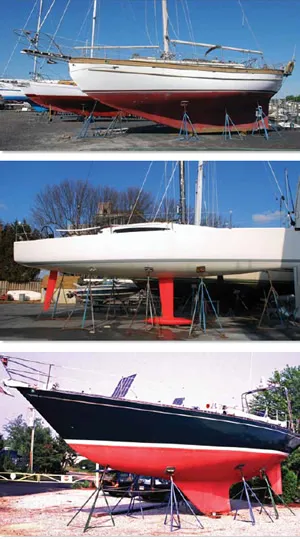
The see-saw effect of the keel counteracting a vessels righting moment is a mathematically predictable energy transfer. Even the effect of groundings such as those that turn hull speed into a dead stop can be quantified. But its the cumulative effect of fatigue (localized structural damage caused by cyclical loading) and corrosion that are harder to pin down.
The term allision refers to hitting a fixed object such as a granite ledge or coral reef. Naval architects analyze the energy transfer and evaluate the stress and strain characteristics that occur. The recognition that the keel-to-hull connection must endure even more punishment than is doled out in heavy-weather sailing episodes is at the heart of how structural specs are devised.
Designers also must consider the jack-hammer-like pounding of a keel on a reef in surf, and realize that there are limits to the abuse a keel and hull can endure. With this in mind, its reasonable to assume that sailboat keels should be built to handle sailing induced loads for decades. It is the extra safety factor built into the boat that defines what happens when the sandbar is a rock pile.
What is harder to anticipate are the unusual encounters that can inflict serious damage to the keel connection. Take, for example, what happens when a sailboats deep fin keel is wedged in a rocky cleft and a good Samaritan with a big powerboat attempts to pivot the sailboat using a line attached to the bow. The distance from the keels vertical centerline to the stem may be 20 feet or more, and with a couple of thousand pounds of bollard pull, the 20-foot lever arm creates a rotary force that can spike to 40,000 foot-pounds or more. This level of torque goes well beyond what most designers and builders model as sailing loads, and its likely to seriously damage the boat.
In plain low-tech talk, extreme fin keels provide a valuable performance edge, but they come with their own set of downsides that every owner needs to be aware of. In essence, the more radical the keel shape, the better the crew must navigate.
A couple of decades ago, PS Technical Editor Ralph Naranjo ran a boatyard and had a client who liked to cut the corners during Block Island Race Week. His first spinnaker reach into a granite boulder stopped the boat and shoved the companionway ladder upward six inches. This underscored how an allision that causes the keel to stop abruptly transfers a shock wave through the entire hull. The resulting compression cracked several transverse members in the New York 40 and damaged the core in the canoe body near the garboard.
The FRP repairs had to be tapered and all delamination problems resolved. The moderate-aspect-ratio lead fin keel absorbed a good deal of the blunt trauma. Judging from the cannonball-size dent on the leading edge of the lead keel, it was clear that the impact was significant. The dent offered grim proof of the advantage of having soft lead instead of steel as keel ballast. New floor frames were added, the broken transverse members were replaced, and the boat was off and sailing.
The next season, the boat had another Block Island encounter, and only because the Petersen-designed New York 40 was a pretty ruggedly built boat was a second repair even considered. This time, an equally violent keel-to-hull trauma came from an on-the-wind encounter with a different rock. The extent of the delamination was greater than it had been in the first go round, and more extensive core removal and repair was required. The keel was dropped in order to check the bolts and the garboard. With the bilge fully opened for the FRP repair work, the repair crew made a pattern of the canoe body dead rise and fore and aft contour. As the glass work was being completed, they fabricated a stainless-steel grid that would spread keel loads fore and aft as well as athwartship. The new grid reinforced the keel attachment and returned the sloop to the race course.
Afterward, Naranjo and the owner discussed the details of the repair, including the possibility of hidden, widespread damage from the two groundings. These included the dynamic loads imposed upon the chainplates and rigging, the likelihood of hidden resin-cracking, and potential for more delamination and core shear linked to the torque induced by the accident. In short, any serious allision causes overt and hard-to-detect damage far from the actual impact zone, and these can lead to more problems down the road. When buying a used boat, look for a good pedigree, but also look for signs of previous blunt-force trauma. A good surveyor will be skilled in such structural forensics, and he or she will do more than comment on the gelcoat shine.
In the early days of wooden ships and iron men, a lack of dense metal ballast put less point-loading in the garboard region of the hull. Bilges free of cargo were filled with rocks or tighter-fitting granite blocks cut for more compact stacking. The principal of ballasting a vessel was to lower her center of gravity (CG) and create both an increase in the righting arm and a greater righting moment to offset the heeling moment created by the rig and sail plan. The keel also helped lessen leeway and would evolve into an appendage that added lift.
Movable ballast had a few downsides, not the least of which was its propensity to move in the wrong direction at the very worst moment. Even small boat sailors have found out what can happen to unsecured pigs of lead ballast when the boat heels far enough over for gravity to overcome friction. Whether stones, lead, movable water ballast, or a can’ting keel are used to augment the boats righting moment, a sailor must anticipate the worst-case scenario. This is when the weight ends up on the leeward side of the boat and a bad situation can turn into a real catastrophe. Fixing or locking ballast in place, controlling the volume of water put in ballast tanks, and limiting the can’ting keels range are sensible compromises.

Internal ballast, the ballast inside a keel envelope thats contiguous with the hull, is still seen in many new boats. Island Packet is an example of a builder has stuck with this traditional approach of securing ballast without using keel bolts. Its a sensible design for shoal-draft cruisers, and the upsides are numerous. These high-volume, long-range cruisers arent encumbered by the demands prioritized by light displacement, performance-oriented sailors. Instead, Island Packets combine a rugged laminate and a long-footed, shallow-draft keel. This may not place the lead or iron ballast as deep as the tip of a fin keel, but it does keep the all-important CG low enough to deliver a powerful righting moment along with shoal draft.
In order to deliver the high angle of vanishing stability (AVS) also known as limit of positive stability (LPS), designer Bob Johnson puts what amounts to an internal bulb in the very lowest point in the boat. This long slug of iron or lead (depending on the model) is then covered by Portland cement, locking it in the Island Packets monocoque structure. The result is a contiguous FRP structure spreading keel loads efficiently over a considerable amount of hull skin. Keel bolts and the infamous garboard seam are completely eliminated. This approach to sailboat keel design dates back to the Rhodes Bounty II and other prototypes in the production world of sailboats. Now over 50 years old, many of these boats continue to have a tenacious grasp on the lead or iron that they hold.
Encapsulated iron ballast is much less desirable than encapsulated lead, and its sad to see builders skimp on this. Iron, or even worse steel, has been used in many Far Eastern encapsulated keels. It works as long as water and the resulting oxidation havent caused expansion and cracking of the seal. Lead is also denser than ferrous metal, and therefore, the same amount of ballast will have a smaller volume and create less drag.
Encapsulated ballast starts to be less appealing as keels become more fin-like and high-aspect ratio. The reason for this is that the geometry of the support changes, focusing more load on less area of the hull. As hull shapes evolved into canoe underbodies with hard turns in the bilge, and fin-like keels became thinner, deeper, and with shorter chord measurements (thickness), the concept of encapsulated keel became impractical. The Cal 40, Ericson 39, Pearson 365, and a long list of similar genre boats signified the end of an era when performance racer/cruisers would be built with encapsulated ballast.

External Ballast
Performance-oriented sailors and race-boat designers quickly latched on to hull shapes marked by deep-draft, foil-shaped, high-aspect ratio fin keels. From the late 60s to whats currently glowing on CAD screens in designer offices around the world, keels have grown deeper and shorter in chord length, and bulb or anvil-like tips have grown more and more common.
The design development was sound, lift was enhanced, and deeper-not longer-became the answer to getting to windward faster. The challenge was not only in designing an efficient shape, it lay in creating an attachment means that minimized foil flex and twist, retained the low drag coefficient, and still had the ability to withstand an occasional, albeit modest, grounding.
During this same period, marine surveyors and boatyard techs began to see moderate groundings result in major structural problems. The classic example was the allision that produced a moderate dent in the lead at the leading edge of the keel tip. In many cases, further inspection revealed cracks radiating outward from a knot meter or depth sounder mistakenly placed just ahead of the keel. An even closer look often revealed grid damage or a cracked bulkhead just aft of the last keel bolt. Like the New York 40 mentioned earlier, this was a result of a shock wave radiating through the hull structure. As we learned in Mrs. McCrearys science class, Bodies in motion tend to stay in motion, unless acted on by an equal and opposite force. Fin keel sailboats encountering abrupt energy transfers,tend to endure more damage than their long-keel counterparts.
A forensic look at the Achilles heel of external ballast highlights a few pitfalls. First the good news: Lead absorbs impact well, consuming much of the imparted energy through deformation. However, the translation of the remaining energy from the metal keel foil and keelbolts into an FRP hull is where we often find stress risers, and point loading linked to material and hull shape changes. The near right-angle interface between a modern sailboats canoe body and its deep fin keel is a classic load-path hotspot. In the old days, fiberglass techs spoke of oil-canning or the dimpling of a large section of the garboard as tacks were swapped.
Today Naval Architects use Finite Element Analysis (FEA) to better engineer hull structure. Colorized graphics pinpoint load concentration, glowing bright red in the region where the keel joins the hull, the epicenter of the oil-canning. A common solution to coping with this high-load focal point, is to eliminate core in the region and to gradually increase the unit schedule (layers of FRP), or to add an internal FRP grid. Maximum thickness of a keel stub is located where the keelbolts penetrate the stub. In this region, the solid glass thickness is often equal to the dimension of the keel bolt diameter or even greater.
Laminate thickness at the keel bolts is only part of the equation. Just as important is how the transition to the general hull laminate transpires. A bullet-proof keel stub that immediately transitions into a core hull comprising two units of laminate on each side of the panel creates whats equivalent to a tear-on-the-dotted-line weakness. Transitions that involve sharp angles and marked differences in panel strength require a well-reinforced taper that spreads loads gradually rather than abruptly.
Occasionally, we see massive metal frameworks used in the bilge as support for keel bolts; these structures need to be carefully engineered to not create the same hard spot fracture points. When carefully tapered in order to gradually introduce more flex, the problem is abated, as it was in the repair of the New York 40 mentioned earlier. The stainless-steel grid built to support the keel loads incorporated a gradual decrease in stiffness to the framework. The keel was carefully mated to the underside of this grid to ensure full contact (See Keel Bolt Repair Options, online). As a result, the crew relieved the hard spots at the end points and made the transition to the more flexible FRP hull less dramatic.
For cruisers, the take-away lesson is that extra reinforcement, a long garboard keel-to-hull interface, and internal transverse and longitudinal reinforcement really do pay off. Keep in mind that the extra weight this entails is all below the center of gravity and contributes to the secondary righting moment as well as keeping the water out.
This is a big departure from the way many modern production boats are built. They carry a skimpy ballast ratio of 30 percent or less, have less structure to support the keel and are not designed to handle unintended cruising consequences. There are exceptions, and its worth looking at the keel design and structure of the Navy 44 Mark II and the USCG Leadership 44 (see PS, August 2012). These boats utilize external ballast and are examples of rugged keel attachment. They have a relatively long keel-to-stub garboard junction, the laminate scan’tling meets American Bureau of Shipping recommendations, and both utilize an overabundance of 316 stainless-steel keel bolts and an FRP grid to keep the keel where it belongs.
There are many reasons why were seeing more keel problems today. On one hand, light, fast, race-boat design pushes the envelope, and thats probably OK. But when mainstream racer/cruisers start to suffer from lead loss, too much of one good thing (high-aspect ratio) and too little of another good thing (reinforcement) can begin creeping into design and construction.
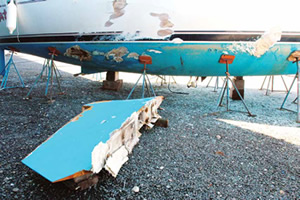
RELATED ARTICLES MORE FROM AUTHOR
Leave a reply cancel reply.
Log in to leave a comment
Latest Videos

Island Packet 370: What You Should Know | Boat Review

How To Make Starlink Better On Your Boat | Interview

Catalina 380: What You Should Know | Boat Review
- Privacy Policy
- Do Not Sell My Personal Information
- Online Account Activation
- Privacy Manager

- Sails & Canvas
- Hull & Structure
- Maintenance
- Sailing Stories
- Sailing Tips
- Boat Reviews
- Book Reviews
- Boats for Sale
- Post a Boat for Sale
- The Dogwatch
- Subscriptions
- Back Issues
- Article Collections
- Free for Sailors
Select Page
Keel design: What’s best?
Posted by Ted Brewer | Boat Reviews
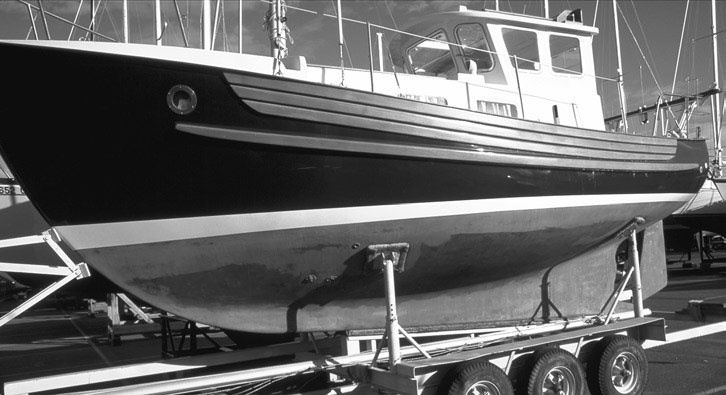
Ted Brewer reviews the ins and outs and ups and downs of keel design
The purpose of a keel, fin, or centerboard is to provide resistance to making leeway; in effect, to keep the yacht from sliding sideways through the water due to wind pressure on the sails. Various shapes of underwater plane have been in and out of style over the past 150 years.

The highly stylized shark fin has extreme rake and a sloping tip chord.
The basic full-keel shape had the longest run, as it was the standard for bluewater sailing craft from pre-Roman times to the earliest days of yachting. The deep, full keel was supplemented in the mid-1800s, for the shoalwater areas of Britain and North America, by centerboard craft. These cover such working types as the sharpies, Cape Cod catboats , and Chesapeake Bay oyster skiffs, to mention a few.
The first truly modern keel yacht, with a cutaway forefoot and highly raked rudder post, was designed by Capt. Nathanael Herreshoff with his Gloriana design of 1891. But it did not catch on for bluewater sailing. Until the late 1920s, the typical offshore yacht, whether cruiser or ocean racer, resembled a sailing fishing craft in the shape of its lateral plane: a long, full keel with deep forefoot and fairly vertical sternpost. Such a shape has the benefits of good directional stability, ease of steering, and the ability to heave to in heavy weather, all desirable traits for a boat. However, its faults may include slowness in stays, excess wetted surface making it slower in all types of air and an inefficient lateral plane shape that has excess leeway, considering its relatively large area. Typical small yachts of this type are seen today in the Colin Archer types and the Tahiti ketch and its copies, while replicas of traditional sailing craft such as Bristol Channel Cutters, Friendship sloops, fishing and pilot schooners, and similar lovely vessels still appear in our waters. Fortunately, many of these workboat types have been developed to the point where the ills of the true full keel have been greatly reduced. Then the result is a handsome cruiser that sails quite well and attracts a great deal of attention wherever she drops her hook.
Successful Sailboat Keel Types
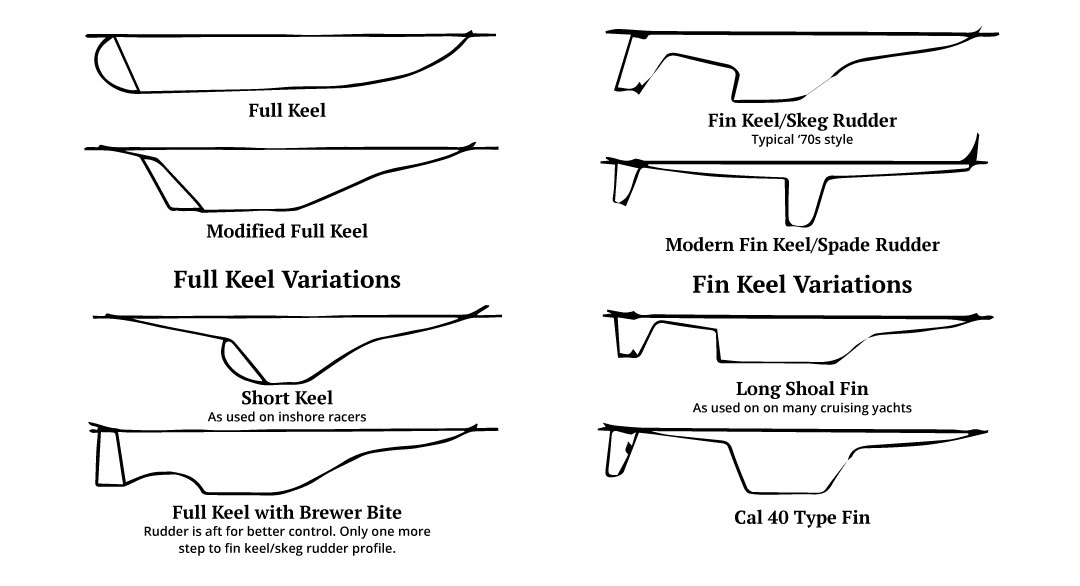
The cutaway keel was revived for ocean racing by Olin Stephens in the late 1920s, with his lovely yawl, Dorade, still sailing and winning classic yacht races more than 70 years after her launching. Her offshore racing successes finally proved that the full keel was not essential to seaworthiness, and it definitely detracted from speed and weatherliness. As a result of its improved performance and handiness, the “modified full keel” form caught on quickly once Dorade showed the way and became the standard for the next 35 years. This type of lateral plane is still sailing in many popular older designs such as the Albergs, the Folkboat, the Luders 33, the Whitby 42, and even some newer yachts.
The modified full-keel form features generally good handling and directional stability plus reduced wetted surface, compared to her true full-keel sister. The yachts can perform well in all conditions and, as they are generally of heavier displacement than contemporary ballasted-fin boats, they do not give away much in light air, despite the added wetted area. A yacht with a modified full keel can sail right up with the best of them if she is given sail area commensurate with her typically heavier displacement.
In my own work, I developed a modified full keel, with the rudder set aft and vertically in the contemporary fashion, in order to improve directional stability and handiness. Then, to reduce wetted area, the lateral plane is substantially cut away ahead of the rudder in what some have termed “the Brewer bite.” The Cabot 36 and Quickstep 24 of my design were early examples of this form. The size of the cutout depends to a large degree on how insistent my client is on having a “full keel,” and I try to make the cutout as large as I can decently get away with. I don’t claim to have originated the shape, though, as the late L. Francis Herreshoff used a not dissimilar profile many years earlier in the design of the lovely 57-foot ketch, Bounty.
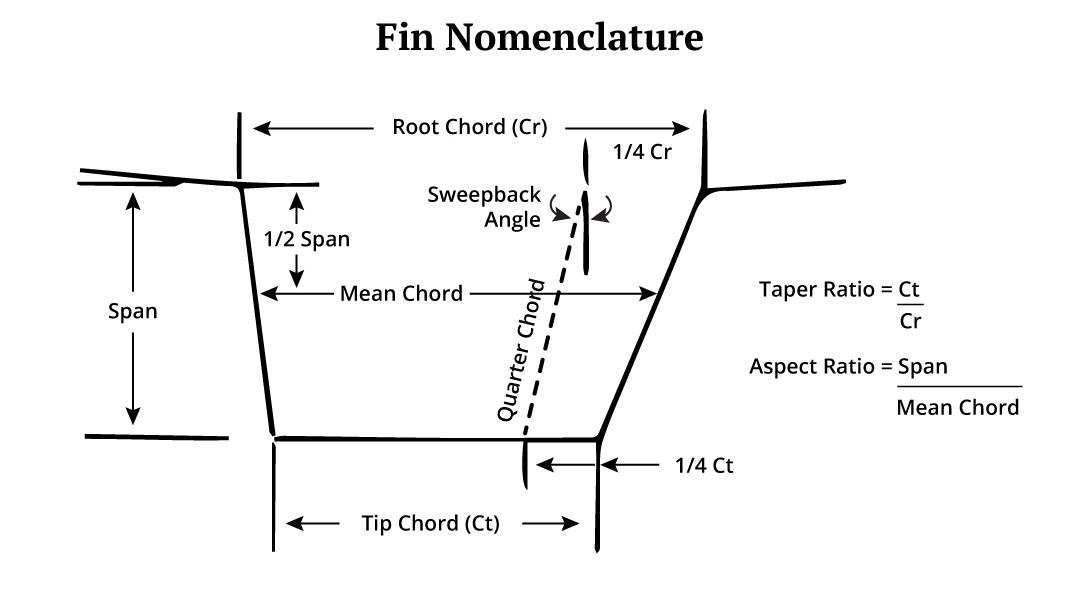
Taken to Extremes
Like all good things, the modified full keel was cut away more and more for bluewater and inshore racers in an attempt to reduce wetted area until, finally, some designers took it to extremes. This reduced directional stability and produced craft that were almost impossible to steer in breezy conditions, broaching with monotonous regularity. I can recall working on the design of many short-keel 5.5-Meter yachts in the 1960s, and we always said they were three-man boats with six-man spinnakers! It’s hard to believe none of them were knocked down and sunk, as they were extremely difficult to control on a reach or run, and the hulls were pure leadmines, with 3,500 pounds of ballast in their very short keel and only 1,000 pounds of wood and rig above it!
Olin Stephen’s genius began another fad in the mid 1950s, the keel-centerboard design. After Finisterre showed the way, keel-centerboard yawls were built in sizes from 24-foot midget ocean racers, to the largest offshore yachts, in order to take advantage of favorable ratings under the CCA rule and emulate Finisterre’s record of wins. The keel-centerboard hull has gone out of fashion now, but the type still has merit where a stable, beamy, shoal-draft yacht is desired with little sacrifice of weatherliness or seaworthiness. Indeed, the Bill Tripp-designed Block Island 40 and Bermuda 40 are keel-centerboard ocean racers from the old school and have been in production for more than 30 years now. These classic yachts have made many long ocean voyages, including several world circumnavigations and are first-class bluewater cruisers in every respect.
Keel Types Here to Stay

A rather squared-off fin, not unlike the Cal 40 keel.
The fin shape is not new either, as ballasted fin yachts were pioneered by Herreshoff at the turn of the century for inshore racing. Then, due to excesses and bad design, the shape died out, except for a few one-design classes, until Bill Lapworth dropped a bomb on the ocean-racing scene in the mid-1960s with his Cal 40 design. The Cal 40s made believers out of many yachtsmen who could not believe that a ballasted-fin/spade-rudder yacht was a serious bluewater ocean racer. After wins in the Trans-Pac, many East Coast races, and the 1966 Bermuda Race, it became evident that the fin was here to stay for ocean-going and coastal cruising yachts. Please note that I do not use the term “fin keel” anymore, as I feel it is a misnomer. The keel is the structural backbone of the vessel, and the fin hangs from it. Fish have both backbones and fins; so do yachts.

A less extreme fin keel, with a more parallel tip.
A well-designed fin, in conjunction with a skeg-hung rudder, can provide excellent directional stability, handiness, reduced wetted area and improved weatherliness. The fin/spade rudder combination reduces wetted surface even more. It may have a little (or a lot) more sensitive helm than a fin/skeg rudder yacht, but it has one big advantage over it and all other forms of lateral plane: it can be steered in reverse under power. This can make life a great deal easier in today’s crowded marinas, as many have discovered.
These are some of the reasons that we see fins on the great majority of our new yachts today; they are not simply a fad. There are good fins and bad fins, of course, and it is not always easy to tell them apart. The shape of fins over the years has been limited only by the designer’s imagination. Fins have been set at every angle from the vertical to highly raked aft. They have been deep and narrow, shoal and long, resembling a shark’s fin or whale’s tail, or boxy fins similar to the original Cal 40 design.

A contemporary bulb fin with winglets.
Major Problem
A very deep, narrow fin can be a problem to haul on a marine railway, so the cruising skipper should consider haulout ease when boat shopping. A crane or travel lift is the best method for hauling yachts with extreme fins, but may not always be available in out-of-the-way areas. There is also the danger of damage to the shaft or strut if slings are improperly positioned. Still, the major problem of the high-aspect-ratio fin is structural strength, as it can impose extreme loads at the point of attachment to the keel. Indeed, some years ago I was an “expert witness” in a court case concerning three men who drowned when their yacht sank as a result of its fin tearing off when the vessel ran aground.
The cruising skipper would do well to avoid yachts with extreme fins, both for considerations of haulout ease and structural strength. Fortunately, the heavier, deeper hull and generally shoaler draft of the typical cruising yacht mean there is less height available between the bottom of the hull and the point of maximum draft. So, a longer, lower-aspect-ratio fin is the only solution. On the other hand, the racing sailor will want a fin with an aspect ratio as high as the draft rule will allow. Such a fin is more efficient per square foot, so the area can be smaller and the wetted surface reduced. In Aero-Hydrodynamics of Sailing, C.A. Marchaj recommends about 4 percent of the sail area as a good guide for fin area, and I feel the cruiser should err on the high side, as a small increase in resistance is preferable to increased leeway. On the other hand, I have used as low as 1.75 percent area with good results on an extreme racer with a fin of 2.75 aspect ratio.
Sailboat Keel Aspect Ratios
This “aspect ratio” is the ratio of the span (depth) squared to the fin area; that is, my extreme fin had an 11-foot span and 44 square feet of area, so its aspect ratio was 121/44, or 2.75. If it had a 4-foot span with 44 square feet of area, not uncommon proportions for a cruising yacht, its aspect ratio would be 16/44, or a low 0.3636.
The aspect ratio can also be described as the span divided by the mean chord, the average fore-and-aft length of the fin, and this gives the same result.
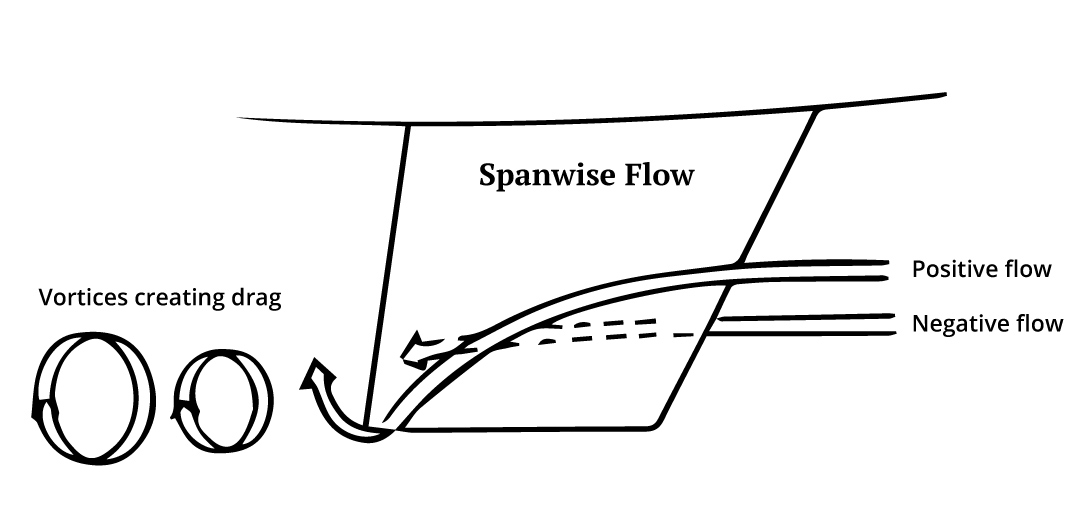
A large part of the resistance of a keel is created by the vortices, similar to miniature whirlpools that form when the water flows across the bottom of the keel from the high-pressure (leeward) side to the low-pressure (windward) side. It requires energy to form those vortices and that energy is then not available to propel the boat forward. Obviously, the shorter the keel or fin tip, the smaller and weaker those vortices will be, and that translates to reduced resistance. This is one reason that racing yachts usually feature high-aspect-ratio fins with short tip chords.
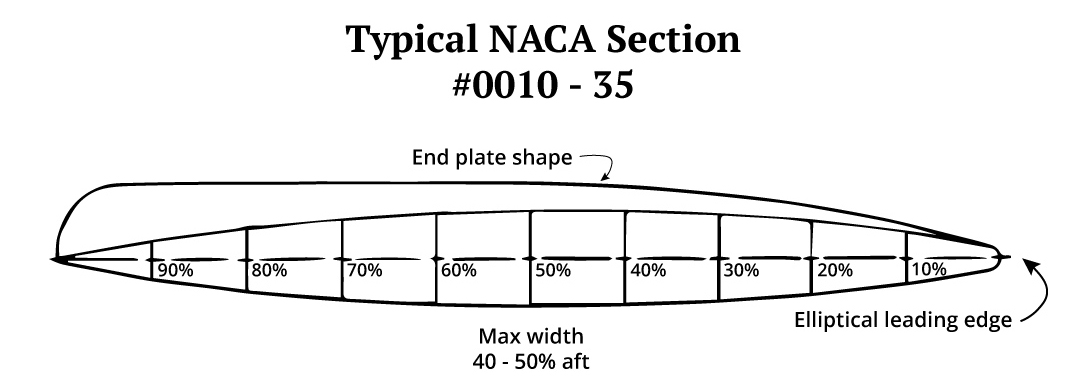
However, the formation of vortices can be greatly reduced by using end plates, or wings, to change the flow direction and eliminate crossflow. My own preference, for a fin of average span, is for an end plate that is but a few inches wider than the maximum width of the fin bottom. We tested an actual yacht with such an end plate on one side only and noted a substantial improvement in performance when she was heeled so that the end plate was on the leeward side. Where the draft is shoal and the fin span is on the small side, then a wider end plate, or even a wing, might prove beneficial. However, a wide wing can be a structural weakness, particularly if the boat goes hard aground and has to be towed off, or pounds on the rocks for any length of time.
Sweepback Angles
In the 1970s, I saw more than one very-high-aspect-ratio fin with tremendous sweepback angle. This certainly gives an impression of speed but, as Marchaj pointed out, tank tests have shown that the sweepback angle can be related to the aspect ratio: the higher the aspect ratio, the more vertical the fin should be. Indeed, the very-high-aspect-ratio fin on my BOC racer was set absolutely plumb until a hard grounding set the tip back a quarter inch or so, the result of taking a yacht with a 13-foot draft through a channel dredged to 11 feet! Most cruising-yacht fins are of low aspect ratio, of course, so should have substantial sweepback, up to 57 degrees, with an aspect ratio of 0.5, according to Marchaj. Although most designers try, it is unfortunate that obtaining the perfect sweepback angle is secondary to locating the fin to balance the sailplan, as well as fitting the ballast at the correct spot for proper fore and aft trim. The taper ratio (tip chord length/root chord length) also deserves consideration. Tests on one series of fins showed that a fin with 0.32 taper ratio was 1 percent more efficient than an untapered fin and had very slightly less resistance. This is a small difference but cannot be ignored by the racing skipper. Again, the reduction in drag may be due to reduced vortices from the shorter tip chord. Marchaj also states that the taper ratio should be reduced as the sweepback angle increases. However, the very-low-taper-ratio fins may not be the best solution for a cruising yacht. The tip chord should be long enough so the vessel can be hauled on a marine railway with no major problems. Too, on a moderate-draft cruising yacht, a short tip chord forces the ballast higher, so stability can suffer.
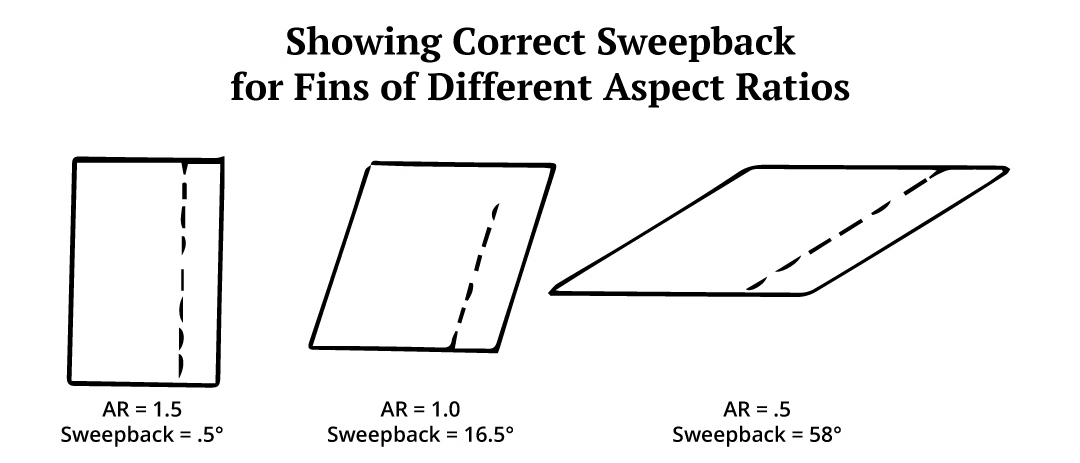
Lower Ballast
Another consideration in the fin profile is whether the tip chord is sloped down aft or parallel to the waterline. The parallel tip chord makes good sense. It allows the ballast to be lower for added stability, it eases blocking up the boat when hauling and, fortunately, tests have shown that it is also superior to the sloped tip chord in other ways. Having the aft edge of the tip chord deeper than the leading edge has no practical effect on aspect ratio, and such a fin develops less lift and more drag than one with a parallel tip.
The National Advisory Committee for Aeronautics (NACA) tested a large variety of streamlined shapes for lift and resistance and the information on these is available in a book, Theory of Wing Sections, by Abbot and Von Doenhoff. These are the shapes that designers refer to when they say their new magic fin has an NACA section. Generally, the shape selected will be similar to NACA 0010-34 or 0010-64 series. The leading edge will be elliptical, as a blunted nose increases resistance while a pointed leading edge promotes stalling. The maximum width will be about 40 to 50 percent aft, and the shape will be streamlined to a fairly sharp (but not razor-sharp) trailing edge. The thickness ratio will be 0.8 to 0.12 of the chord length, although this may be increased to 0.15 to 0.16 at the tip chord. There are advantages to having an increase in thickness ratio at the tip chord, including being able to fit the ballast lower. This need not mean that the fin is bulbed, though. For example, a fin that is 8 feet long at the root and 5 feet long at the tip may have a 0.10 thickness (0.8 feet) at the root and 0.15 thickness (0.75 feet) at the tip. The fin is still slightly thinner at the bottom than at the top, but the thickness ratio has increased.
Increased Resistance
It is not uncommon to see fins wider than 10 to 12 percent of their length, as the designer may need to fatten the fin in order to locate the ballast in the correct spot for proper trim. Very shoal-draft boats may require fatter keels or fins in order to get the ballast as low as possible for stability. Still, extra width does increase resistance so there is a tradeoff; added stability increases performance while a thicker fin reduces performance. Thirty-five years ago, when I worked for Bill Luders, we tank-tested dozens of 5.5-Meter models. These very short-keeled 30-foot sloops had a minimum keel width of 4 inches under the rule, and whenever we tried a model with a wider keel in order to get the ballast lower, we found that overall performance suffered.
We also tested a number of bulb keels on the 5.5 models but they never proved out in the tank, either, although several different shapes were tried. Then, in the late 1970s, I tank-tested the model of the new Morgan 38 at Stevens Institute, first with a fairly fat NACA fin in order to maintain the desired 5-foot draft, and then with a patented bulb fin that we let its designer draw up, with no stipulation on draft. The bulb saved only 2 inches of draft but showed so poorly against the NACA fin that the 38 was put into production with the more conventional shape.
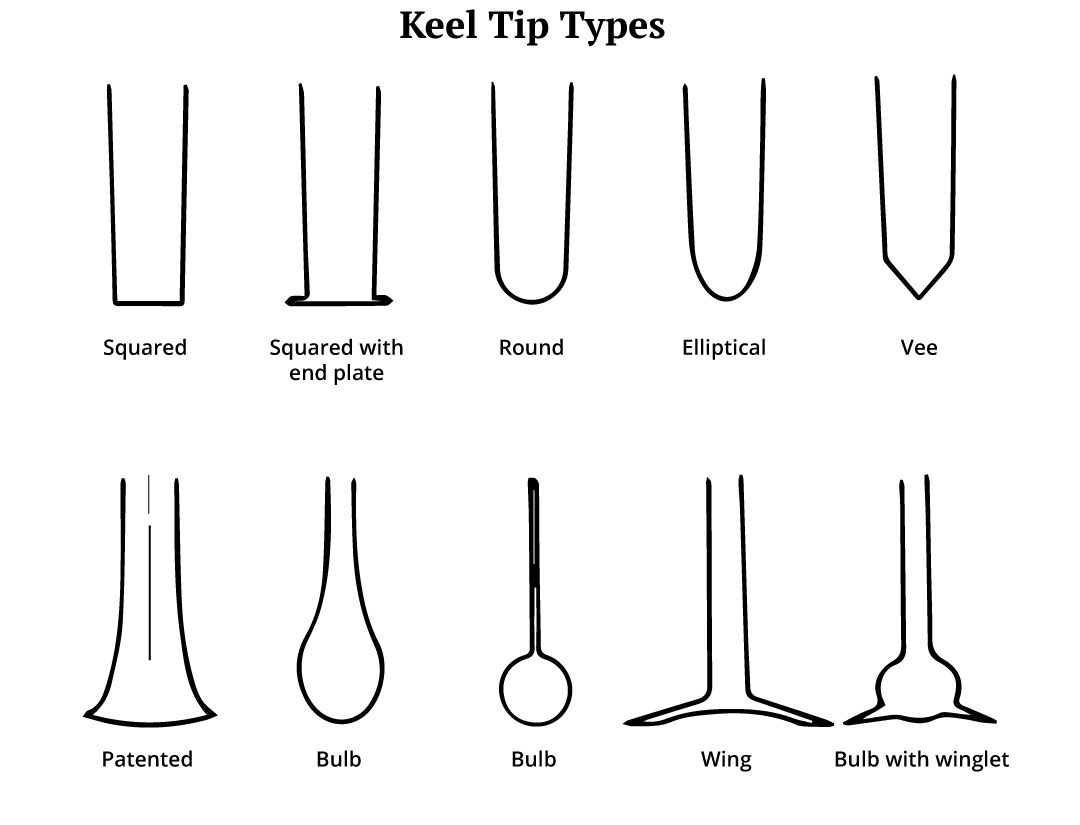
The tip shape, viewed from ahead, may be flat, round, elliptical, or bulbed. Tests show that the flat, squared-off tip develops a bit more lift to windward and that the round or elliptical tip has less drag on a run. The differences are slight but, today, I favor the squared-off tip with an end plate for yachts of average draft. A vee tip was tried in the 1960s on a few yachts, but never became popular. Bulbs and wings, often in combination, are fairly common on contemporary production boats. Usually, they are an attempt to produce a very shoal-draft yacht for use in waters where the bottom is close to the top and, in those cases, they may make sense.
There is a never-ending variety of fin shapes and, to be honest, I’m not sure which is best. Generally, I prefer a fin similar to the old Cal 40, a little shorter perhaps, and fitted with an end plate. Such a fin provides a desirable combination of good performance, ease of haulout, and structural strength, all very important factors for the cruising skipper.
Article first appeared Good Old Boat magazine: Volume 3, Number 4, July/August 2000 .
About The Author

Ted Brewer is one of North America's best-known yacht designers, having worked on the America's Cup boats, American Eagle and Weatherly, as well as boats that won the Olympics, the Gold Cup, and dozens of celebrated ocean races. He also is the man who designed scores of good old boats, the ones still sailing after all these years.
Related Posts
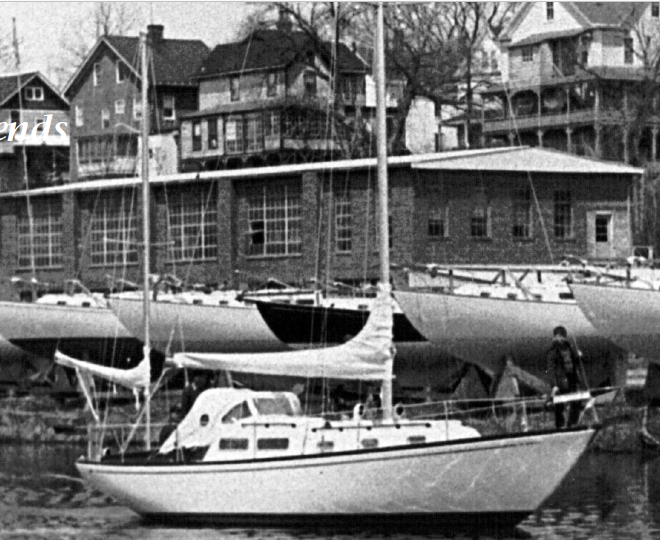
Allied Boat Company
January 1, 1999
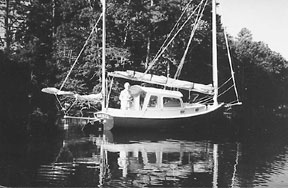
Good Old Catboat
July 17, 2019
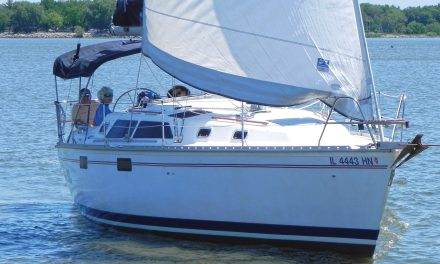
Hunter 33.5
January 15, 2023

Southerly 115 Boat Comparison
March 1, 2019
Now on Newsstands
Join Our Mailing List
Get the best sailing news, boat project how-tos and more delivered to your inbox.
You have Successfully Subscribed!
- Yachting World
- Digital Edition

43 of the best bluewater sailboat designs of all time
- January 5, 2022
How do you choose the right yacht for you? We highlight the very best bluewater sailboat designs for every type of cruising

Which yacht is the best for bluewater boating? This question generates even more debate among sailors than questions about what’s the coolest yacht , or the best for racing. Whereas racing designs are measured against each other, cruising sailors get very limited opportunities to experience different yachts in real oceangoing conditions, so what is the best bluewater sailboat?
Here, we bring you our top choices from decades of designs and launches. Over the years, the Yachting World team has sailed these boats, tested them or judged them for European Yacht of the Year awards, and we have sifted through the many to curate a selection that we believe should be on your wishlist.
Making the right choice may come down to how you foresee your yacht being used after it has crossed an ocean or completed a passage: will you be living at anchor or cruising along the coast? If so, your guiding requirements will be space, cabin size, ease of launching a tender and anchoring closer to shore, and whether it can comfortably accommodate non-expert-sailor guests.
Article continues below…

The perfect boat: what makes an ideal offshore cruising yacht?
Choosing a boat for offshore cruising is not a decision to be taken lightly. I have researched this topic on…

European Yacht of the Year 2019: Best luxury cruisers
Before the sea trials began, I would have put money on a Hallberg-Rassy or the Wauquiez winning an award. The…
All of these considerations have generated the inexorable rise of the bluewater catamaran – monohulls can’t easily compete on these points. We have a full separate feature on the best bluewater multihulls of all time and here we mostly focus on monohulls. The only exceptions to that rule are two multihulls which made it into our best bluewater sailboats of 2022 list.
As so much of making the right choice is selecting the right boat for the venture in mind, we have separated out our edit into categories: best for comfort; for families; for performance; and for expedition or high latitudes sailing .
Best bluewater sailboats of 2022
The new flagship Allures 51.9, for example, is a no-nonsense adventure cruising design built and finished to a high standard. It retains Allures’ niche of using aluminium hulls with glassfibre decks and superstructures, which, the yard maintains, gives the optimum combination of least maintenance and less weight higher up. Priorities for this design were a full beam aft cabin and a spacious, long cockpit. Both are excellent, with the latter, at 6m long, offering formidable social, sailing and aft deck zones.
It likes some breeze to come to life on the wheel, but I appreciate that it’s designed to take up to five tonnes payload. And I like the ease with which you can change gears using the furling headsails and the positioning of the powerful Andersen winches inboard. The arch is standard and comes with a textile sprayhood or hard bimini.
Below decks you’ll find abundant headroom and natural light, a deep U-shape galley and cavernous stowage. For those who like the layout of the Amel 50 but would prefer aluminium or shoal draught, look no further.
Allures 51.9 price: €766,000
The Ovni 370 is another cunning new aluminum centreboard offering, a true deck saloon cruiser for two. The designers say the biggest challenge was to create a Category A ocean going yacht at this size with a lifting keel, hence the hull had to be very stable.
Enjoyable to helm, it has a practical, deep cockpit behind a large sprayhood, which can link to the bimini on the arch. Many of its most appealing features lie in the bright, light, contemporary, clever, voluminous interior, which has good stowage and tankage allocation. There’s also a practical navstation, a large workroom and a vast separate shower. I particularly like the convertible saloom, which can double as a large secure daybed or pilot berth.
Potentially the least expensive Category A lift keel boat available, the Ovni will get you dreaming of remote places again.
Ovni 370 price: €282,080

There’s no shortage of spirit in the Windelo 50. We gave this a sustainability award after it’s founders spent two years researching environmentally-friendly composite materials, developing an eco-composite of basalt fibre and recycled PET foam so it could build boats that halve the environmental impact of standard glassfibre yachts.
The Windelo 50 is an intriguing package – from the styling, modular interior and novel layout to the solar field on the roof and the standard electric propulsion, it is completely fresh.
Windelo 50 price: €795,000
Best bluewater sailboat of 2022 – Outremer 55
I would argue that this is the most successful new production yacht on the market. Well over 50 have already sold (an equipped model typically costs €1.6m) – and I can understand why. After all, were money no object, I had this design earmarked as the new yacht I would most likely choose for a world trip.
Indeed 55 number one Sanya, was fully equipped for a family’s world cruise, and left during our stay for the Grand Large Odyssey tour. Whereas we sailed Magic Kili, which was tricked up with performance options, including foam-cored deckheads and supports, carbon crossbeam and bulkheads, and synthetic rigging.
At rest, these are enticing space ships. Taking one out to sea is another matter though. These are speed machines with the size, scale and loads to be rightly weary of. Last month Nikki Henderson wrote a feature for us about how to manage a new breed of performance cruising cats just like this and how she coaches new owners. I could not think of wiser money spent for those who do not have ample multihull sailing experience.
Under sail, the most fun was obviously reserved for the reaching leg under asymmetric, where we clocked between 11-16 knots in 15-16 knots wind. But it was the stability and of those sustained low teen speeds which really hit home – passagemaking where you really cover miles.
Key features include the swing helms, which give you views from outboard, over the coachroof or from a protected position in the cockpit through the coachroof windows, and the vast island in the galley, which is key to an open plan main living area. It helps provide cavernous stowage and acts as the heart of the entertaining space as it would in a modern home. As Danish judge Morten Brandt-Rasmussen comments: “Apart from being the TGV of ocean passages the boat offers the most spacious, open and best integration of the cockpit and salon areas in the market.”
Outremer has done a top job in packing in the creature comforts, stowage space and payload capacity, while keeping it light enough to eat miles. Although a lot to absorb and handle, the 55 offers a formidable blend of speed and luxury cruising.
Outremer 55 price: €1.35m
Best bluewater sailboats for comfort
This is the successor to the legendary Super Maramu, a ketch design that for several decades defined easy downwind handling and fostered a cult following for the French yard. Nearly a decade old, the Amel 55 is the bridge between those world-girdling stalwarts and Amel’s more recent and totally re-imagined sloop designs, the Amel 50 and 60.
The 55 boasts all the serious features Amel aficionados loved and valued: a skeg-hung rudder, solidly built hull, watertight bulkheads, solid guardrails and rampart bulwarks. And, most noticeable, the solid doghouse in which the helmsman sits in perfect shelter at the wheel.
This is a design to live on comfortably for long periods and the list of standard features just goes on and on: passarelle; proper sea berths with lee cloths; electric furling main and genoa; and a multitude of practical items that go right down to a dishwasher and crockery.
There’s no getting around the fact these designs do look rather dated now, and through the development of easier sail handling systems the ketch rig has fallen out of fashion, but the Amel is nothing short of a phenomenon, and if you’ve never even peeked on board one, you really have missed a treat.

Photo: Sander van der Borch
Contest 50CS
A centre cockpit cruiser with true longevity, the Contest 50CS was launched by Conyplex back in 2003 and is still being built by the family-owned Dutch company, now in updated and restyled form.
With a fully balanced rudder, large wheel and modern underwater sections, the Contest 50CS is a surprisingly good performer for a boat that has a dry weight of 17.5 tonnes. Many were fitted with in-mast furling, which clearly curtails that performance, but even without, this boat is set up for a small crew.
Electric winches and mainsheet traveller are all easy to reach from the helm. On our test of the Contest 50CS, we saw for ourselves how two people can gybe downwind under spinnaker without undue drama. Upwind, a 105% genoa is so easy to tack it flatters even the weediest crewmember.
Down below, the finish level of the joinery work is up there among the best and the interior is full of clever touches, again updated and modernised since the early models. Never the cheapest bluewater sailing yacht around, the Contest 50CS has remained in demand as a brokerage buy. She is a reassuringly sure-footed, easily handled, very well built yacht that for all those reasons has stood the test of time.
This is a yacht that would be well capable of helping you extend your cruising grounds, almost without realising it.
Read more about the Contest 50CS and the new Contest 49CS

Photo: Rick Tomlinson
Hallberg-Rassy 48 Mk II
For many, the Swedish Hallberg-Rassy yard makes the quintessential bluewater cruiser for couples. With their distinctive blue cove line, these designs are famous for their seakindly behaviour, solid-as-a-rock build and beautifully finished, traditional interiors.
To some eyes, Hallberg-Rassys aren’t quite cool enough, but it’s been company owner Magnus Rassy’s confidence in the formula and belief in incremental ‘step-by-step’ evolution that has been such an exceptional guarantor of reliable quality, reputation and resale value.
The centre cockpit Hallberg-Rassy 48 epitomises the concept of comfort at sea and, like all the Frers-designed Hallberg-Rassys since the 1990s, is surprisingly fleet upwind as well as steady downwind. The 48 is perfectly able to be handled by a couple (as we found a few years back in the Pacific), and could with no great effort crack out 200-mile days.
The Hallberg-Rassy 48 was launched nearly a decade ago, but the Mk II from 2014 is our pick, updated with a more modern profile, larger windows and hull portlights that flood the saloon and aft cabin with light. With a large chart table, secure linear galley, heaps of stowage and space for bluewater extras such as machinery and gear, this yacht pretty much ticks all the boxes.

Discovery 55
First launched in 2000, the Discovery 55 has stood the test of time. Designed by Ron Holland, it hit a sweet spot in size that appealed to couples and families with world girdling plans.
Elegantly styled and well balanced, the 55 is also a practical design, with a deep and secure cockpit, comfortable seating, a self-tacking jib, dedicated stowage for the liferaft , a decent sugar scoop transom that’s useful for swimming or dinghy access, and very comfortable accommodation below. In short, it is a design that has been well thought out by those who’ve been there, got the bruises, stubbed their toes and vowed to change things in the future if they ever got the chance.
Throughout the accommodation there are plenty of examples of good detailing, from the proliferation of handholds and grabrails, to deep sinks in the galley offering immediate stowage when under way and the stand up/sit down showers. Stowage is good, too, with plenty of sensibly sized lockers in easily accessible positions.
The Discovery 55 has practical ideas and nifty details aplenty. She’s not, and never was, a breakthrough in modern luxury cruising but she is pretty, comfortable to sail and live on, and well mannered.

Photo: Latitudes Picture Library
You can’t get much more Cornish than a Rustler. The hulls of this Stephen Jones design are hand-moulded and fitted out in Falmouth – and few are more ruggedly built than this traditional, up-for-anything offshore cruiser.
She boasts an encapsulated lead keel, eliminating keel bolts and creating a sump for generous fuel and water tankage, while a chunky skeg protects the rudder. She is designed for good directional stability and load carrying ability. These are all features that lend this yacht confidence as it shoulders aside the rough stuff.
Most of those built have had a cutter rig, a flexible arrangement that makes sense for long passages in all sea and weather conditions. Down below, the galley and saloon berths are comfortable and sensible for living in port and at sea, with joinery that Rustler’s builders are rightly proud of.
As modern yachts have got wider, higher and fatter, the Rustler 42 is an exception. This is an exceptionally well-mannered seagoing yacht in the traditional vein, with elegant lines and pleasing overhangs, yet also surprisingly powerful. And although now over 20 years old, timeless looks and qualities mean this design makes her look ever more like a perennial, a modern classic.
The definitive crossover size, the point at which a yacht can be handled by a couple but is just large enough to have a professional skipper and be chartered, sits at around the 60ft mark. At 58ft 8in, the Oyster 575 fitted perfectly into this growing market when launched in 2010. It went on to be one of the most popular models from the yard, and is only now being superseded by the newer Rob Humphreys-designed Oyster 565 (just launched this spring).
Built in various configurations with either a deep keel, shoal draught keel or centreboard with twin rudders, owners could trade off better performance against easy access to shallower coves and anchorages. The deep-bodied hull, also by Rob Humphreys, is known for its easy motion at sea.
Some of the Oyster 575’s best features include its hallmark coachroof windows style and centre cockpit – almost everyone will know at first glance this is an Oyster – and superb interior finish. If she has a flaw, it is arguably the high cockpit, but the flip side is the galley headroom and passageway berth to the large aft stateroom.
This design also has a host of practical features for long-distance cruising, such as high guardrails, dedicated liferaft stowage, a vast lazarette for swallowing sails, tender, fenders etc, and a penthouse engine room.

Privilege Serie 5
A true luxury catamaran which, fully fitted out, will top €1m, this deserves to be seen alongside the likes of the Oyster 575, Gunfleet 58 and Hallberg-Rassy 55. It boasts a large cockpit and living area, and a light and spacious saloon with an emphasis on indoor-outdoor living, masses of refrigeration and a big galley.
Standout features are finish quality and solid build in a yacht designed to take a high payload, a secure walkaround deck and all-round views from the helm station. The new Privilege 510 that will replace this launches in February 2020.
Gunfleet 43
It was with this Tony Castro design that Richard Matthews, founder of Oyster Yachts, launched a brand new rival brand in 2012, the smallest of a range stretching to the flagship Gunfleet 74. The combination of short overhangs and centre cockpit at this size do make the Gunfleet 43 look modern if a little boxy, but time and subsequent design trends have been kind to her lines, and the build quality is excellent. The saloon, galley and aft cabin space is exceptional on a yacht of this size.

Photo: David Harding
Conceived as a belt-and-braces cruiser, the Kraken 50 launched last year. Its unique points lie underwater in the guise of a full skeg-hung rudder and so-called ‘Zero Keel’, an encapsulated long keel with lead ballast.
Kraken Yachts is the brainchild of British businessman and highly experienced cruiser Dick Beaumont, who is adamant that safety should be foremost in cruising yacht design and build. “There is no such thing as ‘one yacht for all purposes’… You cannot have the best of all worlds, whatever the salesman tells you,” he says.
Read our full review of the Kraken 50 .

Wauquiez Centurion 57
Few yachts can claim to be both an exciting Med-style design and a serious and practical northern European offshore cruiser, but the Wauquiez Centurion 57 tries to blend both. She slightly misses if you judge solely by either criterion, but is pretty and practical enough to suit her purpose.
A very pleasant, well-considered yacht, she is impressively built and finished with a warm and comfortable interior. More versatile than radical, she could be used for sailing across the Atlantic in comfort and raced with equal enjoyment at Antigua Sailing Week .

A modern classic if ever there was one. A medium to heavy displacement yacht, stiff and easily capable of standing up to her canvas. Pretty, traditional lines and layout below.

Photo: Voyage of Swell
Well-proven US legacy design dating back to the mid-1960s that once conquered the Transpac Race . Still admired as pretty, with slight spoon bow and overhanging transom.

Capable medium displacement cruiser, ideal size and good accommodation for couples or family cruising, and much less costly than similar luxury brands.

Photo: Peter Szamer
Swedish-built aft cockpit cruiser, smaller than many here, but a well-built and finished, super-durable pocket ocean cruiser.

Tartan 3700
Designed as a performance cruiser there are nimbler alternatives now, but this is still an extremely pretty yacht.
Broker ’ s choice

Discovery 55 Brizo
This yacht has already circumnavigated the globe and is ‘prepared for her next adventure,’ says broker Berthon. Price: £535,000 + VAT

Oyster 575 Ayesha
‘Stunning, and perfectly equipped for bluewater cruising,’ says broker Ancasta International. Price: £845,000 (tax not paid)


Oyster 575 Pearls of Nautilus
Nearly new and with a high spec, this Oyster Brokerage yacht features American white oak joinery and white leather upholstery and has a shoal draught keel. Price: $1.49m
Best bluewater yachts for performance
The Frers-designed Swan 54 may not be the newest hull shape but heralded Swan’s latest generation of displacement bluewater cruisers when launched four years ago. With raked stem, deep V hull form, lower freeboard and slight curve to the topsides she has a more timeless aesthetic than many modern slab-sided high volume yachts, and with that a seakindly motion in waves. If you plan to cover many miles to weather, this is probably the yacht you want to be on.

Photo: Carlo Borlenghi
Besides Swan’s superlative build quality, the 54 brings many true bluewater features, including a dedicated sail locker. There’s also a cockpit locker that functions as a utility cabin, with potential to hold your generator and washing machine, or be a workshop space.
The sloping transom opens out to reveal a 2.5m bathing platform, and although the cabins are not huge there is copious stowage space. Down below the top-notch oak joinery is well thought through with deep fiddles, and there is a substantial nav station. But the Swan 54 wins for handling above all, with well laid-out sail controls that can be easily managed between a couple, while offering real sailing enjoyment to the helmsman.

Photo: Graham Snook
The Performance Cruiser winner at the 2019 European Yacht of the Year awards, the Arcona 435 is all about the sailing experience. She has genuine potential as a cruiser-racer, but her strengths are as an enjoyable cruiser rather than a full-blown liveaboard bluewater boat.
Build quality is excellent, there is the option of a carbon hull and deck, and elegant lines and a plumb bow give the Arcona 435 good looks as well as excellent performance in light airs. Besides slick sail handling systems, there are well thought-out features for cruising, such as ample built-in rope bins and an optional semi-closed stern with stowage and swim platform.

Outremer 51
If you want the space and stability of a cat but still prioritise sailing performance, Outremer has built a reputation on building catamarans with true bluewater characteristics that have cruised the planet for the past 30 years.
Lighter and slimmer-hulled than most cruising cats, the Outremer 51 is all about sailing at faster speeds, more easily. The lower volume hulls and higher bridgedeck make for a better motion in waves, while owners report that being able to maintain a decent pace even under reduced canvas makes for stress-free passages. Deep daggerboards also give good upwind performance.
With bucket seats and tiller steering options, the Outremer 51 rewards sailors who want to spend time steering, while they’re famously well set up for handling with one person on deck. The compromise comes with the interior space – even with a relatively minimalist style, there is less cabin space and stowage volume than on the bulkier cats, but the Outremer 51 still packs in plenty of practical features.

The Xc45 was the first cruising yacht X-Yachts ever built, and designed to give the same X-Yachts sailing experience for sailors who’d spent years racing 30/40-footer X- and IMX designs, but in a cruising package.
Launched over 10 years ago, the Xc45 has been revisited a few times to increase the stowage and modernise some of the styling, but the key features remain the same, including substantial tanks set low for a low centre of gravity, and X-Yachts’ trademark steel keel grid structure. She has fairly traditional styling and layout, matched with solid build quality.
A soft bilge and V-shaped hull gives a kindly motion in waves, and the cockpit is secure, if narrow by modern standards.

A three or four cabin catamaran that’s fleet of foot with high bridgedeck clearance for comfortable motion at sea. With tall daggerboards and carbon construction in some high load areas, Catana cats are light and quick to accelerate.

Sweden Yachts 45
An established bluewater design that also features in plenty of offshore races. Some examples are specced with carbon rig and retractable bowsprits. All have a self-tacking jib for ease. Expect sweeping areas of teak above decks and a traditionally wooded interior with hanging wet locker.

A vintage performer, first launched in 1981, the 51 was the first Frers-designed Swan and marked a new era of iconic cruiser-racers. Some 36 of the Swan 51 were built, many still actively racing and cruising nearly 40 years on. Classic lines and a split cockpit make this a boat for helming, not sunbathing.

Photo: Julien Girardot / EYOTY
The JPK 45 comes from a French racing stable, combining race-winning design heritage with cruising amenities. What you see is what you get – there are no superfluous headliners or floorboards, but there are plenty of ocean sailing details, like inboard winches for safe trimming. The JPK 45 also has a brilliantly designed cockpit with an optional doghouse creating all-weather shelter, twin wheels and superb clutch and rope bin arrangement.

Photo: Andreas Lindlahr
For sailors who don’t mind exchanging a few creature comforts for downwind planing performance, the Pogo 50 offers double-digit surfing speeds for exhilarating tradewind sailing. There’s an open transom, tiller steering and no backstay or runners. The Pogo 50 also has a swing keel, to nose into shallow anchorages.

Seawind 1600
Seawinds are relatively unknown in Europe, but these bluewater cats are very popular in Australia. As would be expected from a Reichel-Pugh design, this 52-footer combines striking good looks and high performance, with fine entry bows and comparatively low freeboard. Rudders are foam cored lifting designs in cassettes, which offer straightforward access in case of repairs, while daggerboards are housed under the deck.
Best bluewater sailboats for families
It’s unsurprising that, for many families, it’s a catamaran that meets their requirements best of increased space – both living space and separate cabins for privacy-seeking teenagers, additional crew or visiting family – as well as stable and predictable handling.

Photo: Nicholas Claris
Undoubtedly one of the biggest success stories has been the Lagoon 450, which, together with boats like the Fountaine Pajot 44, helped drive up the popularity of catamaran cruising by making it affordable and accessible. They have sold in huge numbers – over 1,000 Lagoon 450s have been built since its launch in 2010.
The VPLP-designed 450 was originally launched with a flybridge with a near central helming position and upper level lounging areas (450F). The later ‘sport top’ option (450S) offered a starboard helm station and lower boom (and hence lower centre of gravity for reduced pitching). The 450S also gained a hull chine to create additional volume above the waterline. The Lagoon features forward lounging and aft cockpit areas for additional outdoor living space.
Besides being a big hit among charter operators, Lagoons have proven themselves over thousands of bluewater miles – there were seven Lagoon 450s in last year’s ARC alone. In what remains a competitive sector of the market, Lagoon has recently launched a new 46, with a larger self-tacking jib and mast moved aft, and more lounging areas.

Photo: Gilles Martin-Raget
Fountaine Pajot Helia 44
The FP Helia 44 is lighter, lower volume, and has a lower freeboard than the Lagoon, weighing in at 10.8 tonnes unloaded (compared to 15 for the 450). The helm station is on a mezzanine level two steps up from the bridgedeck, with a bench seat behind. A later ‘Evolution’ version was designed for liveaboard cruisers, featuring beefed up dinghy davits and an improved saloon space.
Available in three or four cabin layouts, the Helia 44 was also popular with charter owners as well as families. The new 45 promises additional volume, and an optional hydraulically lowered ‘beach club’ swim platform.

Photo: Arnaud De Buyzer / graphikup.com
The French RM 1370 might be less well known than the big brand names, but offers something a little bit different for anyone who wants a relatively voluminous cruising yacht. Designed by Marc Lombard, and beautifully built from plywood/epoxy, the RM is stiff and responsive, and sails superbly.
The RM yachts have a more individual look – in part down to the painted finish, which encourages many owners to personalise their yachts, but also thanks to their distinctive lines with reverse sheer and dreadnought bow. The cockpit is well laid out with the primary winches inboard for a secure trimming position. The interior is light, airy and modern, although the open transom won’t appeal to everyone.
For those wanting a monohull, the Hanse 575 hits a similar sweet spot to the popular multis, maximising accommodation for a realistic price, yet with responsive performance.
The Hanse offers a vast amount of living space thanks to the ‘loft design’ concept of having all the living areas on a single level, which gives a real feeling of spaciousness with no raised saloon or steps to accommodation. The trade-off for such lofty head height is a substantial freeboard – it towers above the pontoon, while, below, a stepladder is provided to reach some hatches.
Galley options include drawer fridge-freezers, microwave and coffee machine, and the full size nav station can double up as an office or study space.
But while the Hanse 575 is a seriously large boat, its popularity is also down to the fact that it is genuinely able to be handled by a couple. It was innovative in its deck layout: with a self-tacking jib and mainsheet winches immediately to hand next to the helm, one person could both steer and trim.
Direct steering gives a feeling of control and some tangible sailing fun, while the waterline length makes for rapid passage times. In 2016 the German yard launched the newer Hanse 588 model, having already sold 175 of the 575s in just four years.

Photo: Bertel Kolthof
Jeanneau 54
Jeanneau leads the way among production builders for versatile all-rounder yachts that balance sail performance and handling, ergonomics, liveaboard functionality and good looks. The Jeanneau 54 , part of the range designed by Philippe Briand with interior by Andrew Winch, melds the best of the larger and smaller models and is available in a vast array of layout options from two cabins/two heads right up to five cabins and three heads.
We’ve tested the Jeanneau 54 in a gale and very light winds, and it acquitted itself handsomely in both extremes. The primary and mainsheet winches are to hand next to the wheel, and the cockpit is spacious, protected and child-friendly. An electric folding swim and sun deck makes for quick fun in the water.

Nautitech Open 46
This was the first Nautitech catamaran to be built under the ownership of Bavaria, designed with an open-plan bridgedeck and cockpit for free-flowing living space. But with good pace for eating up bluewater miles, and aft twin helms rather than a flybridge, the Nautitech Open 46 also appeals to monohull sailors who prefer a more direct sailing experience.

Made by Robertson and Caine, who produce catamarans under a dual identity as both Leopard and the Sunsail/Moorings charter cats, the Leopard 45 is set to be another big seller. Reflecting its charter DNA, the Leopard 45 is voluminous, with stepped hulls for reduced waterline, and a separate forward cockpit.
Built in South Africa, they are robustly tested off the Cape and constructed ruggedly enough to handle heavy weather sailing as well as the demands of chartering.

Photo: Olivier Blanchet
If space is king then three hulls might be even better than two. The Neel 51 is rare as a cruising trimaran with enough space for proper liveaboard sailing. The galley and saloon are in the large central hull, together with an owner’s cabin on one level for a unique sensation of living above the water. Guest or family cabins lie in the outer hulls for privacy and there is a cavernous full height engine room under the cabin sole.
Performance is notably higher than an equivalent cruising cat, particularly in light winds, with a single rudder giving a truly direct feel in the helm, although manoeuvring a 50ft trimaran may daunt many sailors.

Beneteau Oceanis 46.1
A brilliant new model from Beneteau, this Finot Conq design has a modern stepped hull, which offers exhilarating and confidence-inspiring handling in big breezes, and slippery performance in lighter winds.
The Beneteau Oceanis 46.1 was the standout performer at this year’s European Yacht of the Year awards, and, in replacing the popular Oceanis 45, looks set to be another bestseller. Interior space is well used with a double island berth in the forepeak. An additional inboard unit creates a secure galley area, but tank capacity is moderate for long periods aboard.

Beneteau Oceanis 473
A popular model that offers beam and height in a functional layout, although, as with many boats of this age (she was launched in 2002), the mainsheet is not within reach of the helmsman.

Jeanneau Sun Odyssey 49
The Philippe Briand-designed Sun Odyssey range has a solid reputation as family production cruisers. Like the 473, the Sun Odyssey 49 was popular for charter so there are plenty of four-cabin models on the market.

Nautitech 441
The hull design dates back to 1995, but was relaunched in 2012. Though the saloon interior has dated, the 441 has solid practical features, such as a rainwater run-off collection gutter around the coachroof.

Atlantic 42
Chris White-designed cats feature a pilothouse and forward waist-high working cockpit with helm position, as well as an inside wheel at the nav station. The Atlantic 42 offers limited accommodation by modern cat standards but a very different sailing experience.
Best bluewater sailing yachts for expeditions
Bestevaer 56.
All of the yachts in our ‘expedition’ category are aluminium-hulled designs suitable for high latitude sailing, and all are exceptional yachts. But the Bestevaer 56 is a spectacular amount of boat to take on a true adventure. Each Bestevaer is a near-custom build with plenty of bespoke options for owners to customise the layout and where they fall on the scale of rugged off-grid adventurer to 4×4-style luxury fit out.

The Bestevaer range began when renowned naval architect Gerard Dijkstra chose to design his own personal yacht for liveaboard adventure cruising, a 53-footer. The concept drew plenty of interest from bluewater sailors wanting to make longer expeditions and Bestevaers are now available in a range of sizes, with the 56-footer proving a popular mid-range length.
The well-known Bestevaer 56 Tranquilo (pictured above) has a deep, secure cockpit, voluminous tanks (700lt water and over 1,100lt fuel) and a lifting keel plus water ballast, with classically styled teak clad decks and pilot house. Other owners have opted for functional bare aluminium hull and deck, some choose a doghouse and others a pilothouse.

Photo: Jean-Marie Liot
The Boreal 52 also offers Land Rover-esque practicality, with utilitarian bare aluminium hulls and a distinctive double-level doghouse/coachroof arrangement for added protection in all weathers. The cockpit is clean and uncluttered, thanks to the mainsheet position on top of the doghouse, although for visibility in close manoeuvring the helmsman will want to step up onto the aft deck.
Twin daggerboards, a lifting centreboard and long skeg on which she can settle make this a true go-anywhere expedition yacht. The metres of chain required for adventurous anchoring is stowed in a special locker by the mast to keep the weight central. Down below has been thought through with equally practical touches, including plenty of bracing points and lighting that switches on to red light first to protect your night vision.

Photo: Morris Adant / Garcia Yachts
Garcia Exploration 45
The Garcia Exploration 45 comes with real experience behind her – she was created in association with Jimmy Cornell, based on his many hundreds of thousands of miles of bluewater cruising, to go anywhere from high latitudes to the tropics.
Arguably less of a looker than the Bestevaer, the Garcia Exploration 45 features a rounded aluminium hull, centreboard with deep skeg and twin daggerboards. The considerable anchor chain weight has again been brought aft, this time via a special conduit to a watertight locker in front of the centreboard.
This is a yacht designed to be lived on for extended periods with ample storage, and panoramic portlights to give a near 360° view of whichever extraordinary landscape you are exploring. Safety features include a watertight companionway door to keep extreme weather out and through-hull fittings placed above the waterline. When former Vendée Globe skipper Pete Goss went cruising , this was the boat he chose to do it in.

Photo: svnaima.com
A truly well-proven expedition design, some 1,500 Ovnis have been built and many sailed to some of the most far-flung corners of the world. (Jimmy Cornell sailed his Aventura some 30,000 miles, including two Drake Passage crossings, one in 50 knots of wind).

Futuna Exploration 54
Another aluminium design with a swinging centreboard and a solid enclosed pilothouse with protected cockpit area. There’s a chunky bowsprit and substantial transom arch to house all manner of electronics and power generation.
Previous boats have been spec’d for North West Passage crossings with additional heating and engine power, although there’s a carbon rig option for those that want a touch of the black stuff. The tanks are capacious, with 1,000lt capability for both fresh water and fuel.
If you enjoyed this….
Yachting World is the world’s leading magazine for bluewater cruisers and offshore sailors. Every month we have inspirational adventures and practical features to help you realise your sailing dreams. Build your knowledge with a subscription delivered to your door. See our latest offers and save at least 30% off the cover price.

Lit’l Coot 18 Full Keel
Devlin Boats , Sailboats

The Lit’l Coot 18 Full Keel is a is seaworthy and capable motorsailor with enough space on board for the organized sailor and enough potential to keep serious travelers satisfied. She is the sister to the original Lit’l Coot with the same hull and the same tendency for balanced performance and maximal use of space, but the change to a fixed centerline keel allows her to stand up to weather that the original could not handle. This change also frees up space in the cabin, which makes her more comfortable for longer cruises. Twin rudders surround the outboard motor on the centerline to allow efficient motor cruising on an economical 9.9 hp outboard.
Read Sam’s design notes below for the big picture on the Lit’l Coot Full Keel.
The Lit’l Coot 18 Full Keel is available in study and full construction plans .
Precision cut CNC hull kit available here

Lit’l Coot Design Notes
Recently I was working on the plans for a small under 20ft. Pocket Sailor design but found during the process I couldn’t help but think about another design, one roughly the same size and in many respects similar in use, but the type I zeroed in on was a small Motorsailor. This “Litl Coot” design is the result of my musings and dreams. Now in this case, despite being my own design customer, I still needed to stay focused and set up a list of design parameters that the new design would accommodate. First of all she needed to be very trailerable with the capability of sitting on a powerboat type trailer low and compact enough to be able to be backed into a garage or storage shed without any special needs. So right away that got rid of any notion that I would need to design a deep keel for her. I flirted with the idea of leeboards but quickly realized that a couple of hardwood Bilge Keels, along with a centerline small shoe keel and aft skeg, would be just the ticket. The bilge keels also had the additional benefit that they would allow her to beach out level and upright if I got caught by a quickly receding tide in some of the shallow and very tidal bays that I was dreaming of using her on. If you are a fan of classic literature, there is an excellent novel written just before World War One titled “Riddle of the Sands”. The story is based near the Friesian Islands located off the N.W. shore of Holland and Germany. These waters are a very tidal area and the descriptions of the main character straying off the dredged and poorly marked channels and getting caught on the sands in his shoal draft boat with all the extra adventures that one would have with that scenario, has always been appealing to me. Anyway, it’s a great read. As I recollect, this is either one of the first or the very first Mystery Adventure novels written by Erskine Childers and it has had a prominent position in my library for many years.
But back to the “Litl Coot” design – once I had made the decision to give her bilge keels, that meant all her ballast needed to be in the bilge and my plan is to use recycled lead shot (I buy mine from one of the local trap and skeet shooting ranges) which is very nice to work with, all cleaned, in small canvas bags weighing 30 lbs. each and ready to be mixed with epoxy and set into her bilge. I usually plan on casting about 75-85% of the anticipated ballast (in this case 600 lbs) before launching and then finish off the final ballasting after checking her trim in the water and re-assuring myself that the weight is located where it is most needed to keep her floating level and on her lines. That reminds me of a story, several years ago my long-term landlord at my main shop (which I have rented for 28 years now) told me one day just after we had launched a new boat, that one of the things that amazed him most of all about my designing and building boats was how accurately I could predict the floating of the boat level and on her lines. Well that was quite a compliment and I think that if I remember properly that I tried to pass it off as not being that hard to do! Within just a couple of weeks we had occasion to launch another new build (different design, one that we hadn’t built before) and the new vessel floated down on her lines by the stern. We had to add some (actually read quite a lot of) extra chain in her anchor locker to get her settled down on her lines (as designed). I often wondered if my landlord had somehow jinxed me by saying that they all floated on their lines so nicely, and having missed the mark on the very next boat project, the whole experience sobered me considerably. It should go without saying that on the next design I spent almost twice as much time as I usually did on the weight study trying to not make the same mistake twice.
But back to our musings about the “Litl Coot” – now that we’ve got the keels on her and the ballast settled, it’s time to think about that engine package. This is a pure 50/50 Motorsailor and on this size boat, I think the little 9.9 horsepower Yamaha 4 cycle engine in hi-thrust configuration is just about ideal. It’s a great little engine, barely sips fuel, is almost soundless at idle and will work on this design very well. But here I was confronted with a problem. With many small sailboats, if we make a centerline rudder and hang the outboard on some sort of scissoring bracket to one side of the stern, when sailing on the tack where the outboard is to the lee side, you will find the end of the lower unit of the outboard dragging in the water. There might be a couple of solutions to this problem, we could move the outboard closer to the centerline, but if we are not really careful then there is a really good chance that sooner or later you will hit the prop with the rudder while doing some short maneuvering in a docking or mooring situation. If you place the engine further away from the rudder you’ve exaggerated the problem of the drag of the lower unit and prop of the outboard (and I hate dragging something like that when trying to sail). So my solution for the “Litl Coot” was to place the motor on the centerline of the transom, and by using a long shaft outboard we will be able to keep the lower unit from dragging on the lee side tack (as there is no lee side to a centerline mounted engine) and both the motoring and the sailing will be without compromise. Now with the engine on the centerline that meant in order to be able to steer her under sail, I needed to find a way to either mount a rudder off the centerline or an even better solution was to use twin rudders that have tillers that tie together into a common link arm. The additional benefit of the twin rudders allowed them to not extend into the water quite as deeply as if I had used just a single rudder and conforms rather nicely with our requirement of being able to sit level and upright in grounding situations without any necessity to lift the rudders up or have some sort of swing blades on them. Once we joined the two tillers together into a single link arm then my next problem of how to allow an inside steering station to be rigged was easily assisted by having one common link with simple shackles made up to fixed lines (when desiring the inside steering station) and led through turning blocks to a fore and aft pivoting vertical tiller that will be fixed in the pilothouse on the starboard side. If I desire to steer from this inside station, I can sit in a comfortable seat on the starboard side facing forward and steer her by either pushing or pulling on the tiller. There is enough drag in this type of steering system to keep the helm steady for short periods of time if I needed to have her self steering while fixing a spot of tea or perhaps making a snack.
One of the main ideas with this design is that all functions could be done while sailing, or motoring, solo. There is room to take a buddy along but you don’t necessarily have to, in fact there might be a lot of days when just my dog “Bella” might be the perfect crew for an adventure on the “Litl Coot”. So all the halyards, topping lifts, etc. are lead aft to the sides of the pilothouse. With her little mizzen sail set up and left rigged most of the time either under sail or under power, she will have the wonderful capability to have a balanced helm under different wind and tacking conditions, and the mizzen would help to keep her steady on a mooring, or at anchor when holed up for a rest.
For easy and quick set up when launching from trailer I designed a tabernacle hinged Mainmast setting a rig that I would call a Cat Yawl (although under some definitions this might also be described as a Cat Ketch, the mizzen being stepped ahead of the rudders) configuration. This style of rig keeps the sail area where it is needed for balance under sail and is a very simple to use, with literally no re-sheeting necessary as one tacks from board to board. With the process of rigging the Mainmast simply being a matter of rotating up the mast in its tabernacle, set up the forestay on the bail above the Stainless Steel anchor roller up on the bow, and insert a pin into the bottom of the tabernacle and you are ready to launch. Keeping the mast up in the eyes of the boat also allowed me to have a top hinged window on the front of the pilothouse for sailing or motoring on warm days. This allows lots of wind in the face but reduces the chance of getting too much sun on my already overly exposed face, if I choose to be inside in the shade of the pilothouse.
So we now have a boat that can sit on a trailer, fit in a normal sized garage for berthage when we aren’t using her, an inside and outside steering arrangement, a couple of berths for doing some simple cruise/camping, and one that will sail or motor at a fairly efficient level whether the wind is blowing or not. And did I add that she is towable behind most of the small-to-mid sized SUVss or Pickups? She also is a boat that will allow me to explore the really shallow and fringe cruising areas that more conventional sailboats with their deep keels can’t even think about sailing in. I can sail her either on my own or with crew, but again all systems and setup can be done on my own if that is the way I choose to use her. In final expression I have found the “Litl Coot” to be absolutely beguiling during her design stages and my armchair cruises have been wonderful, built around her platform. My best guess is that her real life adventures might be just as good or better, and that adds a lot of spice to my life, just the ticket for a modern, busy world!
Amateur plans are $195 and consist of 16 drawings printed on 24X36 inch paper and a simple building booklet. You can either buy printed sets of plans directly from us or buy a download version and print on your own. We are now producing basic hull kits for her or we could build you the whole boat if you would like, and very soon I look forward to seeing many of these little Cat Yawls on the water. — Sam Devlin
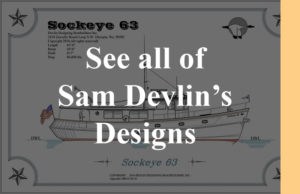
Notice to our valued Devlin Boat customers
As always, if you have any questions about orders (past or present), don’t hesitate to get in touch!
Featured Products

Artfully Designed and Crafted Boats since 1978
Shop tours on Fridays by appointment
Pin It on Pinterest

Home » Blog » Buy a boat » 5 best small sailboats for sailing around the world
5 best small sailboats for sailing around the world
By Author Fiona McGlynn
Posted on Last updated: April 19, 2023

A small sailboat can take you big places
Small sailboats are the ticket to going cruising NOW — not when you retire, save up enough money, or find the “perfect” bluewater cruising boat. In fact, it’s the first principle in Lin and Larry Pardey’s cruising philosophy: “Go small, go simple, go now.”
Small yachts can be affordable, simple, and seaworthy . However, you won’t see many of them in today’s cruising grounds. In three years and 13,000 nautical miles of bluewater cruising, I could count the number of under 30-foot sailboats I’ve seen on one hand (all of them were skippered by people in their 20s and 30s).
Today’s anchorages are full of 40, 50, and 60-foot-plus ocean sailboats, but that’s not to say you can’t sail the world in a small sailboat. Just look at Alessandro di Benedetto who in 2010 broke the record for the smallest boat to sail around the world non-stop in his 21-foot Mini 6.5 .
So long as you don’t mind forgoing a few comforts, you can sail around the world on a small budget .

What makes a good blue water sailboat
While you might not think a small sailboat is up to the task of going long distances, some of the best bluewater sailboats are under 40 feet.
However, if you’re thinking about buying a boat for offshore cruising, there are a few things to know about what makes a small boat offshore capable .
Smaller equals slower
Don’t expect to be sailing at high speeds in a pocket cruiser. Smaller displacement monohulls are always going to be slower than larger displacement monohulls (see the video below to learn why smaller boats are slower). Therefore a smaller cruiser is going to take longer on a given passage, making them more vulnerable to changes in weather.
A few feet can make a big difference over a week-long passage. On the last leg of our Pacific Ocean crossing, our 35-foot sailboat narrowly avoid a storm that our buddy boat, a 28-foot sailboat, couldn’t. Our friend was only a knot slower but it meant he had to heave to for a miserable three days.

Small but sturdy
If a pocket cruiser encounters bad weather, they will be less able to outrun or avoid it. For this reason, many of the blue water sailboats in this list are heavily built and designed to take a beating.
Yacht design has changed dramatically over the last 50 years. Today, new boats are designed to be light and fast. The small sailboats in our list are 30-plus year-old designs and were built in a time when weather forecasts were less accurate and harder to come by.
Back in the day, boat were constructed with thicker fiberglass hulls than you see in modern builds. Rigs, keels, rudders, hulls and decks – everything about these small cruising sailboats was designed to stand up to strong winds and big waves. Some of the boats in this post have skeg-hung rudders and most of them are full keel boats.
The pros and cons of pocket cruiser sailboats
Pocket cruiser sailboats present certain advantages and disadvantages.
More affordable
Their smaller size makes them affordable bluewater sailboats. You can often find great deals on pocket cruisers and sometimes you can even get them for free.
You’ll also save money on retrofits and repairs because small cruising sailboats need smaller boat parts (which cost a lot less) . For example, you can get away with smaller sails, ground tackle, winches, and lighter lines than on a bigger boat.
Moorage, haul-outs, and marine services are often billed by foot of boat length . A small sailboat makes traveling the world , far more affordable!
When something major breaks (like an engine) it will be less costly to repair or replace than it would be on a bigger boat.

Less time consuming
Smaller boats tend to have simpler systems which means you’ll spend less time fixing and paying to maintain those systems. For example, most small yachts don’t have showers, watermakers , hot water, and electric anchor windlasses.
On the flip side, you’ll spend more time collecting water (the low-tech way) . On a small sailboat, this means bucket baths, catching fresh water in your sails, and hand-bombing your anchor. Though less convenient, this simplicity can save you years of preparation and saving to go sailing.
Oh, and did I mention that you’ll become a complete water meiser? Conserving water aboard becomes pretty important when you have to blue-jug every drop of it from town back to your boat.
Easier to sail
Lastly, smaller boats can be physically easier to sail , just think of the difference between raising a sail on a 25-foot boat versus a 50-foot boat! You can more easily single-hand or short-hand a small sailboat. For that reason, some of the best solo blue water sailboats are quite petite.
As mentioned above small boats are slow boats and will arrive in port, sometimes days (and even weeks) behind their faster counterparts on long offshore crossings.
Consider this scenario: two boats crossed the Atlantic on a 4,000 nautical mile route. The small boat averaged four miles an hour, while the big boat averaged seven miles an hour. If both started at the same time, the small boat will have completed the crossing two weeks after the larger sailboat!
Less spacious
Living on a boat can be challenging — living on a small sailboat, even more so! Small cruising boats don’t provide much in the way of living space and creature comforts.
Not only will you have to downsize when you move onto a boat you’ll also have to get pretty creative when it comes to boat storage.
It also makes it more difficult to accommodate crew for long periods which means there are fewer people to share work and night shifts.
If you plan on sailing with your dog , it might put a small boat right out of the question (depending on the size of your four-legged crew member).

Less comfortable
It’s not just the living situation that is less comfortable, the sailing can be pretty uncomfortable too! Pocket cruisers tend to be a far less comfortable ride than larger boats as they are more easily tossed about in big ocean swell.
Here are our 5 favorite small blue water sailboats for sailing around the world
When we sailed across the Pacific these were some of the best small sailboats that we saw. Their owners loved them and we hope you will too!
The boats in this list are under 30 feet. If you’re looking for something slightly larger, you might want to check out our post on the best bluewater sailboats under 40 feet .
Note: Price ranges are based on SailboatListings.com and YachtWorld.com listings for Aug. 2018
Albin Vega 27($7-22K USD)

The Albin Vega has earned a reputation as a bluewater cruiser through adventurous sailors like Matt Rutherford, who in 2012 completed a 309-day solo nonstop circumnavigation of the Americas via Cape Horn and the Northwest Passage (see his story in the documentary Red Dot on the Ocean ).
- Hull Type: Long fin keel
- Hull Material: GRP (fibreglass)
- Length Overall:27′ 1″ / 8.25m
- Waterline Length:23′ 0″ / 7.01m
- Beam:8′ 1″ / 2.46m
- Draft:3′ 8″ / 1.12m
- Rig Type: Masthead sloop rig
- Displacement:5,070lb / 2,300kg
- Designer:Per Brohall
- Builder:Albin Marine AB (Swed.)
- Year First Built:1965
- Year Last Built:1979
- Number Built:3,450
Cape Dory 28 ($10-32K USD)

This small cruising sailboat is cute and classic as she is rugged and roomy. With at least one known circumnavigation and plenty of shorter bluewater voyages, the Cape Dory 28 has proven herself offshore capable.
- Hull Type: Full Keel
- Length Overall:28′ 09″ / 8.56m
- Waterline Length:22′ 50″ / 6.86m
- Beam:8’ 11” / 2.72m
- Draft:4’ 3” / 1.32m
- Rig Type:Masthead Sloop
- Displacement:9,300lb / 4,218kg
- Sail Area/Displacement Ratio:52
- Displacement/Length Ratio:49
- Designer: Carl Alberg
- Builder: Cape Dory Yachts (USA)
- Year First Built:1974
- Year Last Built:1988
- Number Built: 388
Dufour 29 ($7-23K)

As small bluewater sailboats go, the Dufour 29 is a lot of boat for your buck. We know of at least one that sailed across the Pacific last year. Designed as a cruiser racer she’s both fun to sail and adventure-ready. Like many Dufour sailboats from this era, she comes equipped with fiberglass molded wine bottle holders. Leave it to the French to think of everything!
- Hull Type: Fin with skeg-hung rudder
- Length Overall:29′ 4″ / 8.94m
- Waterline Length:25′ 1″ / 7.64m
- Beam:9′ 8″ / 2.95m
- Draft:5′ 3″ / 1.60m
- Displacement:7,250lb / 3,289kg
- Designer:Michael Dufour
- Builder:Dufour (France)
- Year First Built:1975
- Year Last Built:1984
Vancouver 28 ($15-34K)

A sensible small boat with a “go-anywhere” attitude, this pocket cruiser was designed with ocean sailors in mind. One of the best cruising sailboats under 40 feet, the Vancouver 28 is great sailing in a small package.
- Hull Type:Full keel with transom hung rudder
- Length Overall: 28′ 0″ / 8.53m
- Waterline Length:22’ 11” / 6.99m
- Beam:8’ 8” / 2.64m
- Draft:4’ 4” / 1.32m
- Rig Type: Cutter rig
- Displacement:8,960lb / 4,064 kg
- Designer: Robert B Harris
- Builder: Pheon Yachts Ltd. /Northshore Yachts Ltd.
- Year First Built:1986
- Last Year Built: 2007
- Number Built: 67
Westsail 28 ($30-35K)

Described in the 1975 marketing as “a hearty little cruiser”, the Westsail 28 was designed for those who were ready to embrace the cruising life. Perfect for a solo sailor or a cozy cruising couple!
- Hull Type: Full keel with transom hung rudder
- Hull Material:GRP (fibreglass)
- Length Overall:28′ 3” / 8.61m
- Waterline Length:23’ 6” / 7.16m
- Beam:9’ 7” / 2.92m
- Displacement:13,500lb / 6,124kg
- Designer: Herb David
- Builder: Westsail Corp. (USA)
- Number Built:78
Feeling inspired? Check out the “go small” philosophy of this 21-year-old who set sail in a CS 27.
Fiona McGlynn is an award-winning boating writer who created Waterborne as a place to learn about living aboard and traveling the world by sailboat. She has written for boating magazines including BoatUS, SAIL, Cruising World, and Good Old Boat. She’s also a contributing editor at Good Old Boat and BoatUS Magazine. In 2017, Fiona and her husband completed a 3-year, 13,000-mile voyage from Vancouver to Mexico to Australia on their 35-foot sailboat.
Saturday 1st of September 2018
Very useful list, but incomplete - as it would necessarily be, considering the number of seaworthy smaller boats that are around.
In particular, you missed/omitted the Westerly "Centaur" and its follow-on model, the "Griffon". 26 feet LOA, bilge-keelers, weighing something over 6000 pounds, usually fitted with a diesel inboard.
OK, these are British designs, and not that common in the US, but still they do exist, they're built like tanks, and it's rumored that at least one Centaur has circumnavigated.
Friday 31st of August 2018
This is a helpful list, thank you. I don't think most people would consider a 28' boat a pocket cruiser, though!
Terms and Conditions - Privacy Policy
Yachting Monthly
- Digital edition

How keel type affects performance
- Chris Beeson
- December 2, 2016
James Jermain looks at the main keel types, their typical performance and the pros and cons of each

A fin keel and spade rudder configuration gives high pointing but can be sensitive on the helm Credit: Graham Snook/YM

James Jermain has tested hundreds of yachts in his 30 years as Yachting Monthly’s chief boat tester
The performance and handling of a yacht depends on many things, but perhaps the most important single feature is the shape of the hull and the profile of the keel. Over the years hulls have become shallower and keels narrower, but for many types of sailing this progression is not necessarily progress. Of the various shapes that have evolved, each has its own advantages in different circumstances. Here is a run-down of how they may fit your sort of sailing.
FIN KEEL WITH SPADE RUDDER

A low wetted surface area and aerofoil shape means speed and agility
The most common modern option, usually combined with light but beamy hulls with high freeboard.
GENERAL AND TO WINDWARD
- Low wetted surface and good aerofoil shape means good speed, high pointing and quick tacking
- Light steering
- Best designs can slice through heavy seas in reasonable comfort
- High volume, light-weight designs can be lively and tiring in heavy weather
- Flat sections can cause slamming
- Less steady on the helm, requiring more work and concentration
- Strong tendency to round-up when hard pressed
- Generally require earlier reefing
- Can be unstable when hove to
- Quick to surf and may even plane
- Can broach easily and suddenly
- Can be directionally unstable and hard to control in heavy conditions
UNDER POWER
- Handling is precise and turns tight and quick
- Some handle almost as well astern as ahead
- Limited lateral area so susceptible to beam winds at low speeds
- An unattended helm can slam over suddenly
FIN KEEL WITH SKEG RUDDER

The skeg running aft protects the rudder and improves tracking under sail and power
Similar to above but with some key differences.
- Skeg provides better support for the rudder
- Tracking under sail or power is improved
- There is less chance of damage
- More wetted surface so potentially slower
- Objects can get stuck between rudder and skeg
- Limited balancing can make helm heavier

The mass of a long keel is often more seakindly and will carry way well.
The traditional option, usually found on pre-1970s designs.
- Good tracking
- Slow, soft, comfortable motion
- Drive powerfully through short seas but can be wet
- Carry way through tacks
- Resist rounding-up
- Heave-to well
- High wetted surface area and a poor aerofoil shape, so speed reduced, tacking slow, leeway increased and pointing ability reduced
- Long ends can cause hobby-horsing
- An unbalanced hull or rig can cause heavy helm
- Track well and very resistant to broaching
- Very stable in heavy conditions
- Reluctant to surf (a mixed blessing)
- Carry way well
- Track straight
- Heavy construction can reduce vibration and noise
- Large turning circle ahead
- Unpredictable and hard to control astern
LIFTING OR SWING KEEL

A lifting keel enables beaching, but beware of stones jamming the plate
The ultimate shallow-draught option.
- A fully retracting keel offers shallowest draught
- A well-designed lifting keel can be very efficient and fast
- Grounding on anything other than soft mud or sand can damage an unprotected hull
- Stub keels offer better protection but are less efficient and prevent level drying out, except in soft mud
- Stones and dried mud can jam the lifting plate
- Internal keel boxes reduce accommodation space
- Directional stability is poor
- Early surfing and planing
- Control can easily be lost in strong winds
- Good performance and handling with keel down
- Directional control increasingly poor as the keel is raised
TWIN OR BILGE KEEL

A bilge-keeler will dry out upright on a flat bottom
A popular shoal-draught option in Britain, less so abroad.
- Shallower draught
- Dry out upright on a flat bottom
- Good protection when grounding
- Good designs are better to windward than long keels, almost as good as fins
- Pointing and speed to windward is reduced, considerably so in older designs
- When well heeled, waves can slap under the windward keel
- Can topple over if one keel finds a hole or soft ground

Modified water flow over the wing keel foot can give the motion of a longer, heavier boat
Once popular, now largely replaced with various types of bulb.
- Reduced draught
- Low CoG means good righting moment
- Modified water flow over keel foot means greater efficiency and gives the motion of a longer, heavier boat
- More likely to pick up lobster pots, etc
- Risky drying out
- Weed and barnacle growth under wings difficult to remove
Enjoyed reading this?
A subscription to Yachting Monthly magazine costs around 40% less than the cover price .
Print and digital editions are available through Magazines Direct – where you can also find the latest deals .
YM is packed with information to help you get the most from your time on the water.
- Take your seamanship to the next level with tips, advice and skills from our experts
- Impartial in-depth reviews of the latest yachts and equipment
- Cruising guides to help you reach those dream destinations
Follow us on Facebook , Twitter and Instagram.
- Sign In or Register
- Boats for Sale
- Research Boats
- Sell a Boat
- Search Alerts
- My Listings
- Account Settings
- Dealer Advertising
- Full Keel Blue Water Sailboats
Full Keel Blue Water Sailboats Boats for sale

50' Blue Water Cruiser Skookum Center Cockpit Sloop 1972, full keel
Waianae, Hawaii
Make Skookum Marine
Model 47 Center Cockpit Sloop
Category Cruiser Motorcycles
Length 50.0
Posted Over 1 Month
You want this, she will take you anywhere and accommodate your wildest dreams. Once in a lifetime opportunity to own one of the finest cruising sailboats built for person looking to spend less upfront and fix her up to your own purpose. Vessel as is can make major crossing to Fiji or West Coast, currently sailing inter-island and at anchor in Hawaii. Great sailing boat, simple sail plan for ease of sailing. Vessel tracks well, very forgiving to inexperienced or rough water action. Great live aboard, large flush deck, center cockpit, raised aft cabin. 6'3" headroom average throughout. Midship main salon with sofa/double bed, galley. Forward unfinished but framed in double bed cabin, wash basin, storage area. Built in USA no inferior metals, craftsmanship or materials used as was common to similar Asian built vessels. This is a live to see another day serious blue water cruiser not a cookie cutter cheap build. Never had teak decks so deck is not compromised - has retained original strength, no hidden rot or leaks. Hull is 3/4" solid fiber reinforced plastic (FRP) that thickens at waterline and below to encapsulated full keel. Rare. Vessel requires TLC, cleaning & some project cosmetic work. Main engine not starting needs new starter, overhaul recommended. It is a boat for someone who has money to invest or who's hobbies include being handy. Price reflects that and need to sell NOW. Serious inquiries only. Reasonable offers considered. Motivated Seller for empowered motivated Buyer. Open to trade into smaller 31-38' vessel with cash. Vessel is sold as is where is, free clear title through USCG Certificate of Documentation Sale/Transfer of Vessel notary and Bill of Sale. Skookum Center Cockpit Masthead Sloop 1972, full keel renowned Ed Monk design built by Skookum Marine Inc., Port Townsend, WA. Do research the value & uniqueness of full keel bulletproof hull era, top end designers & builders. Online you can find similar 47-53' Skookum vessels in better condition priced up to $549,000. There are several in the $80,000 range with the original old interior and engine that need to be redone, rebuilt or replaced. If you look on Yacht World, Sailboat listings, etc. you will find Skookum 47' to 53' vessels. There is a 47' Custom Built Cutter Skookum for $549,000. Owners took the same 1970's hull to a boat builder for refit had everything inside topside redone. It's much more cost effective and a seaworthy vessel than new. S/V Aulani Aloha USCG Doc. # 1231261 with original build cert. - operational endorsements: Recreation, Registry for foreign waters, Coastwise for commercial passengers/cargo & fishery. Foreign built or State registered do not enjoy such liberties. LOA: 50', LOD 48', LWL: 38' Hull Speed: 8.5 knots Beam: 13' 6" Draft: 6' 6" Ballast: 11,500lbs; Displacement: 32,000 lb Internal volume: 1 ton equals 100 cubic feet - GT 29, NrT 26 Compare to other vessels. Hydraulic Windlass deck-mounted drum, pump clutch (new 2010); Simpson Lawrence Tiger 555 (2011 $1500) Anchor Rode - 66lb Bruce claw, 45lb Danforth, 44lb Delta; Chain 150' & 90' 3/8" G3/G4; 350' line Wagner hydraulic Ram, helm pump A2-W (new 2009) 44" Edson Destroyer Wheel (new 2009) Autopilot Hydraulic Comnav 1500/1510 with Fluxgate compass (new 2004 $2000) HRP100 Accu Steer Reverse Pumpset (new 2011 $2000) Large inboard hung spade rudder attached to keel, system serviced (2011), new cutlass (2011) 5 Batteries/2 banks - 350 amps, 220 amps (new 2014) 10 Amp Marine Battery Charger (new 2013) 2 Solar panels 80 (new 2011) & 100 watt (new 2013), controllers (new 2013), 200 Watt Invertors, DC/AC Circuit Break Panel Distribution, 3 Battery Selector Switches (new 2011), 75% of wiring (new 2011) all boat cable, marine grade Yanmar 2GMFL 5 kW diesel generator ($10,000 new), low hours, new 55 amp charger (2013) 1982 Ford Lehman 80 hp diesel main engine (rebuilt 2001). Gear Reduction 2:1. Fuel Tank 85 gallons, Dual Racor filters, booster fuel pump, SS Day Tank 10 gallons. Bronze Stuffing Box & Bearings (serviced 2011). Bronze thru hull ball valves (new 2011) 3 blade bronze propeller 22 X 15 LH, polished/balanced (2011); 1.5" SS Shaft Rule 12 VDC Bilge Pumps - 3500 gph (new 2011), 1100 gph (new 2014) 3 Fresh Water Tanks capacity 305 gallons; 12 VDC PUMP pressurized (new 2014); 10 gallon Hot water tank/heater 115 VAC Toyotami OM 22 (22,000 BTU) oil-diesel heater electronic ignition (new 2007), clean efficient no diesel smell. 3 Fire extinguishers, Flares, Eprib, Horseshoe life ring, 12PFDs, Ships bell, barometer Galley stove propane 3 burner & 20lb aluminum tank, Microwave Oven, SS Sink, 12vDC Igloo Ice Chest Jabsco Marine toilet (new 2013), 30 gallon holding tank. Aluminum mast, boom, spars by Yacht Riggers (new 2002). SS Rigging 3/8" and 5/16" (new 2002), (reconditioned 2008, 2011) chain plates all above deck easy to inspect - very good condition, insulated backstay for SSB-HF radio, spinnaker/whisker pole Winches - 2x Barient #28 (dual), 1x #22 and 2x #20 (cleaned serviced 2015) Sails: Dacron main with 6 battens (serviced by SLO Sail & Canvas 2011) fair condition & 130% dacron Genoa with sail cover UV (new 2010) good condition, Profurl headstay system. 4" Gemini & 3" Tell Tale Compasses JRC LCD Radar 1500 MK II (new 2010 $2000) Furuno Echo Sounder FCV 620, bronze transducer (new 2011 $1500) WM VHF 600, new antennae (2015) Extensive haul out 2011 - Barrier paint 2 coats, 3 coats ablative antifouling, 2 coats 2 part marine exposy hull & decks. Edson cast aluminum tender davits, SS swim ladder and boarding rails Walkthrough Layout: Entry from cockpit to aft cabin 14' long by beam with queen size bed, enclosed head to port and vanity/nav area stbd. 7' long passageway forward with storage clothes hanging area to stbd can be converted to berth. Main engine and gen set center under cockpit easy access. Main Salon midship 10' by 13', galley 9'x5' port side opposite machinery compartment into main salon. Forward space 14' to chain/rope locker. Stairwell entry exit to flush deck port side. Starboard side has thru hull fittings for second head original with construction. There is a framed in double bed to starboard with port side shelving for storage. Large Cockpit area 8' by 7' designed so one can easily add a pilothouse. Pictures of haul out, prop/stern/rudder are from several years past. Interior, deck, sailing and at anchor or mooring pics 2015-2016. See videos at my you tube channel Ocean Maverick for footage of history, underway, etc. Rare original insulation core high quality dense laid up inside of hull 1 1/14" with 1/8" FRP barrier inside to glass in any type of interior and use. Best type for heating cooling temperature control inside and noise reduction. Deck is 1 1/2" 2 layers solid and cored FRP laminates. I've lived on her last five years dockside, underway, on the hard, at anchor and sailing cruising often solo across 20,000 miles of ocean from Seattle down West Coast thru Hawaii into South Pacific & back to Hawaii. I had a two phase plan to refit, fix her up allowing me to enjoy cruising the Pacific Ocean and isles. I completed phase one but developed a condition two years past that now forces me to sell. An alternative to paying $150,000 for a similar in excellent condition or $80,000 with a running old engine worn and soon to fail or mandates a rebuild. Is to buy cheap get a great hull, good rigging & sail gear, anchoring system, versatile spacious interior to be used as is & continue remodeling or redo to your own liking while enjoying life aboard and/or sailing. Or an alternative housing scenario. That alternative is this. The 2010 survey put the boat at a $400,000 replacement cost, a $115,000 - $140,000 refit complete value and $85,000 market value. The prior owner needed a survey for bank loan and insurance. 2010 survey available upon request plus 2012 addendum.

The Nicest 42’ Aft-Cabin Cruising/Chartering Sailboats - Located in Costa Rica
Make Gulfstream
Model Aft Cabin
Length 42.0
The following is from when we had purchased her just two years ago. She is Literally, one of the Nicest 42’ Aft-Cabin GulfStream Blue Water Sailboats Ever Built and in Absolutely Excellent Condition ‘Beautiful & Spacious’, Loaded with Extras including ‘Central-Air Conditioning’ and Costa Rican Flagged. A Perfect Business Opportunity She’s Completely Renovated and Fully Equipped for Live Aboard, Tourist Business or for Comfortable and Safe Extended Cruising She is ‘Beautiful & Spacious’ Inside and Out including ‘Central-Air’ Costa Rican Flagged and offers a Perfect Business Opportunity New Exotic Wood Interior including over $75,000 in Upgrades and Electronics Sailing capabilities: Offshore Cruising and without limitations. This GulfStream-42 is in Excellent ‘Ready to Go’ Condition. She only needs someone to Appreciate and Enjoy Sailing with her. Please see attached pictures for details. She is Flagged and located in Costa Rica, Certified and All Taxed are Up to Date. We purchased this Beautiful Sailboat last year from a local sailor with 20-years of extensive offshore sailing experience but since we have had little time to enjoy her, we have decided to let her go to someone who would appreciate her as much as we have and has more time to enjoy a Lifetime of Wonderful Memories. BOAT DESCRIPTION: COMPLETELY UPGRADED AND FULLY EQUIPPED GulfStream-42 'Center-Cockpit' in Tip-Top Condition. Central Air-Conditioning, 6'8" Head Room with 2 private cabins, Two Full Bathrooms with Private Showers. Walk-through Aft Master Suite. Costa Rica Registered and Flagged. Title transferable through a Costa Rica Corporation. Perfect Income for Tourism. Boat is in overall excellent condition and well prepared for extended blue-water or costal excursions. Electricity is provided by both Shore Power, Solar and her onboard "4.5kw Northern Lights" generator. Interior/Cabin: Central Air-Conditioning provided throughout with a Comfortable and very roomy 'Walkthrough' Aft Cabin Stateroom with private head and shower, Forward V-birth with Private Head and Shower with lots of head room. Enjoy watching Movies or local Television Channels from her ‘Sharp 26" 720p HD LCD Television’. She sleeps 6 with lots of storage, Universal Gas Stove/Oven, fridge/freezer, very Spacious Cockpit, Newly Painted Bottom and Deck. General remarks: All New Navigation Electronics including the INTERPHASE (1,200') Forward Looking Sonar, Garmin 5208 8.4" 'Touch Screen' GPS, Garmin 18" HD Radar. She is an Excellent Sailor, Very Comfortable, Roomy, Extremely Strong and Well Built, Well Kept boat. Perfect for Chartering, Single Handling or as a Spacious Family Boat. Sails: 1992 and in very good condition. DETAILED SPECIFICATIONS Description GulfStream built many designs but this one's tough to beat as an outstanding cruising design. Her cutaway full keel and skeg-hung rudder offers uncompromising performance between comfort and stability. She's ready to store your provisions aboard, cast off her lines and make way for an Experience of a Lifetime. Dimensions LOA: 42/00 ft/in LWL: 33/00 ft/in Beam: 12/00 ft/in Maximum Draft: 4/10 ft/in Displacement: 22000 lbs Bridge Clearance: 56/00 ft/in Galley REFRIGERATION/FREEZER: Adler Barbour 2.8A@12vDC STOVE: Universal SS three-burner propane stove with oven (LPG) with GAS ALARM SINK: Single SS WATER SYSTEM: Pressure SEAWATER WASHDOWN WATERMAKER: New and Never Activated Powersurvivor-35 Accommodations A very spacious, cruise-friendly, Live Aboard interior lay-out! Provides Central Air-Conditioning throughout. The Aft Master Stateroom has a full-width KING-SIZE BED with Private head/shower. The Forward Stateroom has a roomy v-berth and storage in lockers, drawers and bins. The guest head is to port. The salon features a H-shaped dinette and a spacious L-shaped galley to port and an adjacent settee to starboard. The navigation stations is center and to starboard. Engine ENGINE: 50Hp Perkins-4107 diesel, completely overhauled 1998 HOURS: 150 hours since rebuild. New April, 2012 Heat Exchanger SPEED: Cruising Speed: 6mph / Maximum Speed: 8mph Electronics CHARTPLOTTER: New Garmin 5208/GSD22 FISH FINDER: Sounder/Fish-Finder BlueChart G2 2012 Garmin Vision VSA002R South America West Coast BlueChart G2 2012 Garmin Vision VUS031R Southwest Caribbean RADAR DOME: Garmin GMR 18 HD 18" Radar Dome DEPTH/TEMP: Garmin B60-12, 12 Degree Tilted Element Transducer VHF: Icom IC-M80 & Garmin VHF 200 Marine Radio HANDHELD Uniden MHS75 New Submersible Two-Way VHF Radio SONAR: 1,200' INTERPHASE COLOR TWINSCOPE FWD LOOKING SONAR STEREO: Dual MXD50 AM/FM/CD Marine Receiver AM/FM/CD WIND SPEED & DIRECTION: Horizon Standard AUTO PILOT: Alpha Marine Spectra "Top of the Line AP" KNOT METER/LOG: Horizon Standard COMPASS: Danforth Constellation (at helm) Electrical ELECTRICAL SYSTEM: 12vDC/120vAC AIR CONDITIONER: Mermaid 16,000btu Air Conditioner GENERATOR: 2008 Northern Lights Generator (710 hrs) BATTERIES: 3-marine deep cycle House Batteries - 2-Starter Batteries - Both New May, 2012) AMP HOURS: 100Ah each BATTERY PARALLEL SWITCH: (2) Yes BATTERY MONITOR: Sterling ProReg D Marine 12/24 Volt Advanced Regulator DOCKSIDE CABLE: 50' 30-amp INVERTER: Power Bright 1,500w (New May, 2012) INTERIOR LIGHTING: 12vDC ALTERNATOR: Powerline Series 25 - 120amp (+ Control) BATTERY CHARGER: Progressive Dynamics 40 AMP Marine Charger PD2140 OTHER: 1-250W Mono-Crystalline Solar Panel Mechanical Equipment PROPELLER: Three-blade bronze BILGE PUMPS: New April, 2012 (1) New Rule 3000 automatic RAW WATER SEA STRAINERS: New April, 2012 Bronze FIRE EXTINGUISHING: Manual dry chemical FUEL FILTERS: (1) Racor STEERING: Wheel, cable to quadrant FUEL SHUT OFFS: Diesel, LPG FRESH WATER COOLING: Yes ENGINE ROOM HEAT EXTRACTOR TRANSMISSION: Hydraulic Borgwarner MASTER TOILET: Thetford Tecma 'Silence Plus' Electric Toilet - (New) GUEST TOILET: Jabsco 'Manual' Toilet - Guest Bathroom (New) HOLDING TANK: None WIND VANE SELFSTEERING: None FIRE SAFE: (New) Sails & Rigging SAILS: 2-Main (extra as backup); 1-Genoa (Roller Furling); Spinnaker ROLLER FURLING: Hood 808-SL (New) TOTAL SAIL AREA: 691 sq. ft. MAST: Aluminum, keel-stepped STANDING RIGGING: SS wire (New) SPINNAKER POLE: (1) WINCHES: (2) Barlow-16 at the mast with Barlow-2 wire main halyard winch. Lewmar 48 2-speed and a single Barlow-16 winch. Deck & Ground Tackle ANCHORS: 45lb. Bruce; 45# CQR, 40lb Grapnel stern anchor TOE RAILS: FG LADDER: Folding SS and Plastic swim BOW PULPIT: SS ANCHOR WINDLESS: 'MAXWELL' (12vDC) ANCHOR TACKLE: Two Forward Compartments. Bay-1: 250' Grade-40 High Test Genuine ACCO Brand Windless Anchor Chain Bay-2: 90' Grade-40 HT ACCO Chain with 300' of 1" Rode DINGHY & MOTOR: 2009 9.5 Caribe-C9 10' Hard Bottom Inflatable with Evenrude 15-h.p. Outboard. Both serviced April, 2012 ANCHOR DAVIT/ROLLER: Double SS LIGHTS: Deck-mount Navigatin, Masthead Tricolor, Spreader COVERS & CURTAINS: Custom aluminum Bimini with full enclosure, cockpit and aft deck awnings LIFELINES & STANCHIONS: Double SS wire on SS stanchions DECK MATERIAL: FRP with integral nonskid BOARDING GATES: P&S Safety Equipment LifeSling Overboard Rescue System 7-Adult & 2-Children Life jackets Exclusions Owners' personal effects She's located in Costa Rica and Import as well as all other Taxes are Fully-Paid and Up-to-Date. FYI: Import Taxes in Costa Rica for Sailboats are 65% of their Book Value. We've Invested over $125,000 since owning her however,she could be yours today for only $109,000 Reasonable Offers Considered.

1981 Island Trader Center Cockpit Ketch
Miami, Florida
Make Island Trader
Model Center Cockpit Ketch
Category Sailboats
1981 Island Trader Center Cockpit Ketch Big Price Reduction! Don't miss this great buy on a classic sailing yacht.. A William Garden design. Arete is a heavily built blue water yacht that features striking good looks and hard to find old world teak woodwork. Solidly crafted with a full no nonsense keel she is designed to be sailed on any of the 7 seas. Below decks you will find a comfortable layout along with a galley redesigned by her knowledgeable owners. Two staterooms each with private head / shower access, a forward facing navigation station and abundant storage all combine to make this boat an excellent choice for cruising.
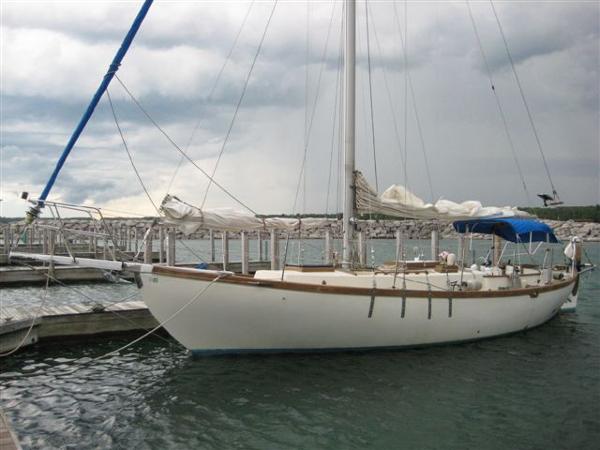
1985 Bluewater Ingrid
Muskegon, Michigan
Make Bluewater
Model Ingrid
1985 Bluewater Ingrid The Ingrid 38 from the pen of William Atkin is a heavy displacement blue water cutter derived from Colin Archer's famous double ender designed North Sea pilot boats, which in turn were inspired by Viking boats renowned for their heavy weather characteristics. Perhaps Atkin sums it up best by saying it's "the kind of boat that behaves herself in rough water and can be depended upon to sail herself". (To that part we do hear frequent mentions of the superb one-finger-on-tiller tracking and a comfortable ride.) With her old world style, Josette's a good looking boat with a sheer line reminiscent of Crealock's famous Westsail 32. Her seaworthiness is there to see in her full keel, heavy displacement and overbuilt construction. Her hull is heavily hand laid in fiberglass. There's robust outboard chain plates and an outboard rudder protected by extra fiberglass and a large bronze shoe casting should she scrub the bottom. Atkin's main rework on the Ingrid 38 from Archer's original design was finer entry on the bow which 'cushions' her landing off the waves and even may increase speed slightly. Below the waterline she has a long full keel with deep v-sections forward keeping her stable in the rough. The ballast is encapsulated and is distributed from bow to stern, to keep the weight as low as possible. Rounding this off, there's plenty of flotation designed in her ends, fore and aft which helps keep her dry. The trade off of heavy displacement and ultimate stability is usually in speed so the Ingrid 38 is not considered fast. By the numbers, her hull speed works out at 7.2 knots but she'll more often manage a consistent 6 knots while cruising. Surprisingly she's known to sail pretty well in light airs, as owners report she'll do half the wind speed in up to 8 knots of wind. However, she's a boat that comes into her own in heavier seas. The cutter rig gives plenty of options on all points of sail and she's an easy boat to single-hand. Josette is her original name and she has spent most all of her life in fresh water. She only spent one year in salt water in 1985, her original launch year. This is a one-owner vessel. The hull was built in 1974 by Bluewater Yachts in Washington state and it is reported that these are the same builders that build the Nordic Tugs. The interior cabin sides (ceiling) were finished in planking by the original owner. The hull is foam insulated to keep you cool when it is hot outside and warm when it is cold outside. The galley area is a great work space for any type of cooking. The mast is anodized aluminum construction by MetalMast Marine, with internal halyards. The hull is solid fiberglass construction and does have some gel coat surface blisters above the waterline, but they do not appear to be structural. She recently had the following engine work accomplished: new head gasket, two new exhaust valves, injector service,
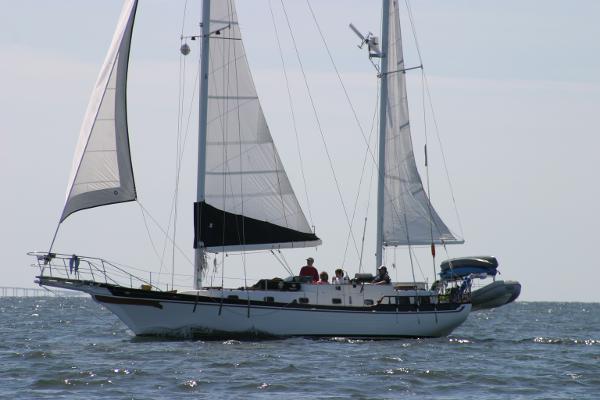
1981 ISLAND TRADER Center Cockpit Ketch
1981 Marine Trading International Center Cockpit Ketch A true classic. Arete is a heavily built blue water yacht that features striking good looks and hard to find old world teak woodwork. Solidly crafted with a full no nonsense keel she is designed to be sailed on any of the 7 seas. Below decks you will find a comfortable layout along with a galley redesigned by her knowledgeable owners. Two staterooms each with private head / shower access, a forward facing navigation station and abundant storage all combine to make this boat an excellent choice for cruising. Full Exterior Hull Detailing May , 2015!
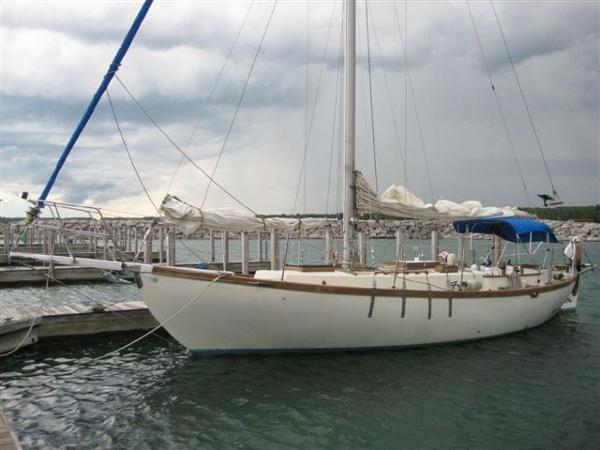
1985 Bluewater Ingrid The Ingrid 38 from the pen of William Atkin is a heavy displacement blue water cutter derived from Colin Archer's famous double ender designed North Sea pilot boats, which in turn were inspired by Viking boats renowned for their heavy weather characteristics. Perhaps Atkin sums it up best by saying it's "the kind of boat that behaves herself in rough water and can be depended upon to sail herself". (To that part we do hear frequent mentions of the superb one-finger-on-tiller tracking and a comfortable ride.) With her old world style, Josette's a good looking boat with a sheer line reminiscent of Crealock's famous Westsail 32. Her seaworthiness is there to see in her full keel, heavy displacement and overbuilt construction. Her hull is heavily hand laid in fiberglass. There's robust outboard chain plates and an outboard rudder protected by extra fiberglass and a large bronze shoe casting should she scrub the bottom. Atkin's main rework on the Ingrid 38 from Archer's original design was finer entry on the bow which "cushions" her landing off the waves and even may increase speed slightly. Below the waterline she has a long full keel with deep v-sections forward keeping her stable in the rough. The ballast is encapsulated and is distributed from bow to stern, to keep the weight as low as possible. Rounding this off, there's plenty of flotation designed in her ends, fore and aft which helps keep her dry. The trade off of heavy displacement and ultimate stability is usually in speed so the Ingrid 38 is not considered fast. By the numbers, her hull speed works out at 7.2 knots but she'll more often manage a consistent 6 knots while cruising. Surprisingly she's known to sail pretty well in light airs, as owners report she'll do half the wind speed in up to 8 knots of wind. However, she's a boat that comes into her own in heavier seas. The cutter rig gives plenty of options on all points of sail and she's an easy boat to single-hand. Josette is her original name and she has spent most of her life in fresh water. She only spent one year in salt water in 1985, her original launch year. This is a one-owner vessel. The deck and hull was built in 1974 by Bluewater Yachts in Washington state and it is reported that these are the same builders that build the Nordic Tugs. The interior cabin sides (ceiling) were finished in planking by the original owner. The hull is foam insulated to keep you cool when it is hot outside and warm when it is cold outside. The galley area is a great work space for any type of cooking. The mast is anodized aluminum construction by MetalMast Marine, with internal halyards. The hull is solid fiberglass construction and does have some gel coat surface blisters above the waterline, but they do not appear to be structural. She recently had the following engine work accomplished: New head gasket, two new exhaust valves, injector service, new

1972 Islander Yachts 40' MS
San Diego, California
Make Islander Yachts
Model 40' MS
1972 Islander Yachts 40' MS DAUNTLESS was designed by Charlie Davis as a serious blue water cruiser / live aboard. Built in Costa Mesa California this hull/model became the Islander freeport 41'. It has the same heavy duty / thick hull as the Islander Freeport 41'. She is ketch rigged with a center cockpit, full keel, wineglass hull. The center cockpit separates the full beam master suite with ensuite head and shower from the galley/salon and huge V-birth with giant closet and ensuite head. Which provides great privacy. This Coast Guard documented vessel has heavy duty construction throughout (most notably the super thick hand laid fiberglass hull). Think SAFE & STURDY ! The Dauntless has all new wiring and pluming and is solid Burmese Teak throughout, the person I bought this boat from 3 years ago paid $50,000.00 for her and put over $60,000.00 into up-grades and maintenance. With a 13'2" Beam, thereis plenty of living space, great storage and a very generous engine room with excellent access. I have been living on Her for the last few years and love to day-sail her around North Coronado and back. I can single hand her and fly four sails at once, this is knowledge that I would be happy to share with you over a couple of lessons. I just purchased a new much larger yacht and need to find a new home for DAUNTLESS. This boat needs cosmetic work like paint, varnish, cushions, curtains, etc. The guy I bought the boat from put most of his money into making sure the mechanical and operating systems were in good order at all times. If you are not handy with a paint brush you might not want this boat. For the person with basic skills I have priced the boat to move quickly. This boat in better condition would sell for $60,000 to $90,000. For all of you StarWars fans out there this yacht is like the Millennium Falcon, she's not much to look at but she has it where it counts. I have sailed all over the place and entertained countless friends on whale watching trips and parties at A-1 Anchorage, Glorietta Bay and quite dinners with that special someone to huge raft-up parities and everything in-between. This boat is designed to be safe and comfortable. All systems have been installed for simplicity, safety and durability. The Dauntless can handle gail-force winds with a reefed main and storm jib, Dauntless will take more punishment than most crew members. She needs some TLC so this is a tremendous opportunity to own a seriously built blue water sailboat that can take you anywhere in the world you desire in safety and comfort. She makes a fabulous live-aboard (witch I have been doing for the last few years). I AM GOING TO MISS DAUNTLESS BUT HOPE TO LEAVE HER IN THE HANDS OF AN ENTHUSIASTIC NEW OWNER!
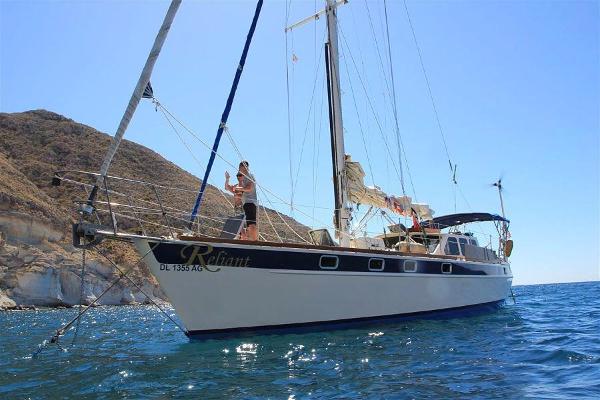
1986 Canyon Industries 43 Sloop - Refurbished 2014
Pompano Beach, Florida
Make Canyon Industries
Model 43 Sloop - Refurbished 2014
1986 Canyon Industries 43 Sloop - Refurbished 2014 This 43' sloop was completely refurbished in 2014 and is a comfortable, solid blue water sailing yacht with classic layout. The spacious cockpit, the high freeboard and the tidy bow, along with the very generously sized deckhouse salon immediately convey comfort and safety. The steel hull with its moderate long keel and the rudder skeg make the Reliant an extremely seaworthy long distance sailboat. OWNER MOTIVATED! ***BRING ALL OFFERS*** Extended warranties and financing available. *** BROKERS WELCOME *** ... Click on "FULL SPECS" for pictures and details... TRADES ACCEPTED: up or down: including boats, yachts, cars, RVs, real estate... Worldwide Delivery and Financing Available!
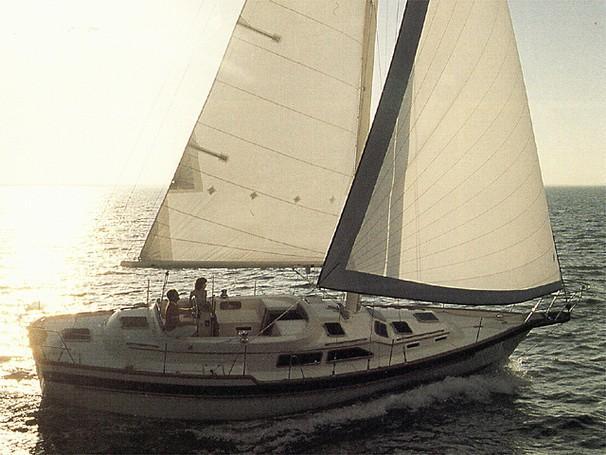
1987 Irwin 38 Mk II
Fajardo, Puerto Rico
Model 38 Mk II
1987 Irwin 38 Mk II An extremely comfortable and well-thought out cruiser, this Irwin 38 has been meticulously maintained and in 'turn-key' condition! The center cockpit model Irwins are always hard to find, and there are good reasons for this. The Irwin is known as a blue water boat with exceptional sailing capability. It is quicker than most full keel boats.The long-keel design ensures a comfortable ride at sea, and the center cockpit layout allows for an extremely roomy and useful live aboard arrangement for cruising. Soon more pictures and specs...
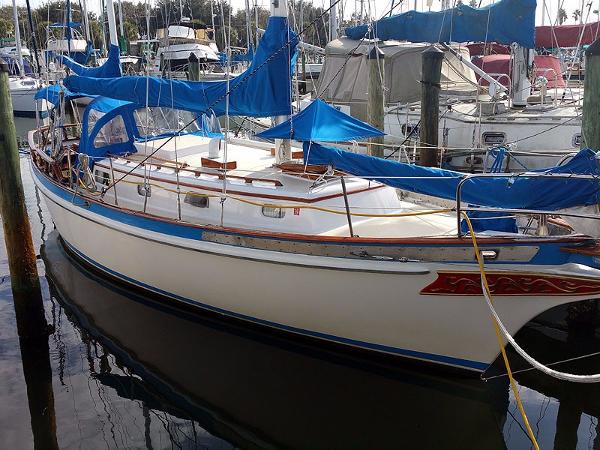
1976 Fuji Ketch
Fort Lauderdale, Florida
Model Ketch
1976 Fuji Ketch Namaste is a traditional, cutter-rigged ketch with teak toe and taff-rails, wide side decks, and a large cockpit. She has a fiberglass hull with a full keel, bow thruster and burns one gallon of diesel per hour at a cruising speed of 7 mph. The interior and exterior teak are in great condition and the decks are nonslip paint. All new canvas, cushions and upholstery (blue) were added in 2015. This much loved fresh water yacht has just traveled 2,200 miles leaving Charlevoix, Michigan in June of 2015. She has been with the current owner since 2000 and during their ownership they have made many upgrades and have maintained her well.

2006 Southerly 135 Galley UP
Charleston, South Carolina
Make Southerly
Model 135 Galley UP
2006 Southerly 135 Galley UP The Southerly 135 is the flagship of the Southerly range - the ultimate long distance cruising yacht with variable draught ability to reach lagoons and harbours that other blue water yachts have to pass by. Combined with Northshore's wealth of experience in custom design, you can make this the yacht of your dreams. Any amount of equipment can be added to enhance your creature comforts and with the Rob Humphreys design pedigree the sailing performance is assured. The Swing Keel Southerly 135 brings together the best in design and construction to provide a unique blend of performance, comfort and versatility. The twin rudder arrangement (which operates within the canoe body draft of 2'9" with the keel raised), provides easy handling and excellent sail carrying capacity. The 'tall rig' option maximises sailing performance by taking full advantage of the deep 'keel lowered' draft of 9'9", giving precise directional stability and powerful windward performance. She is a true world class cruising yacht capable of fast blue water passage making. The Southerly 135 can be easily sailed by two people. Halyard and reefing lines are fed back through the coach roof and the self tailing winches are positioned within the cockpit for easy handling. The large centre cockpit with ample stowage, is designed with both safety and comfort in mind. New Dodger & Bimini just installed, YAHOO IS GOING TO THE YARD to have a brand new awgrip paint job on the hull. Same color blue. And a new bottom job. Accommodations: High quality teak joinery, concertina blinds, tan micro-suede upholstery and new (2012) cushions and mattresses throughout. Master stateroom with centerline double berth and extensive cabinetry. Sylvania 15” f Request Information Call Now
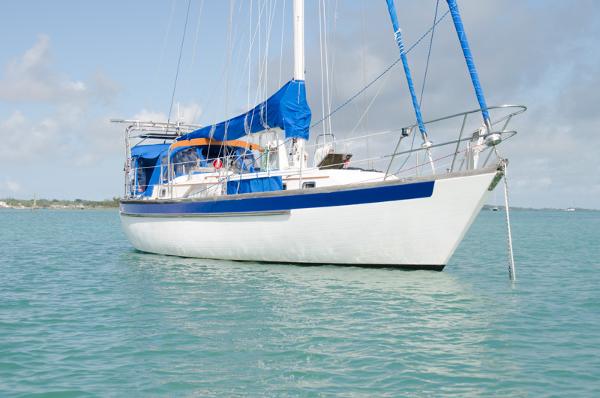
1986 Slocum Cutter
Clearwater, Florida
Make Slocum
Model Cutter
1986 Slocum Cutter Stormy Monday is a USCG Documented aft cockpit blue water cutter rigged cruiser. Designed by Stan Huntingford and built by Formosa Boat Building in Taiwan she shares the hull and interior layout with the mid-80’s Passport 42. Stormy Monday has a modified cruising keel (encapsulated) with a skeg hung rudder and is surprising fast with a nice motion when sailed hard.An amazing amount of recent upgrades include: New bimini, dodger, full enclosure, cockpit cushions (2013)Furuno chart plotter, wind, depth, radar, sirius weather (2013)Ham/SSB Icom IC-7200 and Pactor P4 modem (2013)Standard Horizon VHF w/AIS receiver integrated to plotter (2013)Balmar 80A Alternator (2013)Island Time Wifi Antenea (2013)New Standing Rigging, Full Battened Mainsail and Furling Jib (2011)New Furling Staysil (2014)Mast & Boom Refurbished (2011)New Central Air Conditioning and Heat (2014)New Spectra Watermaker Ventura 200T (2013)420watts Solar panels (2014)Non-Skid Epoxy Decks (replaced teak decks 2010)
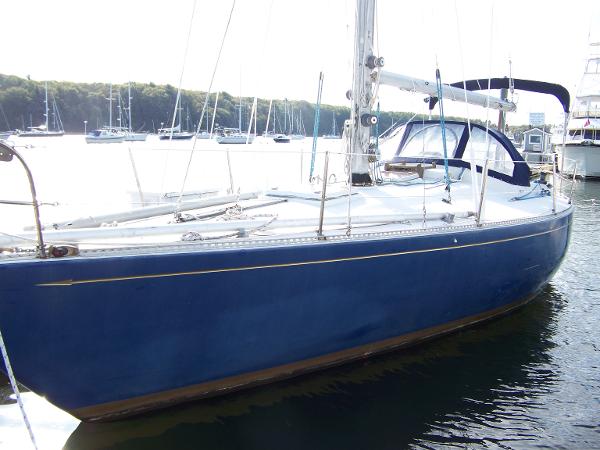
1974 Standfast - PJ Standfast 36
Make Standfast - PJ
Model Standfast 36
1974 Standfast - PJ Standfast 36 New Listing of a very reputable boat designed by Frans Maas, a successful Dutch Naval Architect that gained fame in the 60's and 70's, designing sailboats under the RORC rule and IOR. To add to the pedigree, this boat was exclusively marketed by Palmer Johnson. This is a fiberglass, not aluminum sailing yacht. This boat has been owned by a local sailor and his wife and they have enjoyed cruising the southern New England waters for many years. The boat is well maintained. It has fiberglass decks, a fin keel and a skeg for rudder support. Mast height above the water is 54'. Hull is dark blue. Boat is stored outdoors with a shrink wrap for the winter. These boats were built as Standfast Yachts. Sold in the US also as Palmer Johnson 36's. I - 48.9' (14.9m) J - 15.4' (4.69m) P - 43' (13.11m) E - 12' (3.66m) Sail Area/Disp: 15.30 Bal./Disp: 40.69% Disp/Len.: 314.84 The Standfast 36 is a strong, offshore capable boat that was designed ahead of its time. Still carrying more modern, graceful lines with a reverse transom. Boat has a comfortable interior, newer, easily accessed Yanmar 27Hp diesel, sheltered cockpit, full galley, dinghy, outboard, liferaft and plenty of extra gear. This blue-water capable boat is ready for another season, as soon as spring breaks.
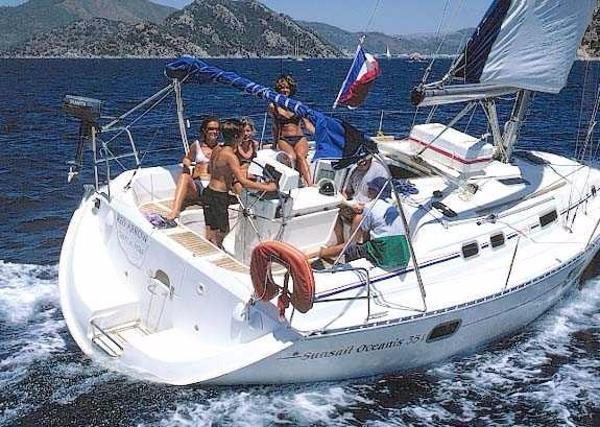
1995 Oceanis 351
Make Oceanis
1995 Oceanis 351 The Oceanis 351 was designed by Jean Berret and Phillipe Briand and produced by Beneteau between 1992 and 1997. Her sleek lines offer fast and efficient sailing and cruising, and her full-length galley and generous sized cabin are sure to prove popular amongst those seeking a genuine live-aboard cruiser for a longer trip. The Oceanis 351 was designed for blue water cruising and sailing speed, and her bulb keel cuts an easy passage through the waves. Despite more conservative estimates from her manufacturer, she easily reaches an impressive 7 knots in good winds and 10 knots when cruising. She shares her hull with the Beneteau First 35.7, and her maximum waterline length and wide beam make for excellent stability in all weathers. In rough seas and strong winds, the Oceanis 351 has a good solid feel, whether under sail or in port. The roller-furling main and genoa make for nice easy rigging and this is a yacht that makes for easy and safe light or short-handed sailing. The trademark balsa and fibreglass 'sandwich deck', also used on the Groupe Finot Oceanis, gives extra protection without weight. The downside of this light weight is that, when combined with a less powerful engine than some of the more recent Oceanis models, the Oceanis 351 performs less well in light winds. Below decks, the Oceanis 351 truly comes into her own as yacht that was made for long distance blue water cruising. The salon and galley offer full headroom (1.9m) and there are two equal size aft cabins and a forward owner's cabin, all of which are generously sized. The galley runs the whole length of the large, U-shaped salon, and even the cockpit is big enough to seat the whole crew (with an icebox under the table to keep everyone happy too). Light and ventilation below decks is also excellent, thanks to the four portholes in the hull and deck. On the whole the accommodation is well set out for longer distance sailing, with plenty of nice touches such as the window above the sink for your resident galley slave to admire the view and the large hanging lockers in the cabins. The Oceanis 351 makes an excellent choice if you are looking for a genuine ocean-going yacht that has enough accommodation and performance for a longer trip.
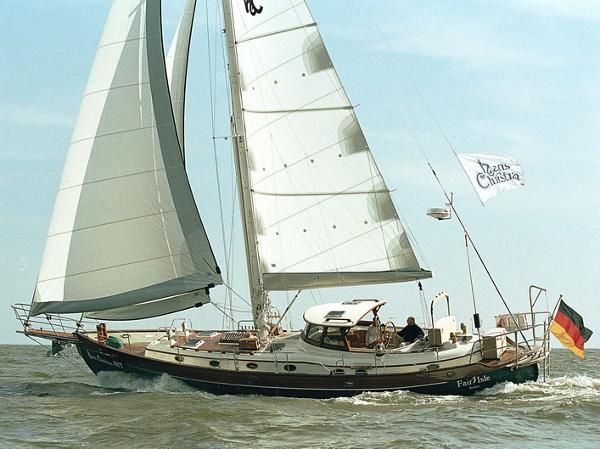
2016 Hans Christian Yachts 48 Traditional Cutter/Ketch
Request Price
Dana Point, California
Make Hans Christian Yachts
Model 48 Traditional Cutter/Ketch
2016 Hans Christian Yachts 48 Traditional Cutter/Ketch The Queen of the Hans Christian fleet has been proven over the decades as one of the worlds finest cruising yachts. All the specifications prove this out along with up to 12 year circumnavigations. Consider the High bulwarks, the custom teak work that can be as much or as little as you wish, The cutaway forefoot that allows quick tacking along with plenty of room for an optional bow thruster. Think of the masterful craftsmanship found in the interior and exterior, think of the fully hung rudder that is massive and fastened to the entire trailing edge of the keel, consider the propeller armature that protects the prop from lines and floating objects that are impossible to avoid. These blue water cruisers offer a great deal to all true sailors, in all conditions found at sea. There are many options such as full 1" stainless steel railing around the boat, bow thrusters, custom teak rub rails with bronze or stainless strikers, mast pulpits with pin rails and dunnage boxes, custom deck house for cockpit, full electronic packages that are installed at the area of commissioning. Generators up to 8KW, air conditioning, watermakers. and you name it, we can do it as long as it falls into the design objectives. These boats are all built to custom order, so a price must be quoted by the total picture. Shipping costs from your Thailand yard vary depending on the port of entry. ,
Narrow Results
Current search reset all.
- Keyword: full keel blue water sailboats
- Bluewater (3)
- Hans Christian (2)
- Bristol (1)
- Canyon Industries (1)
- Catalina (1)
- Cheoy Lee (1)
- Gulfstream (1)
- HERITAGE YACHT CORP (1)
- Hans Christian Yachts (1)
- Island Trader (1)
- Islander Yachts (1)
- Jeanneau (1)
- Mason 44 (1)
- Ocean Voyager (1)
- Oceanis (1)
- Skookum Marine (1)
- Southerly (1)
- Standfast - PJ (1)
- Sailboats (21)
- Cruiser Motorcycles (5)
- Sloop Sailboats (3)
- Florida (14)
- Michigan (4)
- California (2)
- Georgia (2)
- Pennsylvania (2)
- Washington (2)
- Maryland (1)
- North Carolina (1)
- Puerto Rico (1)
- South Carolina (1)
- POP Yachts (1)
- Search Title Only
- Has Picture
- Include Sold Listings
Showcase Ads

2015 Rinker 276 captiva
Chesterfield Twp, MI

2014 Cobalt Boats A28

2004 Four Winns 268 Vista
Eastwood, KY

2006 Boston Whaler 150 Montauk
Chenequa, WI

2015 Robalo 226 Cayman
Cleveland Heights, OH

2005 Grady-White 232 Walkaround
North Kingstown, RI
Create Alert
Please, name this search
Select Interval
Alert Successfully Created
13 Most Popular Swing Keel Sailboats Worth Considering
A swing keel sailboat allows you to explore shallower waters and launch your boat at shallow ramps with greater ease than a fixed keel. Additionally, swing keel sailboats are typically more affordable than fixed keel sailboats. In this article, we will introduce you to the 13 most popular swing keel sailboats that you may want to consider.
The 13 most popular swing keel sailboats that you may find worthy to consider are the following: Catalina 22, MacGregor 26, Hunter 22, Precision 23, O'Day 22, Beneteau First 235, Seaward 25, Islander Bahama 24, Watkins 27, Com-Pac 23, Montgomery 17, San Juan 23, and West Wight Potter 19.
The estimated pricing for the boats with swing keels ranges from $5,000 to $40,000. Let's take a look at which models are the most affordable and which are priced higher.
- Catalina 22 has a swing keel that is made of lead and can be raised and lowered using a winch system.
- The MacGregor 26 has a water ballast system in addition to its swing keel, which provides additional stability and helps keep the boat upright in rough conditions.
- The San Juan 23 is a fast and responsive swing-keeled sailboat that has a sail area-to-displacement ratio of 18.8.
- The Watkins 27 is a fast swing keel sailboat that has a reported top speed of around 7 knots.
- The O'Day 22 features a swing keel that is retractable and allows it to sail in waters as shallow as 2 feet.
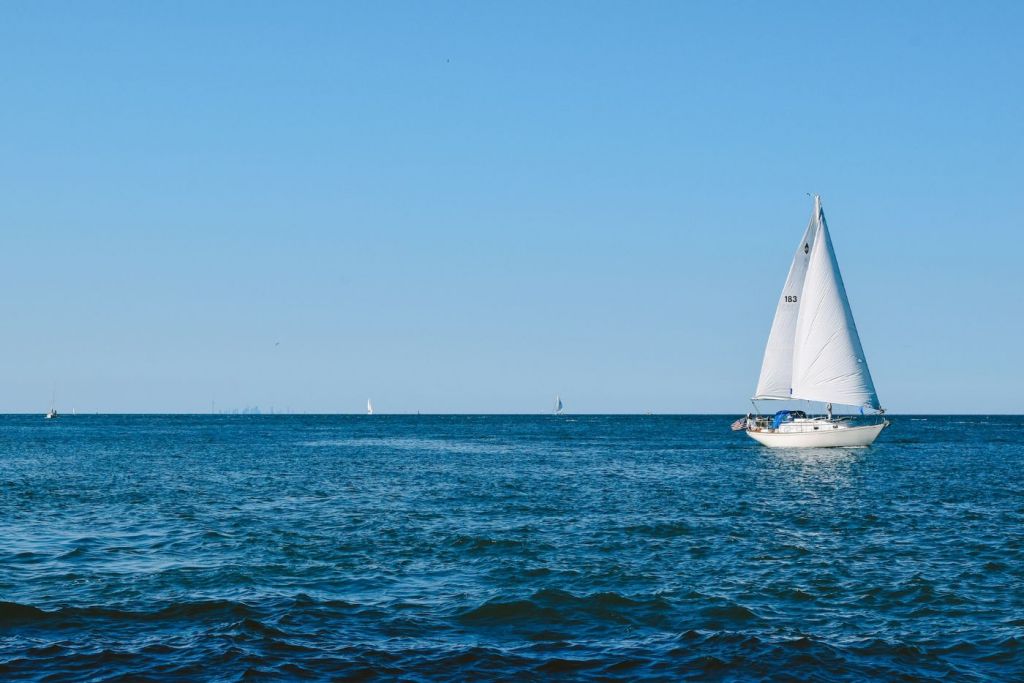
On this page:
Catalina 22, macgregor 26, precision 23, beneteau first 235, islander bahama 24, san juan 23, west wight potter 19, montgomery 17.
Below is a table summarizing why each of these swing keel sailboats is worth considering, as well as their estimated market price in case you'd proceed with buying them:
The Catalina 22 is a popular sailboat model that has been in production since 1969. It is known for its versatility, ease of use, and affordability. One of the key features of the Catalina 22 is its swing keel, which allows it to be easily trailered and launched in shallow waters.
The swing keel on the Catalina 22 is made of lead and is attached to a cable that runs through a slot in the hull. The keel can be raised and lowered using a winch system, which allows the boat to navigate in shallow waters or be easily transported on a trailer.
When the keel is lowered, it provides stability and helps the boat sail upwind. When the keel is raised, the boat can be easily maneuvered in shallow waters or on a trailer.
This makes the Catalina 22 an ideal sailboat for those who want the flexibility to sail in a variety of conditions and locations. Catalina 22 is also a very affordable swing keel sailboat option. If you're curious about how much it costs to buy and own a sailboat , you can take a look at our article.
The MacGregor 26 is a popular trailerable sailboat that was first introduced in 1986. One of its unique features is the swing keel water ballast system, which allows the boat to be easily transported on a trailer and launched at various locations.
The swing keel is a retractable keel that can be raised or lowered depending on the water depth. When it is lowered, it provides additional stability and helps the boat track better through the water. When it is raised, the boat can be easily transported on a trailer.
The water ballast system is another unique feature of the MacGregor 26. The boat has two water tanks located on either side of the keel, which can be filled with up to 1,500 pounds of water. This water ballast provides additional stability and helps keep the boat upright in rough conditions.
If you're interested to know more about how sailing ballasts work , here's an article that can give you more information.
The Hunter 22 with a swing keel is a great sailboat for those who are looking for a versatile and easy-to-handle vessel. The swing keel allows the boat to navigate in shallow waters and provides better stability in deeper waters, so it is ideal for those who enjoy sailing in a variety of conditions and locations.
In addition, the Hunter 22 is a relatively affordable sailboat, making it a great option for those who are just starting out in sailing or who want to own a sailboat without breaking the bank. It is also a popular choice for families, as it can comfortably accommodate up to four people.
The Hunter 22 has a rich history, with the first model being introduced in 1973. Since then, the boat has undergone several design changes and upgrades, with the current model featuring modern amenities and technology.
The Precision 23 is a popular swing keel sailboat that is well-regarded for its versatility and performance. The swing keel design allows the boat to be easily launched and retrieved from a trailer.
One of the benefits of the Precision 23's swing keel design is its ability to sail in shallow waters. With the keel up, the boat has a draft of just 1'8", which allows it to navigate in areas that would be inaccessible to deeper-draft boats, such as coastal areas, bays, and estuaries.
When the keel is lowered, the Precision 23 has a draft of 5'0", which provides excellent stability and performance under sail. The boat is designed to be easy to handle, with a simple rig that is easy to set up and adjust. The spacious cockpit provides plenty of room for the crew to move around, and the cabin is well-appointed with all the amenities needed for comfortable cruising.
The O'Day 22 features a swing keel that is retractable and can be raised or lowered depending on the depth of the water. This feature allows the O'Day 22 to sail in waters as shallow as 2 feet, making it ideal for exploring shallow coves and bays.
This sailboat has a spacious cockpit, making it comfortable for day sailing or weekend trips. The cabin is compact but efficient, with a small galley, a portable toilet, and sleeping accommodations for up to four people.
The O'Day 22 is a popular choice for sailors of all skill levels, from beginners to experienced sailors. Its ease of use, versatility, and affordability make it a great choice for anyone looking for a reliable and fun sailboat.
The Beneteau First 235 is a popular sailboat that was first introduced in the early 1980s. It is a swing keelboat, which means that it has a retractable keel that can be raised or lowered depending on the depth of the water.
The boat is 23.5 feet long and has a beam of 8 feet so it is a relatively small boat that is easy to handle. It has a displacement of around 2,500 pounds, making it light, and can be easily towed behind a car.
The Beneteau First 235 is a popular boat because it is a well-designed and well-built sailboat that is both fast and easy to handle. The boat has a relatively narrow beam, which allows it to cut through the water with less resistance and achieve higher speeds.
Additionally, the boat has a relatively large sail area, which means that it can catch more wind and generate more power. The boat's hull shape is also optimized for speed, with a deep V-shaped hull that helps to reduce drag and increase stability. Deep-V hulls are one of the most stable boat hull designs .
The Seaward 25 is a swing-keeled sailboat that was designed by Hake Yachts and is popular among sailors who are looking for a versatile and easy-to-handle boat for both cruising and racing.
In addition to its swing keel, the Seaward 25 is also known for its spacious and comfortable interior. The boat has a large V-berth and a convertible dinette that can comfortably sleep up to four people. The boat also has a galley with a sink and a stove, as well as a private head with a marine toilet.
Another reason why the Seaward 25 is popular is because of its speed and maneuverability, making it a great choice for sailors who want to race or cruise at a fast pace. The boat is also relatively easy to handle so it can be sailed even by beginners.
The Islander Bahama 24 is a popular swing keel sailboat designed by Robert Finch and built by Islander Yachts from 1977 to 1982. It is a small, versatile sailboat that is great for day sailing, weekend cruising, and even racing.
The Bahama 24 has a spacious cockpit that can comfortably seat four people, and its interior is surprisingly roomy for a boat of its size. It has a V-berth forward, a dinette that converts into a double berth, and a quarter berth aft. There is also a small galley with a sink and a portable stove, as well as a marine head.
The Bahama 24 is a solid performer. It has a moderate sail area and a well-balanced rig, which makes it easy to handle in a variety of wind conditions. It is also known for its stability and its ability to sail close to the wind.
The Watkins 27 is a popular swing keel sailboat that was manufactured in the United States by Watkins Yachts from the mid-1970s to the early 1980s. It was designed by Walter Scott and is known for its spacious interior and good sailing performance.
The Watkins 27 has a length overall of 27 feet and a beam of 9 feet, 4 inches. It has a displacement of around 6,000 pounds. The boat has a spacious interior with a comfortable salon, galley, head, and sleeping accommodations for up to six people.
In terms of sailing performance, the Watkins 27 is known for being a good all-around performer. It has a moderate sail plan and a relatively low aspect ratio, which makes it easy to handle and forgiving for novice sailors. It is also a reasonably fast boat, with a reported top speed of around 7 knots.
The Com-Pac 23 is a popular swing keel sailboat that has been in production since the early 1980s. It is a versatile boat that can be used for cruising, racing, and day sailing. It is also a fast boat that can easily reach speeds of 6-7 knots in moderate winds.
The Com-Pac 23 has a spacious cockpit that can comfortably seat up to six people. The boat is also equipped with a cabin that can sleep up to four people and has a galley with a sink, stove, and icebox. The headroom in the cabin is generous for a boat of this size, and the layout is designed to maximize space and comfort.
The San Juan 23 is a popular swing keel sailboat that was first introduced in the early 1970s. It was designed by Bruce Kirby and built by Clark Boat Company in Kent, Washington. The boat was designed to be a versatile and affordable sailboat that could be used for cruising, racing, and day sailing.
Another feature that makes the San Juan 23 popular is its spacious cockpit and comfortable interior. The boat can accommodate up to four people and has a small galley, a head, and a V-berth. The cabin is well-ventilated and has plenty of natural light, making it a comfortable place to spend time below deck.
The San Juan 23 is a fast and responsive sailboat. It has a sail area-to-displacement ratio of 18.8, which means that it can achieve high speeds even in light winds. The boat is also very stable, which makes it easy to handle in rough conditions.
The West Wight Potter 19 is a popular swing keel sailboat that has been in production since the early 1970s. It is known for its versatility, durability, and ease of use, making it a popular choice among sailors of all skill levels.
Aside from its swing keel, it also has a relatively wide beam and a low center of gravity, which helps to keep it stable in a variety of conditions. The cockpit is spacious and comfortable, with plenty of room for passengers and crew.
In terms of performance, the West Wight Potter 19 is not the fastest sailboat on the water, but it is known for its ability to handle a variety of conditions. The boat is easy to sail and can be handled by a single person, so it is great for solo sailors or couples.
The Montgomery 17 is a popular sailboat designed by Lyle C. Hess and built by Montgomery Marine Products. One of the unique features of this sailboat is its swing keel, which allows it to be easily transported on a trailer and launched in shallow waters.
The Montgomery 17 has a classic design with a cabin that can sleep up to four people. It has a simple rigging system that makes it easy to sail, even for beginners. The sailboat is also known for its durability and has been used for long-distance cruising and racing.
Leave a comment
You may also like, what is a swing or lifting keel 14 pros and cons explained.
If you need to know what a swing keel is, like me, this article is for you. I'm trying to decide what keel type is right for me, so I dove into the swing keel.
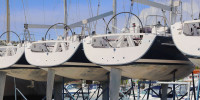
Centerboard (Swing Keel) vs. Fixed Keel: Pros and Cons
Sailboat keel types: illustrated guide (bilge, fin, full).
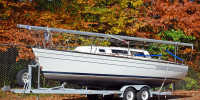
13 Popular Trailerable Sailboats with Lifting Keels

What's the Best Keel Design for Bluewater Sailing?
Own your first boat within a year on any budget.
A sailboat doesn't have to be expensive if you know what you're doing. If you want to learn how to make your sailing dream reality within a year, leave your email and I'll send you free updates . I don't like spam - I will only send helpful content.
Ready to Own Your First Boat?
Just tell us the best email address to send your tips to:

5 Best Liveaboard Bluewater Sailboats

Last Updated by
Daniel Wade
December 28, 2023
Liveaboard bluewater sailboats are both comfortable to live on and capable of making long, offshore ocean voyages.
The best liveaboard bluewater sailboats must strike a balance between comfort and seakeeping abilities. These boats are generally heavy and stable and roomy enough to spend time in. They must also include the necessary hardware to make cooking, sleeping, and bathing possible in choppy conditions.
Table of contents
Bluewater Liveaboard Sailboat Design
What makes a good bluewater liveaboard sailboat , and how is it different from a coastal cruiser? There are a few aspects of purpose-built bluewater sailboats that make them different from most production vessels. The first and (possibly) most important is the hull design.
The classic bluewater sailboat hull shape features a long, deep, full keel. The keel acts as a hydroplane and keeps the boat stable on course in all sea conditions. Deep keel sailboats aren't the only kind of bluewater-capable vessels, but they're a tried and tested design.
Other vessels gain stability from having a wide beam. Beamy sailboats are far more comfortable in rolling seas, as they tend to buffett and pitch much less than leaner, narrow boats. Most ideal liveaboard bluewater sailboats balance length and beam carefully to make the most of the space and hull shape.
Space is another important quality to consider when choosing the best bluewater liveaboard sailboat. Interior space comes first, as living quarters are a key element of comfort.
Cockpit space should also be considered, especially if more than one person comes aboard. Most liveaboard bluewater sailboats sacrifice cockpit space for cabin space.
A comfortable liveaboard sailboat should include several amenities, including a head (toilet), a shower, two sinks, a galley with a stove, an icebox, a place to eat, and a place to sleep. Ideally, the dining area is separate from the primary sleeping area.
A separate chart table is ideal as well because it keeps food and clutter away from important navigational equipment. A chart table is less important on liveaboard sailboats that spend the majority of their time docked. That said, the chart table functions well as a spot for a microwave, toaster oven, or TV when you're not underway.
A separate forward V-berth, known as a master cabin, is a big plus on liveaboard boats. Separating the sleeping area from the rest of the cabin can increase comfort and coziness.
However, on a bluewater sailboat, a side berth near the hatch is essential as well. This is because you may need to quickly take control of the vessel after waking up, and it's best to sleep close to the helm.
Power and Water
Power and water shouldn't be overlooked when choosing a bluewater liveaboard. Many liveaboards spend most of their time docked and hooked up to shore power, water, and sewage. But bluewater liveaboards are designed for cruising, which means everything must be self-contained.
The best bluewater sailboats have sufficient freshwater storage tanks for several weeks on the water. Some have desalination (water maker) machines, which require electricity to run.
Solar panels are an excellent option for power generation, and they can be installed on almost any sailboat.
But all bluewater sailboats should have battery banks and a gasoline or diesel generator built into the system. On many vessels, the inboard engine also functions as a generator.
Safety is an essential factor to consider when choosing a cruising sailboat , especially if it doubles as your primary residence. Basic safety equipment such as bilge pumps and radios should be maintained and tested regularly. Backups and spare parts should also be kept aboard.
Other safety features, such as watertight hatches, can keep your cabin safe and dry during inclement weather. Self-draining cockpits are helpful when sailing offshore, as spray and waves drain from the exposed cockpit without the use of electric or mechanical pumps. If the drain ports are kept clean, no bailing is ever necessary.
Radar is another useful safety feature that, while not mandatory, can keep you in-the-know and alert you to the presence of nearby ships. Radar is especially useful at night, as the automatic alarms can wake you whenever a potential obstacle appears nearby.
Bluewater Sailboats for Living Aboard and Cruising
Living aboard a sailboat is one of the most interesting and rewarding lifestyles available today. It's even more alluring when you can sail your vessel across oceans, which is what bluewater sailboats are designed to do.
A liveaboard cruising sailboat combines comfort, seakeeping ability, and ease of handling in a compact and thoughtfully-designed package. Here are the best liveaboard sailboats for bluewater cruising.
1. Pacific Seacraft Flicka 20
{{boat-info="/boats/pacific-seacraft-flicka-20"}}
The Flicka 20 is the smallest and most interesting sailboat on our list. At only 20 feet overall in length, the interior accommodations of this vessel are spartan at best and suitable for minimalist living.
What makes the Flicka 20 stand out is its exceptional bluewater performance. This sailboat is truly an ultracompact pocket cruiser. With a full ballast keel, self-draining cockpit, and wide beam, the Flicka 20 is more capable offshore than some boats almost twice its size.
This sailboat has the profile of a traditional keel cruiser. From a distance, it would be easy to mistake for a much larger vessel. Its hull shape, manageable Bermuda rig, and small size make it a perfect starter sailboat for single handed offshore cruising.
Inside, you have (almost) everything you need to live comfortably, albeit in a minimalist way. The cabin features standing headroom throughout, which is highly unusual for a 20-foot sailboat. On the port side, you're greeted with a small but functional galley. On the starboard side, there's a small head with a toilet and a shower.
The Flicka 20 displaces a hardy 5,500 lbs. Due to its large keel, there's no centerboard trunk to obstruct interior space. A V-berth upfront makes up the sleeping accommodations, and some models feature settees on both sides with a pop-up dining and chart table in between.
The Pacific Seacraft Flicka 20 has achieved somewhat of a cult status amongst bluewater sailboat enthusiasts. Only about 400 were built, so purchasing a Flicka 20 is somewhat of a rare and expensive proposition. That said, the benefits of owning a 20-foot bluewater liveaboard sailboat are hard to beat.
Cheap slip fees, low maintenance costs, and simplicity are the major selling points of this vessel. It's trailerable behind most heavy-duty pickup trucks and technically small enough to store on the street or in a driveway.
2. Pacific Seacraft Allegra 24
{{boat-info="/boats/pacific-seacraft-allegra-24"}}
If the Flicka 20 is too small for your taste, try the Pacific Seacraft Allegra 24. It follows the same design principles of the Flicka 20, but with four feet of additional space for cabin amenities and seaworthiness.
Four feet may not sound like a lot, but it makes a world of difference on a sailboat. The additional space on the Allegra 24 adds room to the head, extends the port and starboard settees, and increases the size of the galley.
If you like the idea of a small, semi-trailerable offshore sailboat with liveaboard amenities, you'll love the Allegra 24. This stout sailboat has almost miraculous handling and seakeeping qualities while retaining the benefits of small overall size.
With the Allegra 24, you'll be able to make virtually any offshore passage and save on slip fees, maintenance costs, and overall labor. This vessel is easy to sail single handed and large enough for a minimalistic couple to live, eat, and sleep comfortably.
The Pacific Seacraft Allegra 24 is not ideal for people who need space for pets, children, or guests, as the interior is quite small when compared to other sailboats. That said, there's enough room for an occasional passenger, and the cockpit is comfortable enough for four adults to sit and interact.
3. O'Day 28
{{boat-info="/boats/oday-28"}}
The O'Day 28 is a popular sailboat that makes a great liveaboard cruising platform. This affordable vessel was produced between 1978 and 1986, and over 500 examples were produced over the years.
All in all, the O'Day 28 is a stout cruising sailboat that's suitable for offshore and coastal sailing. It features a raked stern and hidden rudder, and a helm that's similar to what you'd find on much larger boats.
The O'Day has a large fuel tank for its inboard engine and an even larger 25-gallon freshwater capacity, which is excellent for offshore cruising. Additional tanks can be added in storage spaces, making the O'Day 28 suitable for long voyages.
The cabin of the O'Day 28 is spacious and includes everything you'd need to live aboard comfortably, along with plenty of storage space throughout. The wide beam of the O'Day 28 gives it lots of space, so the cabin doesn't feel cramped for its size.
Two models of the O'Day 28 were built; one featured a swing keel, and the other had a fixed swing keel. The swing keel model is ideal for coastal cruising and shallow-water sailing, while the fixed keel O'Day 28 is more suited for bluewater cruising.
That said, both keel variants make fine offshore sailboats. The cabin of the O'Day 28 features a large galley with a stove and icebox, two large settee berths, a large center table ahead, and a V-berth forward. The head serves as a separator to the forward cabin, giving the V-berth an extra layer of privacy.
4. William Atkin "Eric" 32
{{boat-info="/boats/atkin-co-eric-32"}}
"Eric," designed in the 1920s by famous marine architect William Atkin, is a radical departure from typical modern liveaboard sailboats. However, as a bluewater liveaboard sailboat, this vessel likely outshines all the others on this list in almost every conceivable way.
Eric is a 32-foot traditional wooden ketch. This planked full- keel sailboat displaces over 19,000 lbs and has a draft of about five feet. The basic design of the hull is based on early Norweigian fishing boats, which were known for their resilience in rough North Sea storms.
Eric is a traditional gaff-rigged vessel with two short masts and a long bowsprit. Though complex to rig, it sails beautifully in all weather conditions. One of the earliest examples built survived a hurricane offshore in the 1930s, and subsequent models have completed numerous long-range ocean voyages.
Eric is a purpose-built long-range ocean cruiser. Interior accommodations are spacious and designed for comfort and utility. Unlike most sailboats of the time, Eric features a full head with shower, a 'master cabin' style V-berth forward, a full galley with an icebox, and standing headroom throughout.
William Atkin's Eric is, by all definitions, an ocean-crossing sailboat designed to take between one and four adults just about as far as they want to go. It has all the qualities of an oceangoing sailboat in a compact package, along with excellent seakeeping characteristics.
The primary drawback of this 32-foot Atkin sailboat is maintenance. Most of these hulls were constructed using traditional oak planking, which lasts forever if taken care of but requires skilled maintenance. The planks are caulked using cotton wadding, and they'll need recaulking if the boat stays out of the water for too long and "dries up."
If you're looking for a beautiful and historic liveaboard sailboat with serious offshore cruising capabilities, consider an Atkin Eric 32. Although somewhat rare, examples of this design occasionally pop up for sale on the used market.
5. Pearson 35
{{boat-info="/boats/oday-28"}}, {{boat-info="/boats/pearson-35"}}
The Pearson 35 crosses the rubicon into the 'big boat' category, as it has everything you'd expect of a large oceangoing sailboat. The vessel also has a unique displacement keel with an additional swing keel at the base.
The Pearson 35 is a roomy sailboat with excellent seakeeping abilities and a large sail plan. It's a typical Bermuda-rigged sloop with a tall mast and the usual sheet and halyard arrangement. As a result, it's fun to sail and easy to handle. It's also a fast boat, making it ideal for longer voyages.
The swing keel certainly doesn't make the Pearson 35 a shoal-draft sailboat. It has a modified full keel which (with the swing keel retracted) draws 3 feet 9 inches. With the additional swing keel down, the draft of the Pearson 35 increases to over 7 feet.
The Pearson 35 is a heavy boat with good sea keeping abilities. It was introduced in 1968, and over 500 units were produced. That makes it one of the more popular sailboats in its class, and plenty of Pearson 35s are still sailing around the United States.
Down below in the cabin, the Pearson 35 is roomy and comfortable. It features a full galley, an enclosed head with a shower and sink, and several berthing areas, including a forward V-berth. Plenty of storage is available throughout the cabin, making the Pearson 35 an excellent choice for living aboard.
There's something empowering about piloting a 35-foot sailboat through rough weather. The size of the boat provides both safety and a sense of security, which can help you keep a clear head during stressful situations at sea. The vessel is beamy as well, making it less likely to heel aggressively and increasing roll comfort in dicey seas.
Overall, the Pearson 35 is an excellent choice for a liveaboard bluewater sailboat. It's a large boat in comparison to the others on this list, and it's known for easy handling and excellent windward performance. The Pearson 35 is a common sailboat that's widely available on the used market.
Related Articles
I've personally had thousands of questions about sailing and sailboats over the years. As I learn and experience sailing, and the community, I share the answers that work and make sense to me, here on Life of Sailing.
by this author
Best Sailboats
Most Recent

What Does "Sailing By The Lee" Mean?
October 3, 2023

The Best Sailing Schools And Programs: Reviews & Ratings
September 26, 2023
Important Legal Info
Lifeofsailing.com is a participant in the Amazon Services LLC Associates Program, an affiliate advertising program designed to provide a means for sites to earn advertising fees by advertising and linking to Amazon. This site also participates in other affiliate programs and is compensated for referring traffic and business to these companies.
Similar Posts

Affordable Sailboats You Can Build at Home
September 13, 2023

Best Small Sailboats With Standing Headroom

Best Bluewater Sailboats Under $50K
Popular posts.

Best Liveaboard Catamaran Sailboats

Can a Novice Sail Around the World?
Elizabeth O'Malley
June 15, 2022

4 Best Electric Outboard Motors

How Long Did It Take The Vikings To Sail To England?

10 Best Sailboat Brands (And Why)
December 20, 2023

7 Best Places To Liveaboard A Sailboat
Get the best sailing content.
Top Rated Posts
Lifeofsailing.com is a participant in the Amazon Services LLC Associates Program, an affiliate advertising program designed to provide a means for sites to earn advertising fees by advertising and linking to Amazon. This site also participates in other affiliate programs and is compensated for referring traffic and business to these companies. (866) 342-SAIL
© 2024 Life of Sailing Email: [email protected] Address: 11816 Inwood Rd #3024 Dallas, TX 75244 Disclaimer Privacy Policy

Robb Report
8 Fascinating Facts About ‘Kokomo,' the Lightning-Fast 192-Foot Sailing Superyacht
Posted: March 15, 2024 | Last updated: March 15, 2024
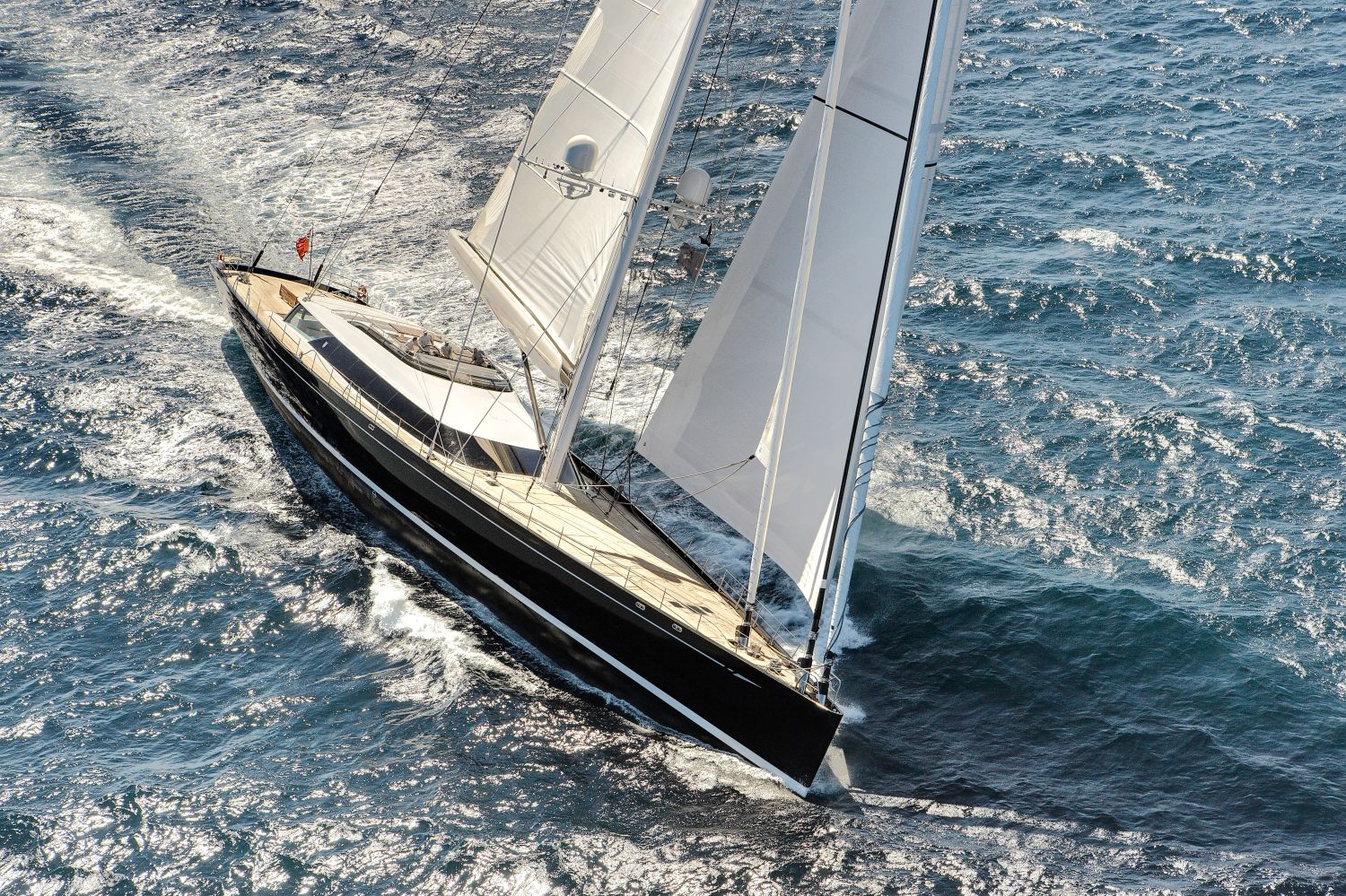
2.-SY-Kokomo_Sailing_1-064
The 192-foot Kokomo was the second largest sloop in the world when it launched from New Zealand’s Alloy Yachts shipyard in 2010. It remains the largest fast-cruising sloop available for charter. The yacht’s commissioning owner Lang Walker (who died in January 2024) was a seasoned sailor who gave all three of his yachts the same name.
The first was a 131-foot sloop, which Walker replaced five years later with a 171-footer. The same day he took delivery of his 171-foot sloop, he placed an order for the third and final 192-foot Kokomo, which he planned to use for racing and cruising around the world. He also kept the same design team for all three yachts, with exterior and naval architecture by Ed Dubois and interior by UK’s RWD.
The reference to the yacht’s name has had different explanations over the years, ranging from the pseudonym of a composer whose music Walker played as a child to a nod to the Beach Boys’s song from their 1988 album Still Cruisin’, which references a fictional utopian island called Kokomo. The island fantasy was brought to life in 2011 when Walker acquired a private island in Fiji’s Great Astrolabe Reef and named it Kokomo.
Here are eight unknown facts about one of the most game-changing sailing yachts on the water.
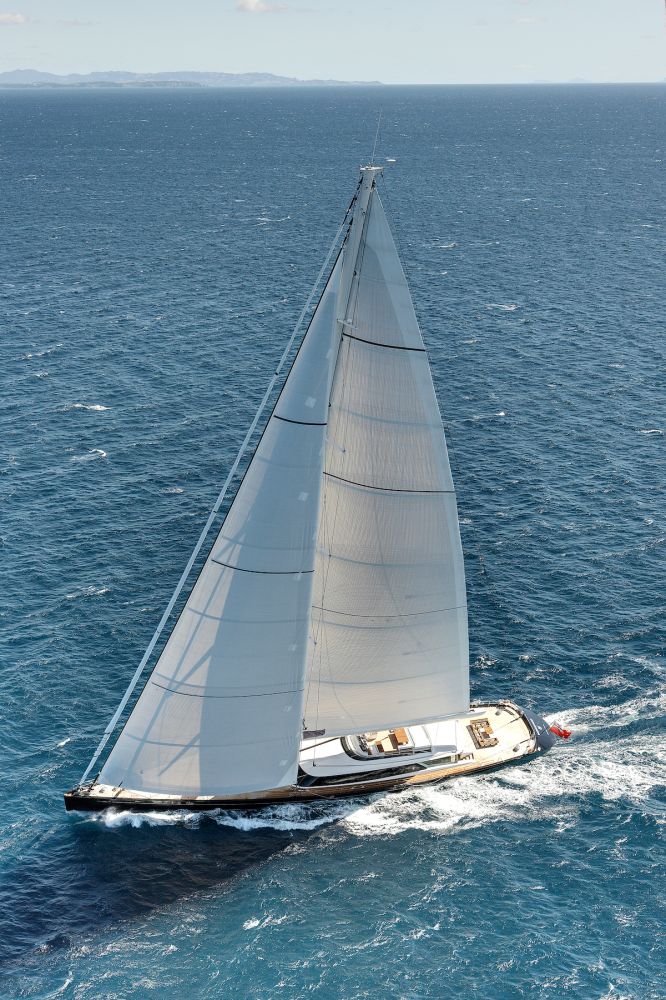
You’re Going to Need a Bigger Boom
When Kokomo was launched, she was the second-largest sloop in the world and carried the largest set of sails made by Doyle Sails in New Zealand. The 23,971-square-foot asymmetric spinnaker is half the size of a professional football field, while the 9,688-square-foot mainsail needs a crane to lift it. Because of the gargantuan size of the sails, the designers entered a new era of spar and winch design, having to “reinvent” the deck equipment—winches, mast, boom, rigging and sails—to cope with the 31.6-ton load on the genoa sheet and 32-ton load on the main sheet clew. The 244-foot carbon mast is the largest ever made by Southern Spars.
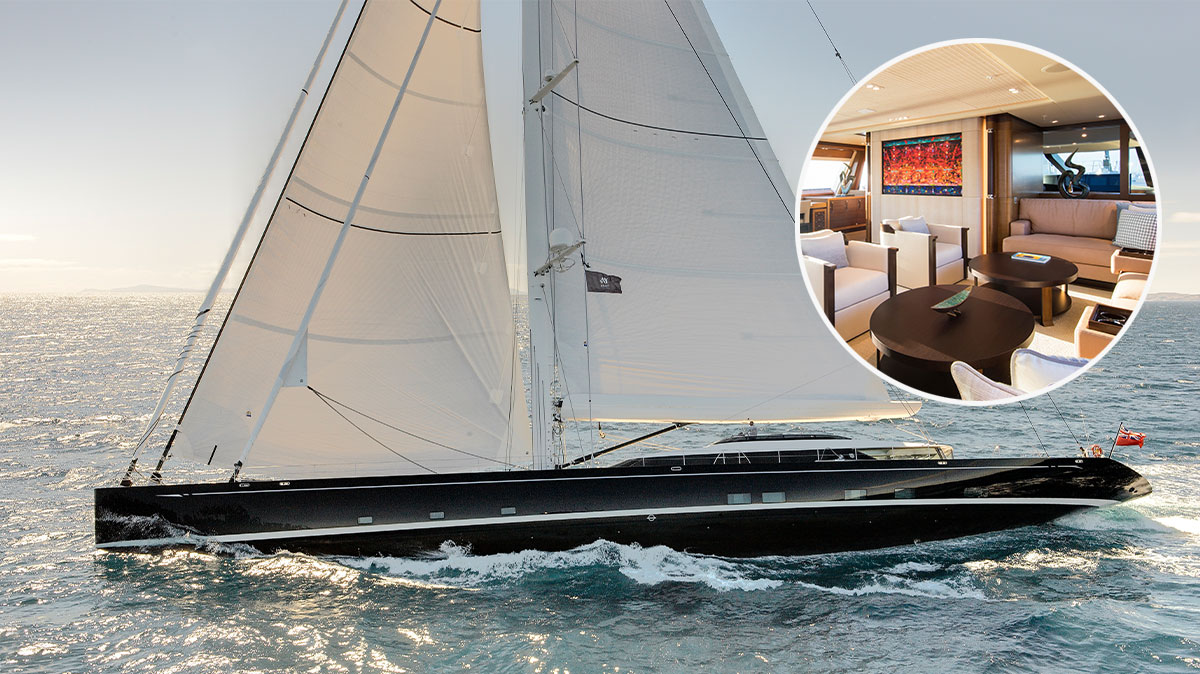
A Hidden Lifting Keel
The yacht’s 130-ton lifting keel is one of its most impressive features, though it’s largely left to the imagination. The interior layout is carefully designed so that the keel structure remains hidden. Dubois Naval Architects positioned the keel box to come above the main deck, serving as a partial separation between the bridge and the main salon (see inset). Kokomo was only the second yacht to be fitted with a lifting a keel, the first being 246-foot M5 (ex-Mirabella V), the world’s largest single-masted sailing yacht. This innovative design shortens Kokomo’s 28.5-foot draft when the keel is fully extended, to just 15 feet for shallow waters.
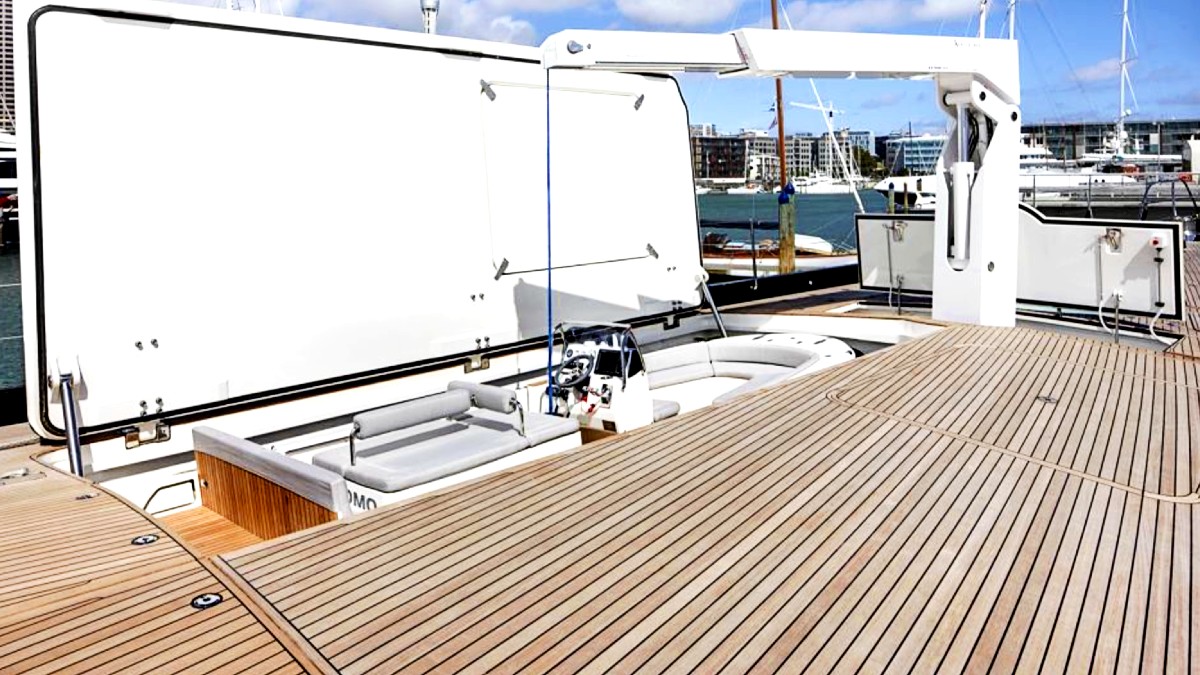
Now You See It, Now You Don’t
Kokomo might be big on technology, but never at the expense of design. The wheelhouse has fold-down computer screens that conceal the navigation equipment when not in use, converting to beautiful carbon counter tops. This design sleight of hand transforms a highly technical area into a tony lounge. It’s a theme that extends to the foredeck, where the yacht’s two tenders are concealed in dedicated lockers. There’s also a fully retractable tender crane that launches the tenders from either side of the boat but disappears out of sight when guests are using the Jacuzzi. “The designated deck lockers were an advanced feature at the time of her launch,” says Wynne, adding that another bonus is that diesel tanks are fully available. “The tenders can be fueled onboard before launching.”

It Takes Just A Few Good Sailors
Kokomo can accommodate up to 10 crew in total, but theoretically it only takes two to sail—a helm person and a sail trimmer. That sounds almost impossible given the size and complexity of yacht. But all sails are controlled by joystick on the flybridge. And when the boat is in full-on racing mode, there are control stations on both sides, providing visibility of the sails. Thanks to the hydraulics system, the mainsail can be hoisted and lowered on a wireless remote control. Of course, maneuvers like stowing the massive genoa can never be automated. That’s a job for a half-dozen good sailors.
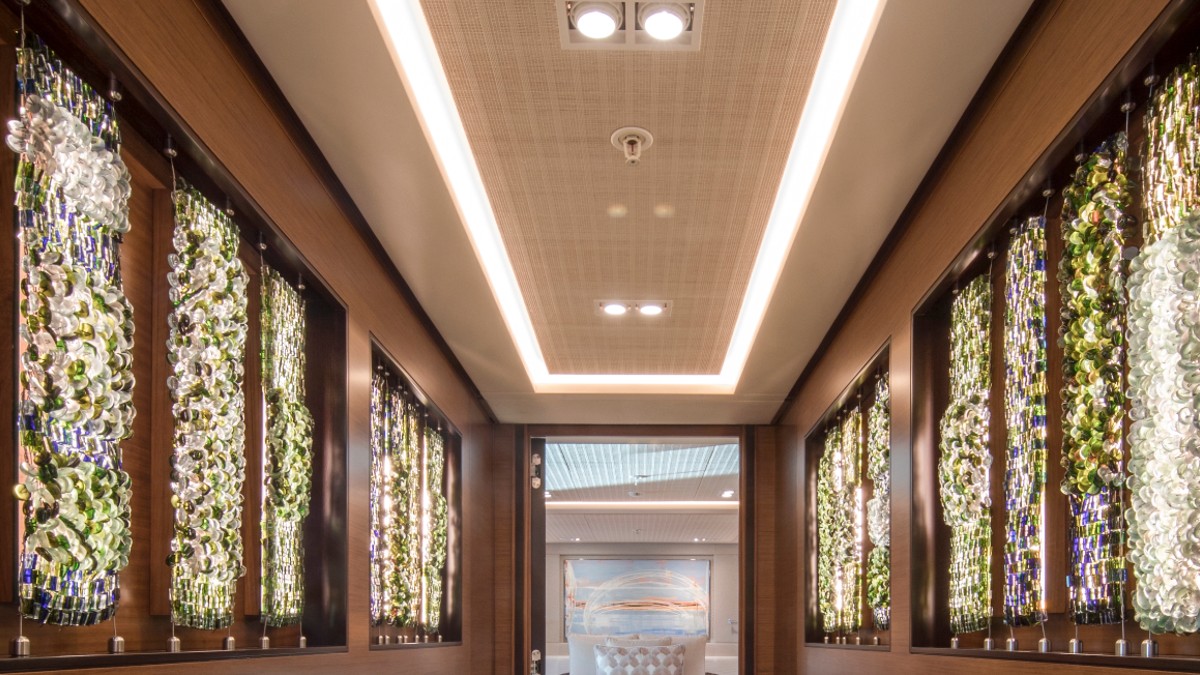
Art On Board
The hallway that leads to the owner’s cabin is lined with a mosaic tapestry made from sea glass woven together with wire. Backlit to create an unusual effect, it’s just one of the eclectic works of art that decorates the interior. The main salon also has a stunning and colorful work of glass art as another example.
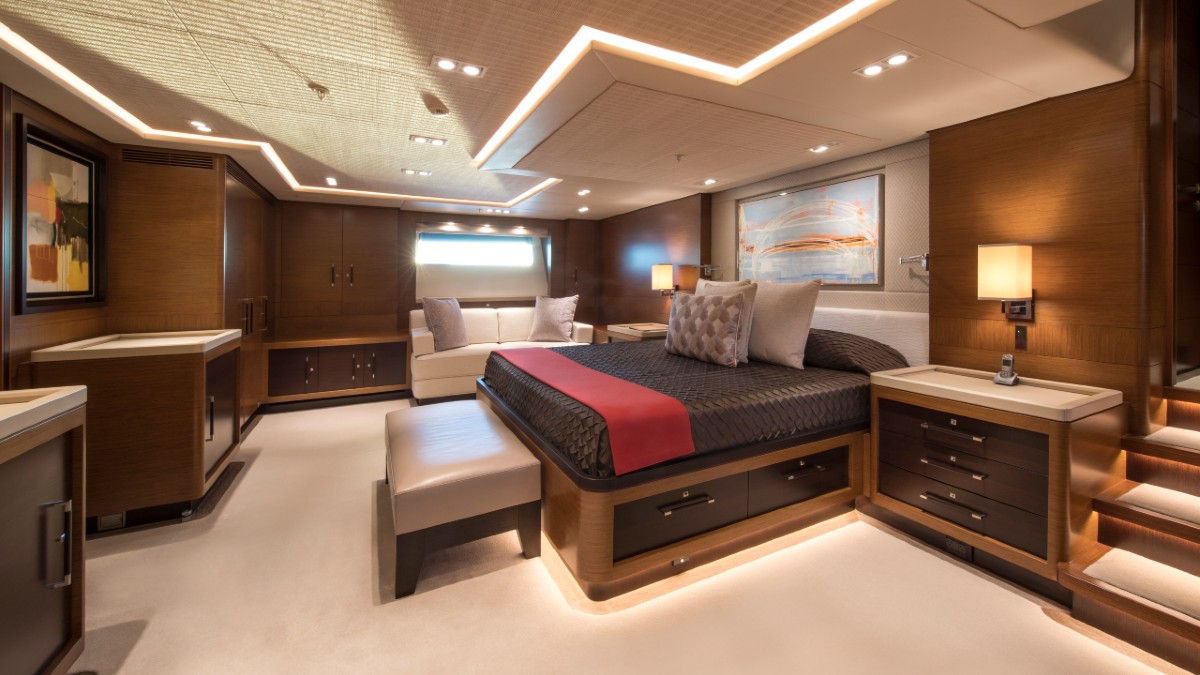
Interior Matters
Kokomo is not all tech features. The yacht’s modern interiors combine dark wood floors and calming cream furnishings start in the main salon and continue across the five guest cabins. Penned by British studio Redman Whiteley Dixon, the design carefully wraps around the lifting keel without sacrificing or impeding on any interior guest space. The yacht accommodates up to 10 guests in a master suite, VIP, one double cabin and two twins. There are other accommodations for up to 10 crew. On the foredeck, the Jacuzzi brings another element of outdoor entertainment, bolstered by a sunken cockpit.
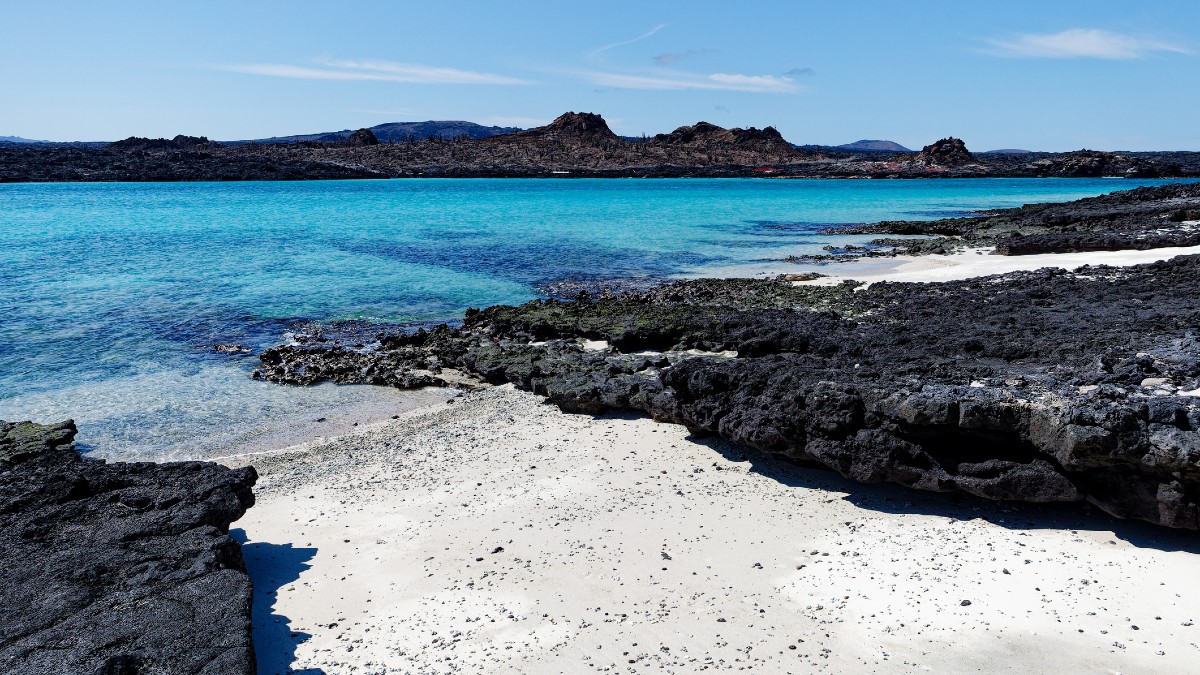
World Traveler
The mandate issued by Walker was to create a yacht that was a “quantum leap forward” from his previous yachts, with superior sailing characteristics and guest comfort. The mast’s height is too tall to sail through the Panama or Suez Canals, which meant it would have to be designed to sail around Cape Horn and the Cape of Good Hope to reach the Caribbean and Mediterranean. The maiden voyage took the yacht from the New Zealand shipyard to Australia, New Caledonia, the Solomon Islands, and Fiji. It also spent time at Walker’s private island (pictured above), also named Kokomo. The vessel has since spent many years exploring the Caribbean and Med. It’s based in both regions during the respective cruising seasons, with charters available through Cecil Wright.
More for You
Pro-Trump Lawyer's Arrest Sparks MAGA Fury
"Doesn't make sense what he's saying" - Kareem Abdul Jabbar sounded off on John Stockton for making athletes look like 'dumb jocks'
Margaritaville closing after 20 years
Ukraine drones 'attack' main base of Putin's long-range strategic bomber fleet deep inside Russia
Florida Gov. Ron DeSantis says 'next stop' for Haitians who land in Florida Keys may be Martha's Vineyard
Sydney Sweeney says she feels dehumanised when people sexualise her body: ‘I have no control’
Matt Gaetz's Effort to Boot Trump-Backed Nemesis Falls Flat
11 Outdated Design Trends That HGTV's Hilary Farr Is Over Seeing In Homes
3 underrated movies you need to watch in April 2024
Housing Market Sees Massive Shift: 'Very Disruptive'
Woman, 25, announces her own death from cancer in viral final letter: 'Do whatever makes you happy'
Elon Musk says society must move on from the ‘constant subject’ of racism: ‘We are all descended from slaves’
Rep. Lieu accuses Trump of lying about not being able to pay $464M judgement; Mark Cuban says he's wrong
A coal billionaire is building the world’s biggest clean energy plant and it’s five times the size of Paris
Amid Backlash, Jonathan Glazer Finds Some Public Support In Hollywood & From Auschwitz Memorial Director
The Red Sea shipping crisis has given an unexpected country's elite commandos a chance to shine
Slave memoirs yanked the veil off of America’s facade
Former NHL player Chris Simon dies by suicide at 52 and CTE is suspected in his death, family says
Democrats in denial on crimes of illegal immigrants. Here's the reality the rest of America can't ignore
Opinion: Trump’s dangerous $600 million problem

IMAGES
VIDEO
COMMENTS
Freya 39. Wylo 2. Tradewind 33. Endurance 50. Frances 26. Mason 44. Westsail 32. Hans Christian 52. First of all let's have a look at why you should even be preferring full keel sailboats to a more traditional, widespread classical fin keel design.
That full keel stops a lot of roll and motion in the anchorage. Small fin-keeled boats thrash and roll violently when a big wake hits an anchorage, only the bigger, heavier boats are spared. But with a full keel you'll roll like a boat twice your size, spill a lot fewer drinks, and sleep better. 5. Less Draft as Other Designs (but As Stable)
The full keel is the oldest style of keel, used since the earliest sailboats. A full keel is integral to the hull and runs the entire length of the under-body of the boat. The rudder is hung at the end of the keel if it's not transom mounted. Most "full keel" boats from recent decades are modifications of the centuries-old full keel.
Full Keel Advantages: Handles better in tough weather. Better directional stability. Maneuver well in downwind conditions. Better for offshore sailing and ocean passes. Their movements are softer to be more in tune with the movement of the sea itself. Since the full keel runs through the entire hull, the forces exercised on it are transferred ...
The most common sailboat keel types are full-length keels, fin keels, bulb keels, wing keels, bilge keels, and lifting keels. Full keels are popular among cruisers, while fin keels are generally used for racing. Bilge keels and lifting keels are typically used in tidal waters, on small fishing boats for example.
The standard keel on our yachts is a fin keel. Most sailing boats today use a fin keel because it gives a good all-round performance on all points of sail. By keeping the ballast lower it gives the most comfortable motion. The main downsides are that the draught (the depth of water required to stay afloat) is the greatest, and it's very ...
The Rustler 57 has the option of being fitted with a lifting keel. Its 2.0 (6ft 8in draft makes her a more versatile cruising yacht. In the centre of the keel is a bronze fin that has a chord as wide as the depth of the lead stub. When the blade is retracted, the yacht only draws 2.0m / 6ft 8in and she still sails well.
The full keel is one of the most common types of the keel that you are likely to see on a sailboat. A full keel runs from end to end of the boat lengthways. A full keel, as the name implies, runs almost the entire length of the boat. At a minimum, it must run 50% of the length of the boat.
Keel bolts and the infamous garboard seam are completely eliminated. This approach to sailboat keel design dates back to the Rhodes Bounty II and other prototypes in the production world of sailboats. Now over 50 years old, many of these boats continue to have a tenacious grasp on the lead or iron that they hold.
The six types of motion are: 1) roll; 2) yaw; 3) pitch; 4) surge; 5) sway; 6) heave. The cutter sail plan, driving the full keel hull, truly offers the most customizable blend of characteristics to harness the dynamic realm of ocean sailing. View fullsize. The SV Solstice (Cape George Cutter 31), co-designed, built, and owned by Paul Exner is ...
This type of lateral plane is still sailing in many popular older designs such as the Albergs, the Folkboat, the Luders 33, the Whitby 42, and even some newer yachts. The modified full-keel form features generally good handling and directional stability plus reduced wetted surface, compared to her true full-keel sister.
Arcona 435. The Performance Cruiser winner at the 2019 European Yacht of the Year awards, the Arcona 435 is all about the sailing experience. She has genuine potential as a cruiser-racer, but her ...
Devlin Boats, Sailboats. The Lit'l Coot 18 Full Keel is a is seaworthy and capable motorsailor with enough space on board for the organized sailor and enough potential to keep serious travelers satisfied. She is the sister to the original Lit'l Coot with the same hull and the same tendency for balanced performance and maximal use of space ...
Vancouver 28. Photo credit: YachtFathom.co.uk. A sensible small boat with a "go-anywhere" attitude, this pocket cruiser was designed with ocean sailors in mind. One of the best cruising sailboats under 40 feet, the Vancouver 28 is great sailing in a small package. Hull Type:Full keel with transom hung rudder.
Island Packet builds distinctive, full-keel boats that have almost a cult following. They're solid glass, heavy cruisers that won't set any speed records but will get you there in safety and comfort. ... The saloon has the space of a much bigger boat and there's a full-sized nav station which is perfect for long-distance cruising. Valiant ...
How keel type affects performance. James Jermain has tested hundreds of yachts in his 30 years as Yachting Monthly's chief boat tester. The performance and handling of a yacht depends on many things, but perhaps the most important single feature is the shape of the hull and the profile of the keel. Over the years hulls have become shallower ...
The Frances 26 is a 1980s Chuck Paine designed double-ender. This eye-catching small double-ender was designed by Californian Chuck Paine in the mid-1980s but built in the UK by Victoria Marine. It's an ideal short-handed boat, with accommodation to match, along with sufficient displacement to give the solid feel that many long-keel ...
The Irwin is known as a blue water boat with exceptional sailing capability. It is quicker than most full keel boats.The long-keel design ensures a comfortable ride at sea, and the center cockpit layout allows for an extremely roomy and useful live aboard arrangement for cruising. Soon more pictures and specs...
She is one of the most sea-kindly monohulls out there with a full keel, a 3.55m beam and a well-balanced sail plan. Most Tayanas are cutters, but a few ketches were built too. Ryan and I cruised our Tayana 37, Skua, around the Mediterranean and from Europe to the Caribbean between 2018 and 2020.
Location: PORTUGAL. Posts: 30,556. Images: 2. Re: New Traditional Full Keel Sailboats. How about a Vertue.. Bossoms Boatyard has the exclusive rights to build the GRP version of this classic long keel ocean sailing yacht, which is designed and constructed for serious and short handed ocean voyages. Attached Thumbnails.
Actual "Full keel" sailboats are rare among modern designs. These would be boats where the the line from the stem is a single curve to the full draft that then continues aft. More often, what people call "Full keel" boat presently are those with a double curved line from the stem; coming back shoal for as much as a quarter to third of the boat's length and then dipping down to the full draft ...
The 13 most popular swing keel sailboats that you may find worthy to consider are the following: Catalina 22, MacGregor 26, Hunter 22, Precision 23, O'Day 22, Beneteau First 235, Seaward 25, Islander Bahama 24, Watkins 27, Com-Pac 23, Montgomery 17, San Juan 23, and West Wight Potter 19. The estimated pricing for the boats with swing keels ...
The swing keel certainly doesn't make the Pearson 35 a shoal-draft sailboat. It has a modified full keel which (with the swing keel retracted) draws 3 feet 9 inches. With the additional swing keel down, the draft of the Pearson 35 increases to over 7 feet. The Pearson 35 is a heavy boat with good sea keeping abilities.
Kokomo was only the second yacht to be fitted with a lifting a keel, the first being 246-foot M5 (ex-Mirabella V), the world's largest single-masted sailing yacht. This innovative design ...